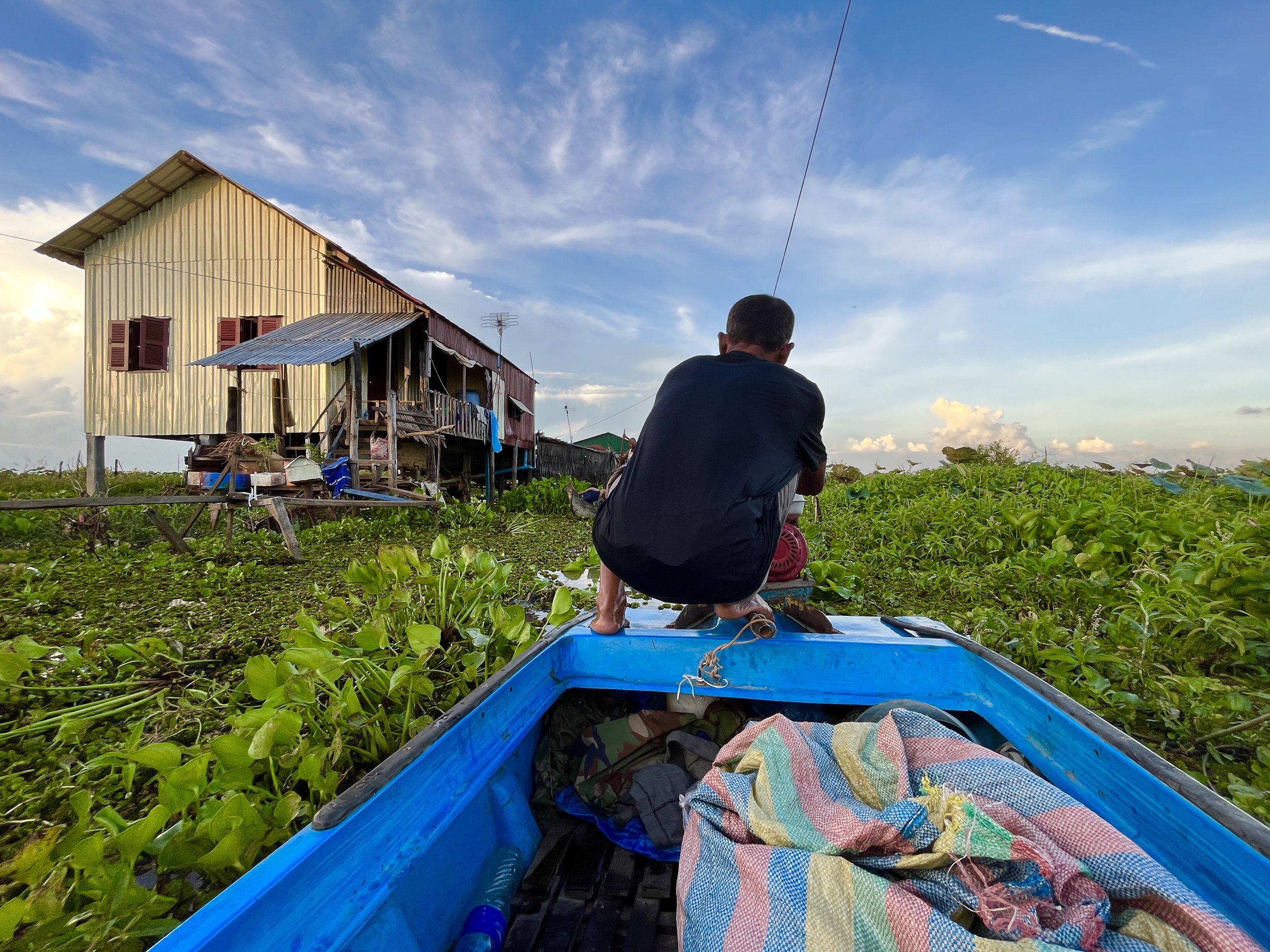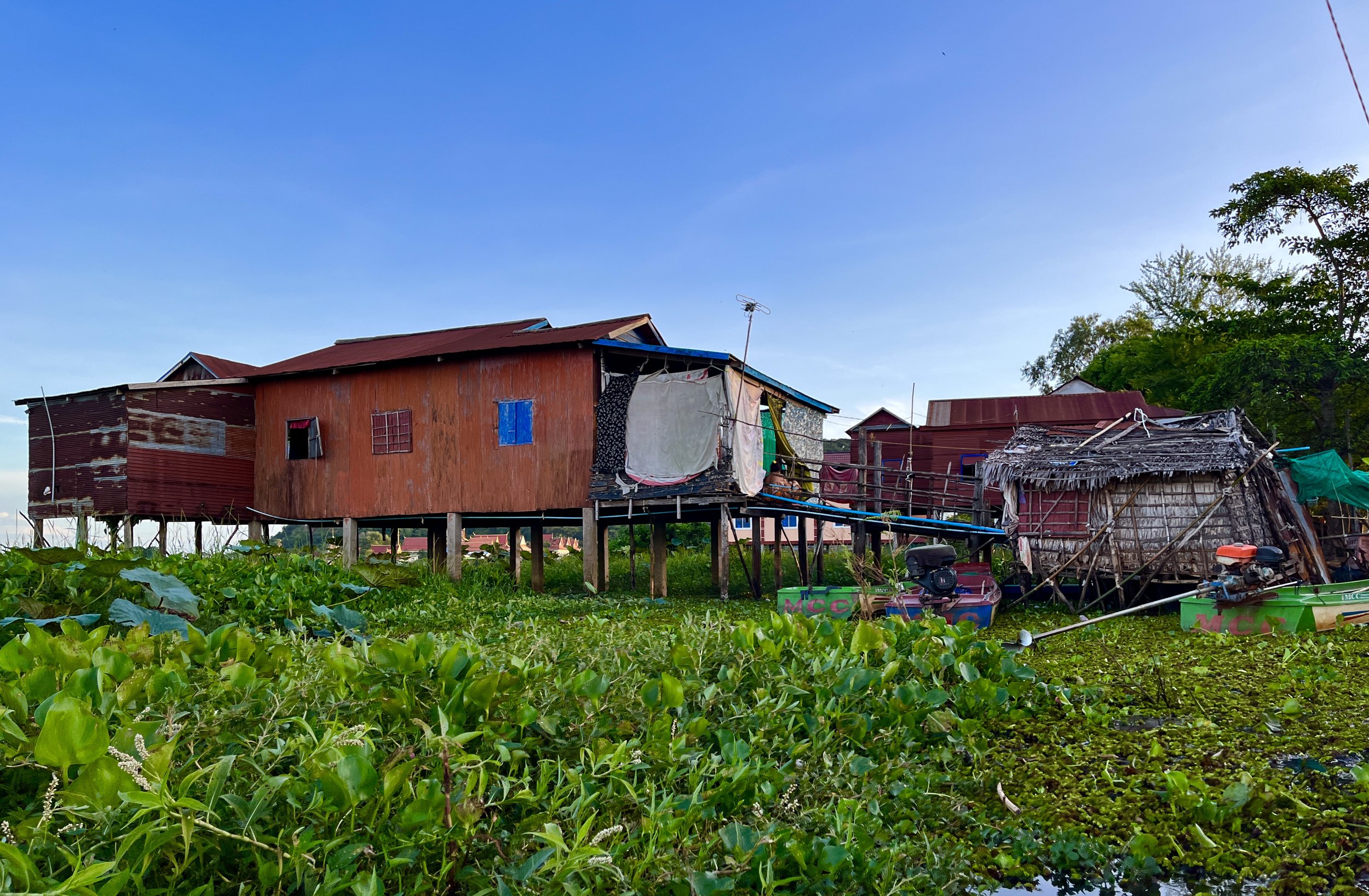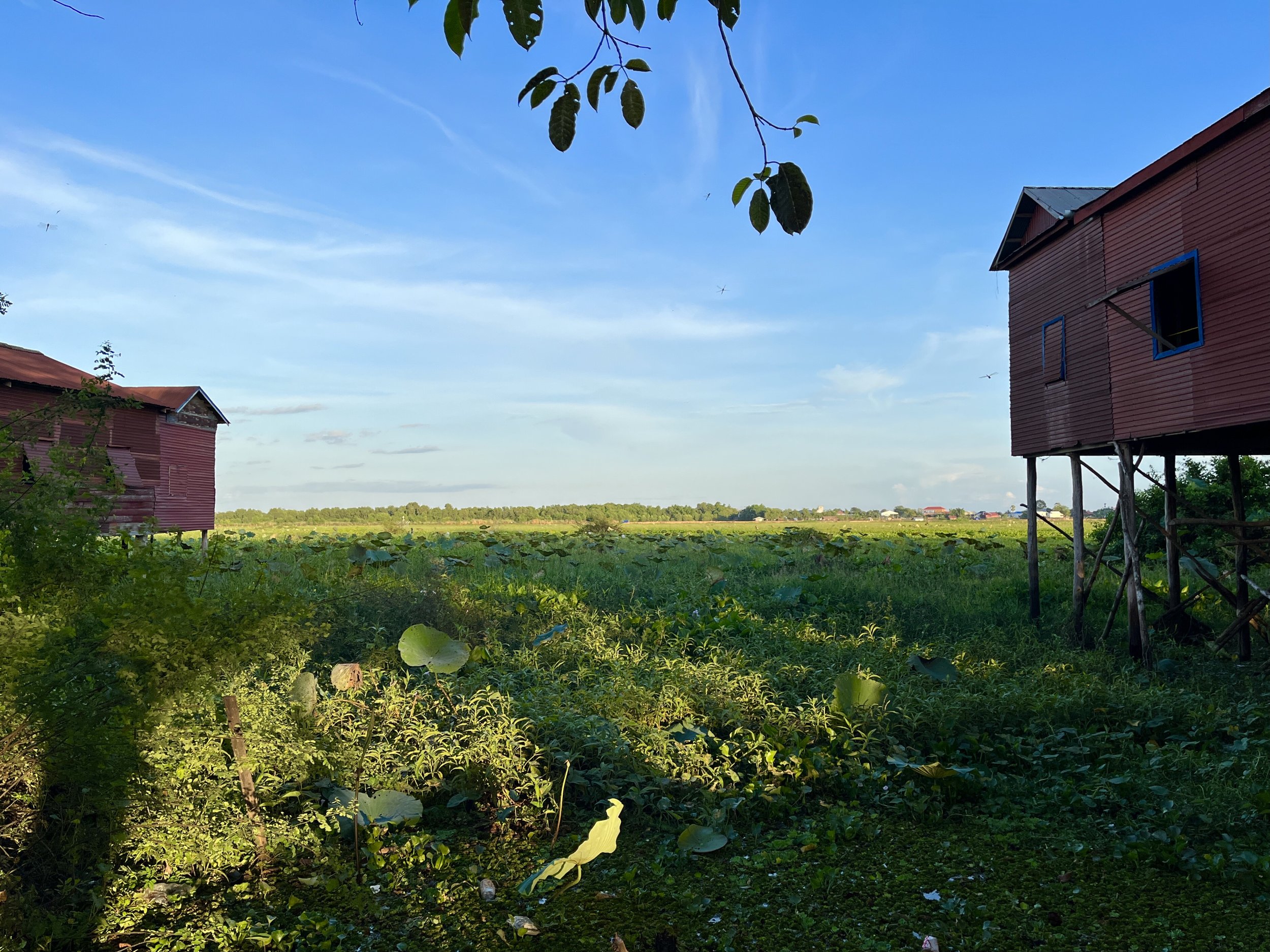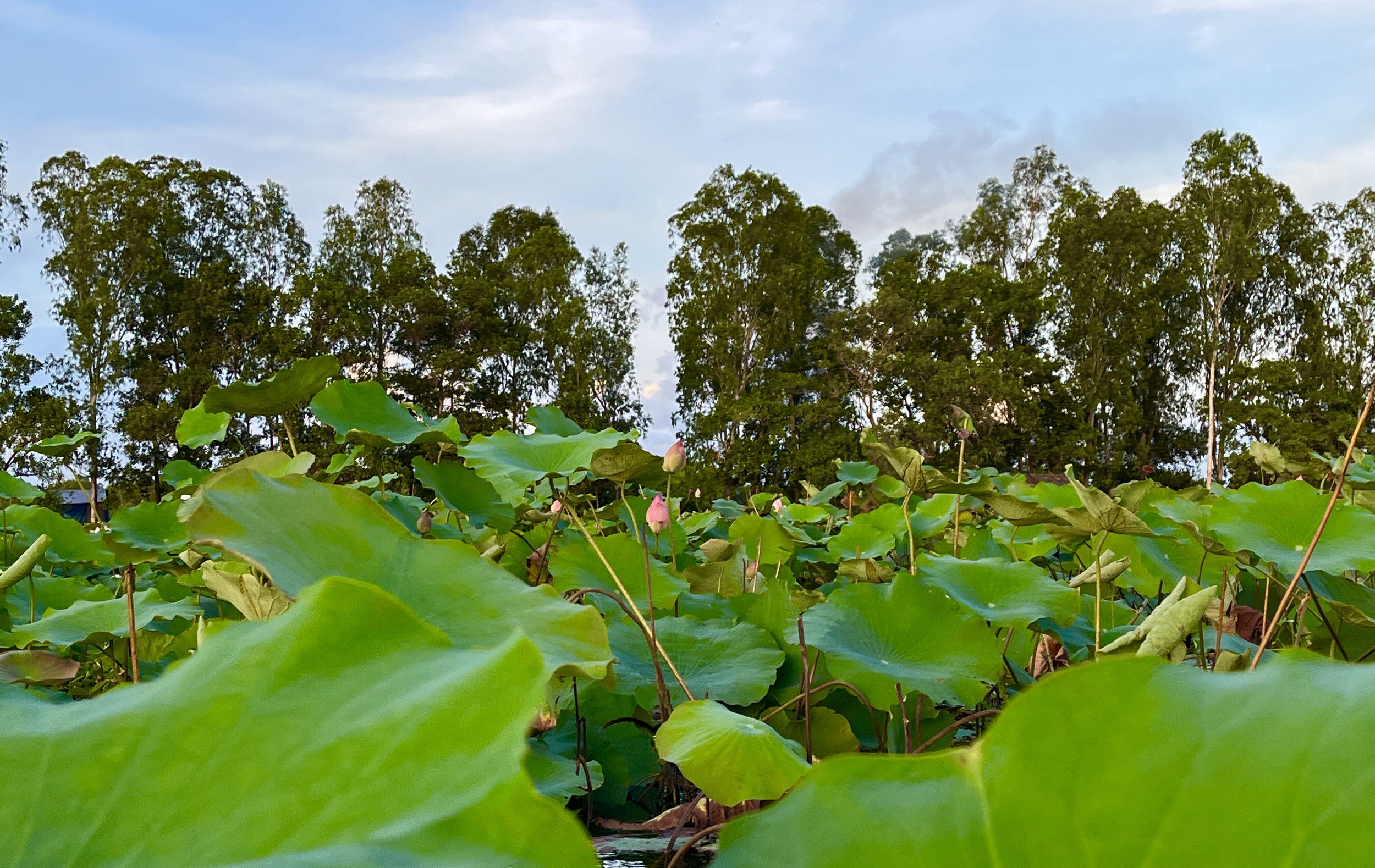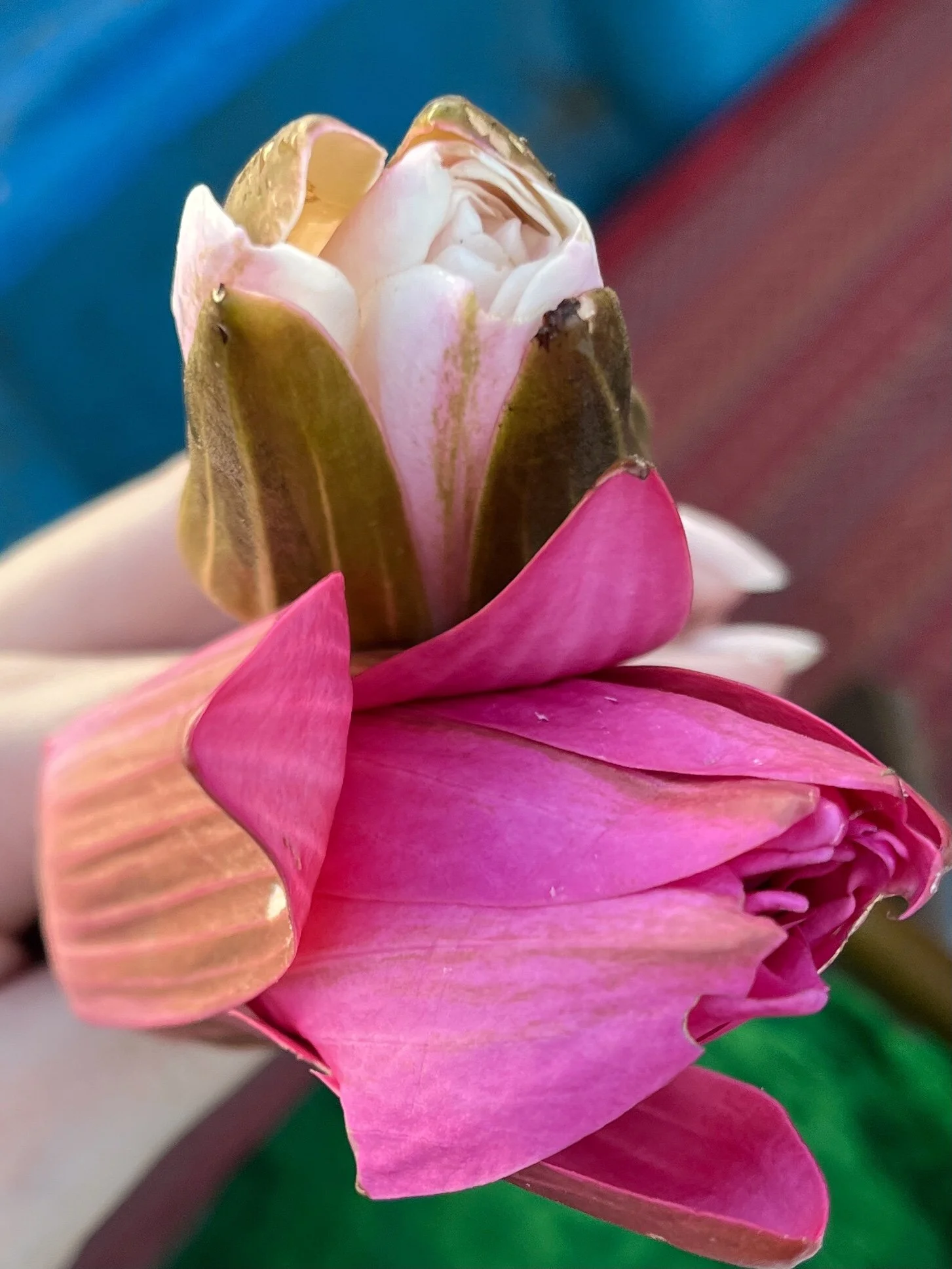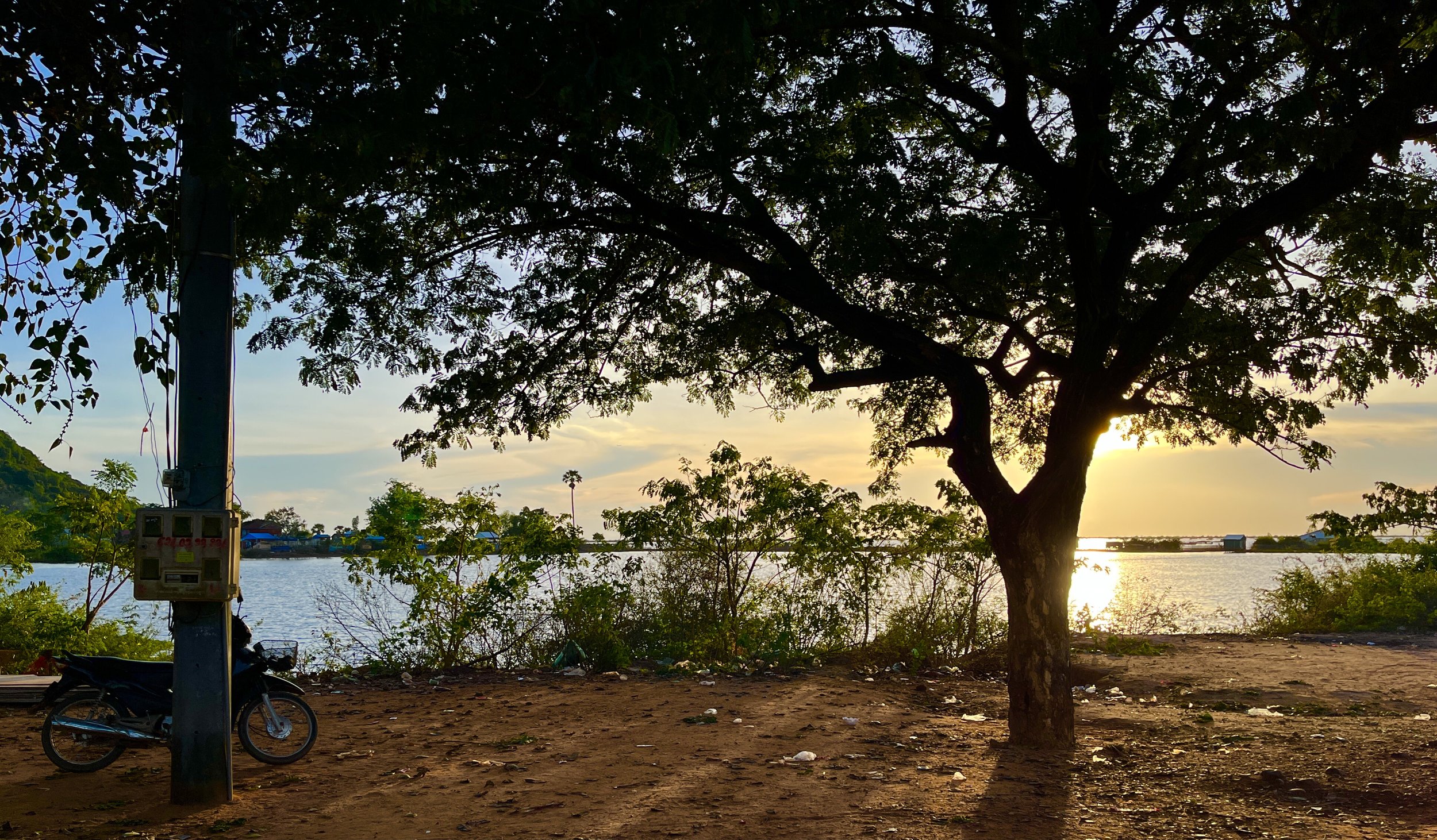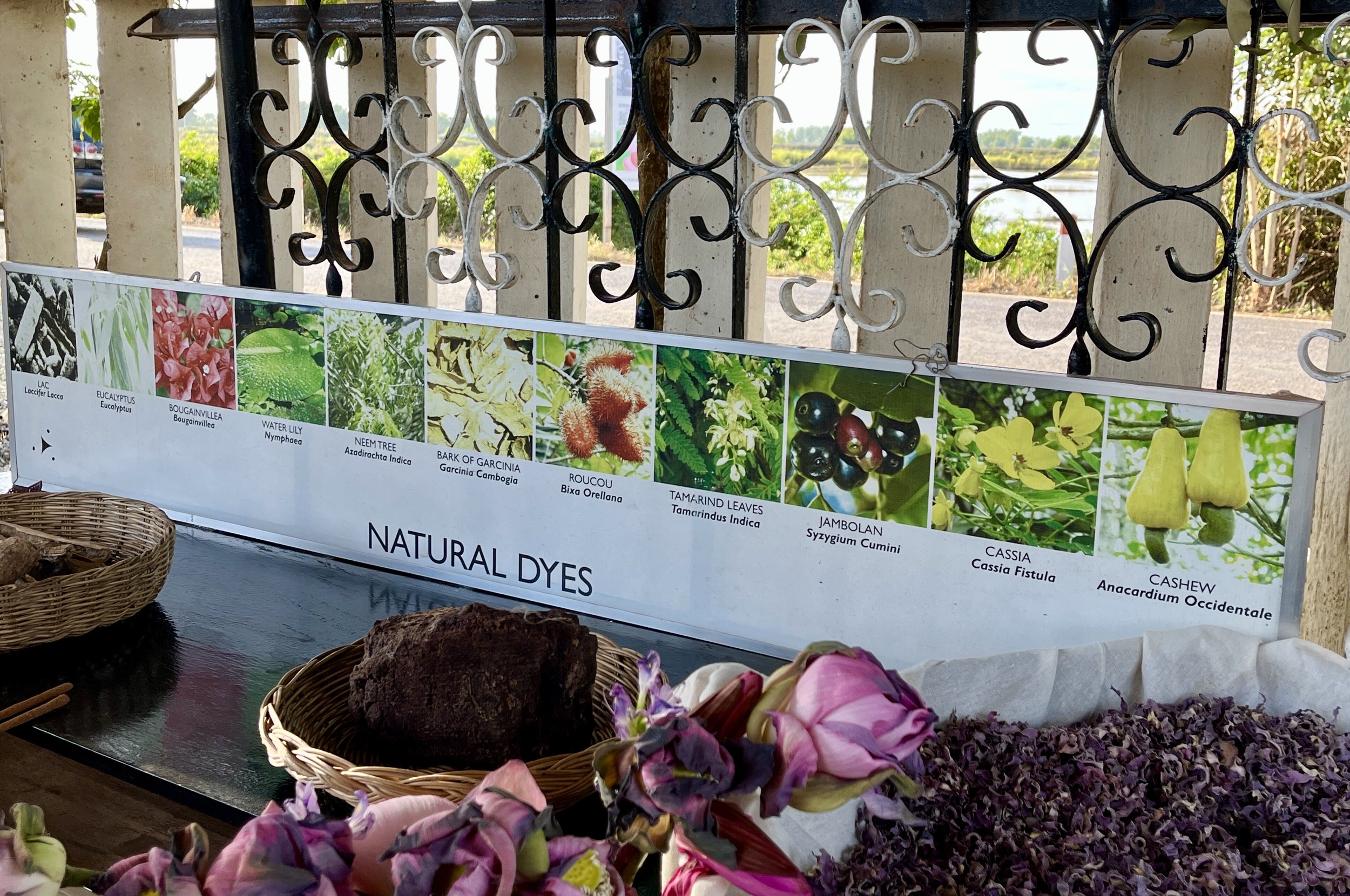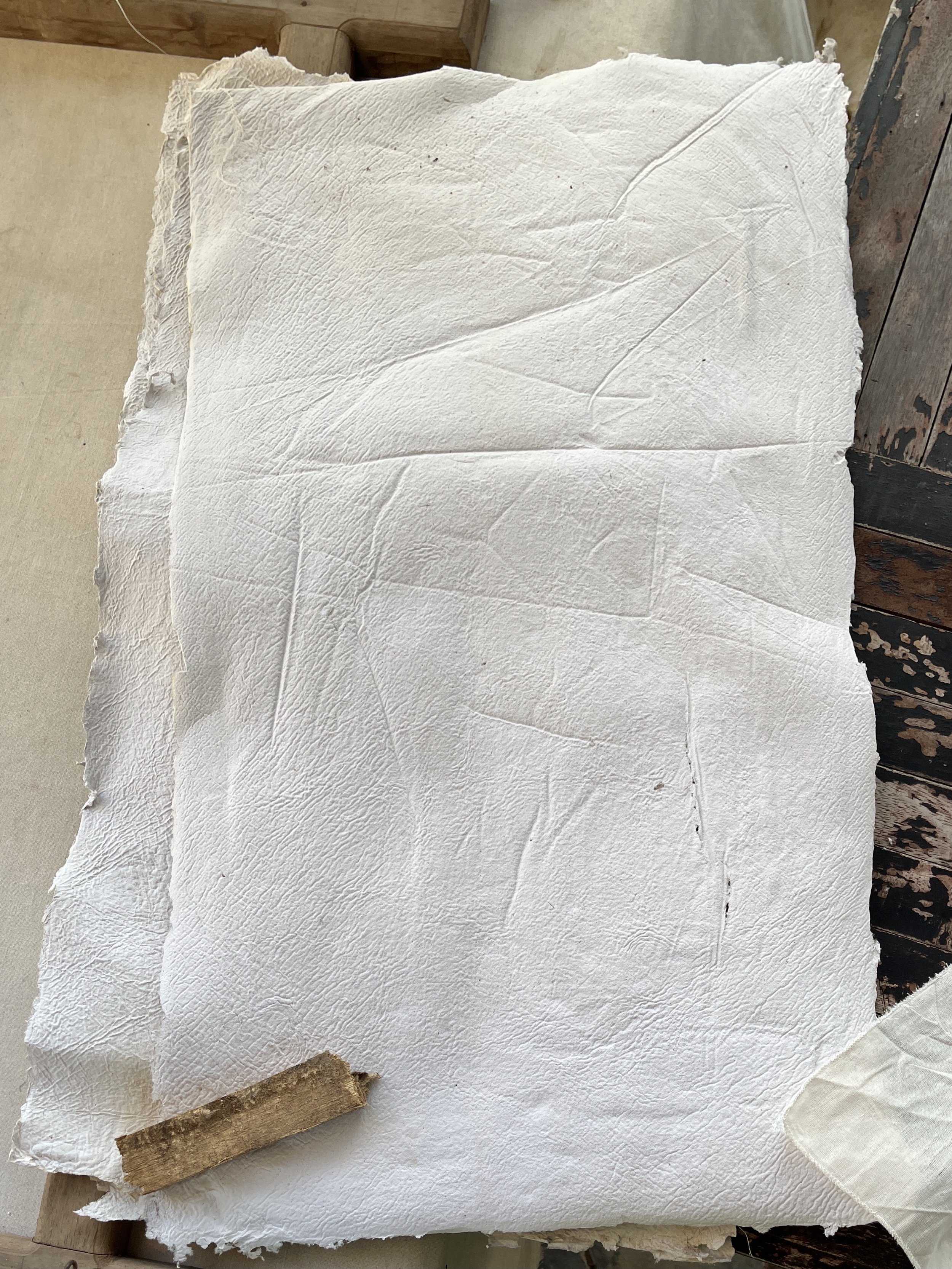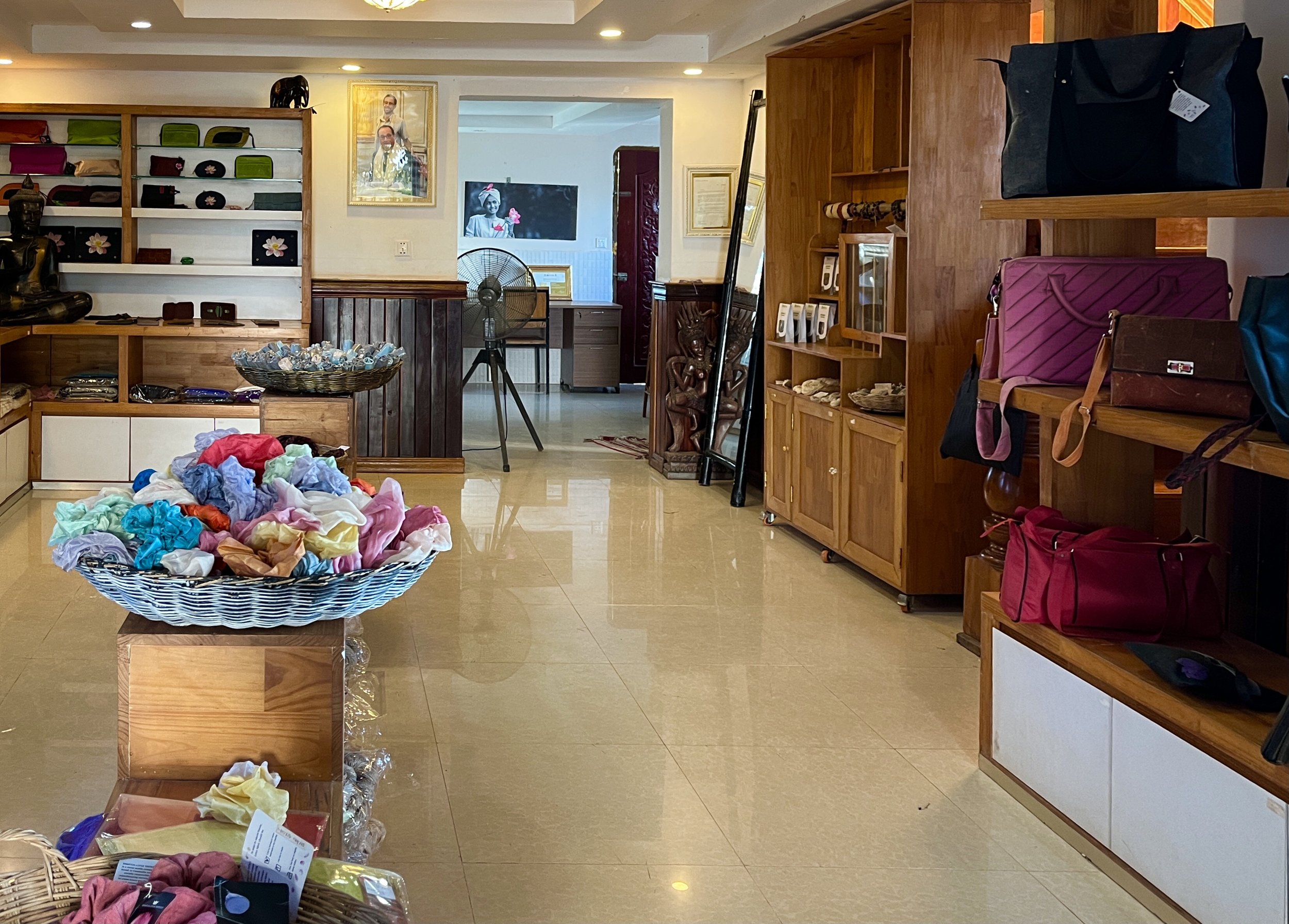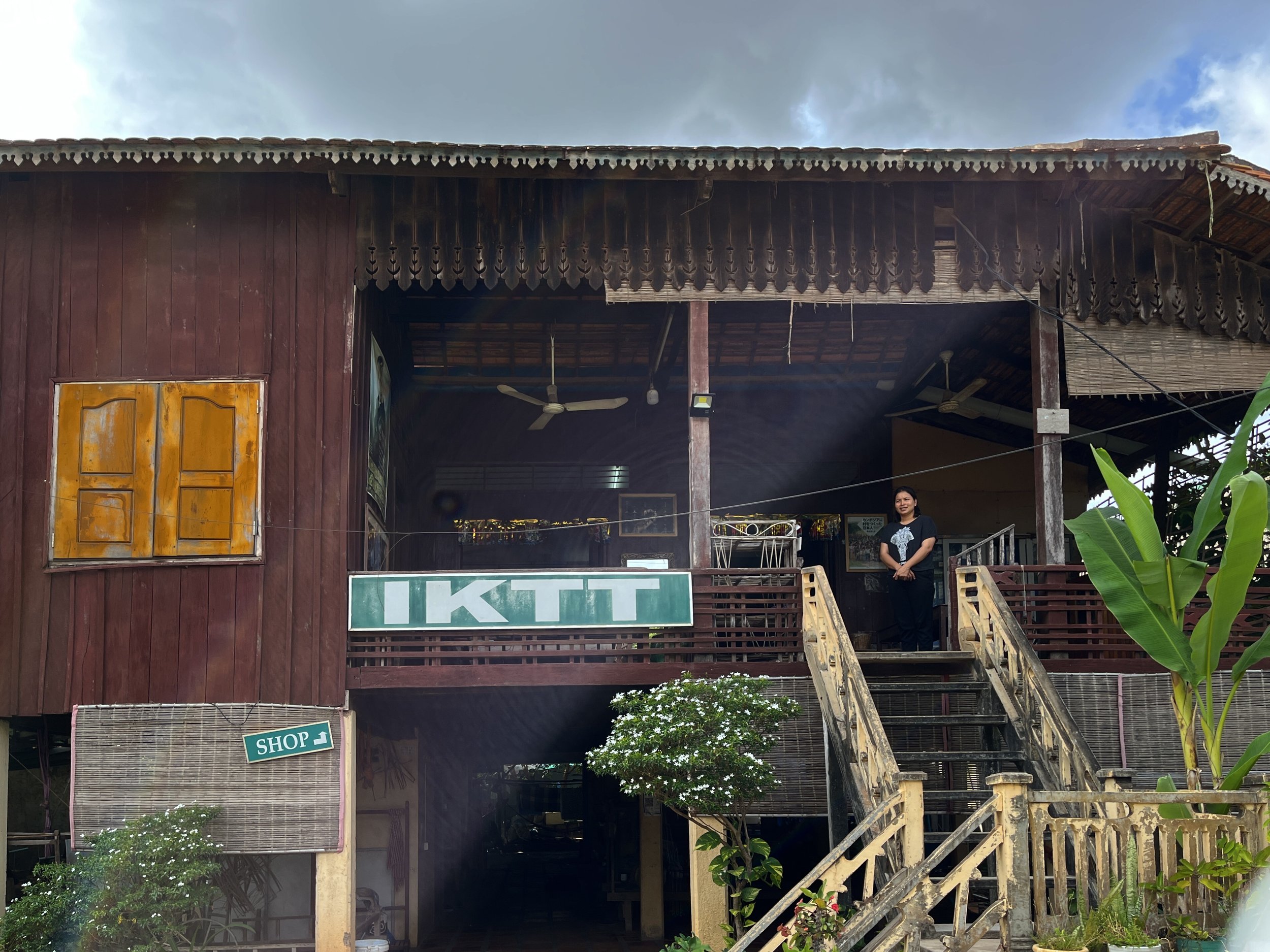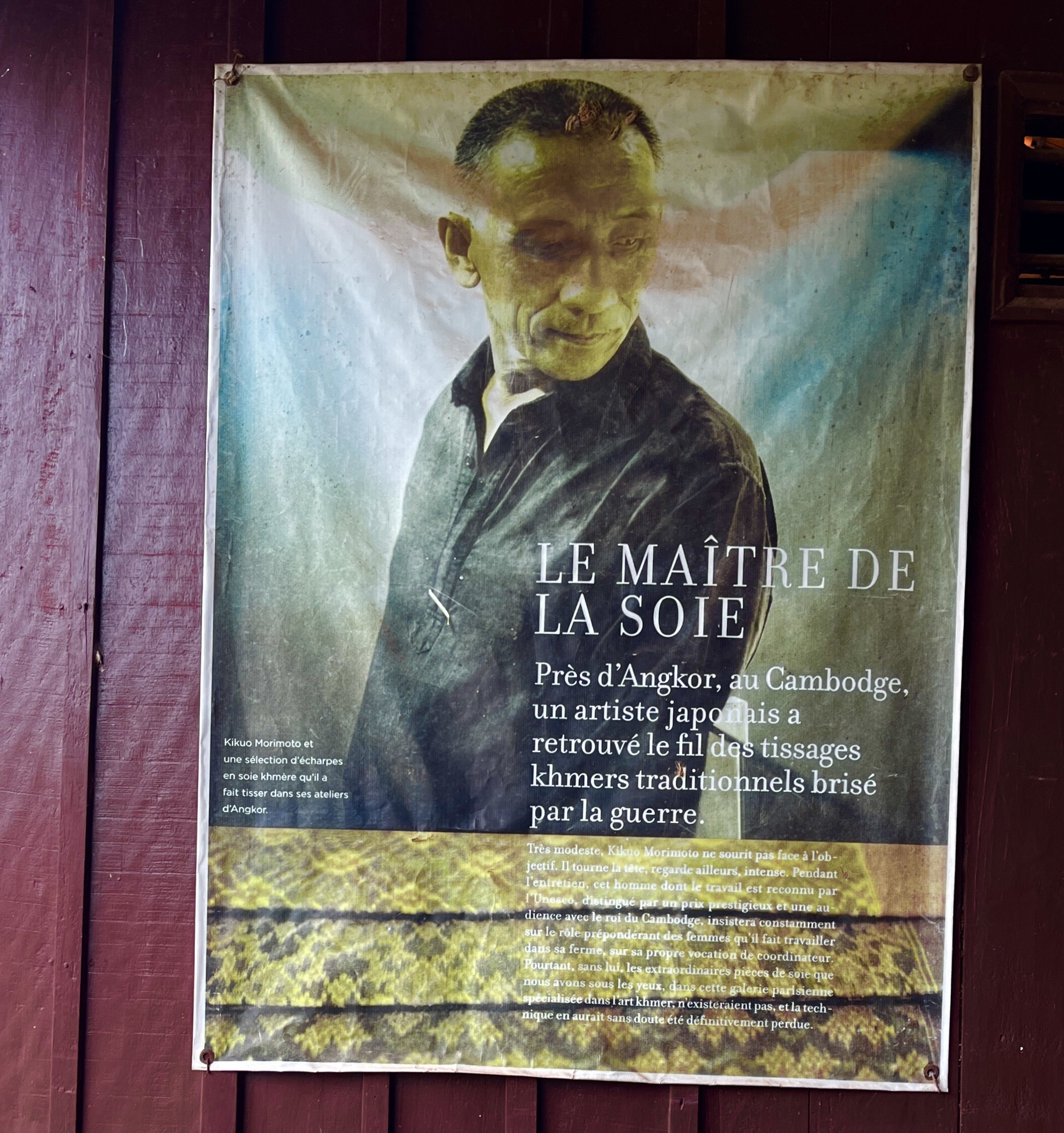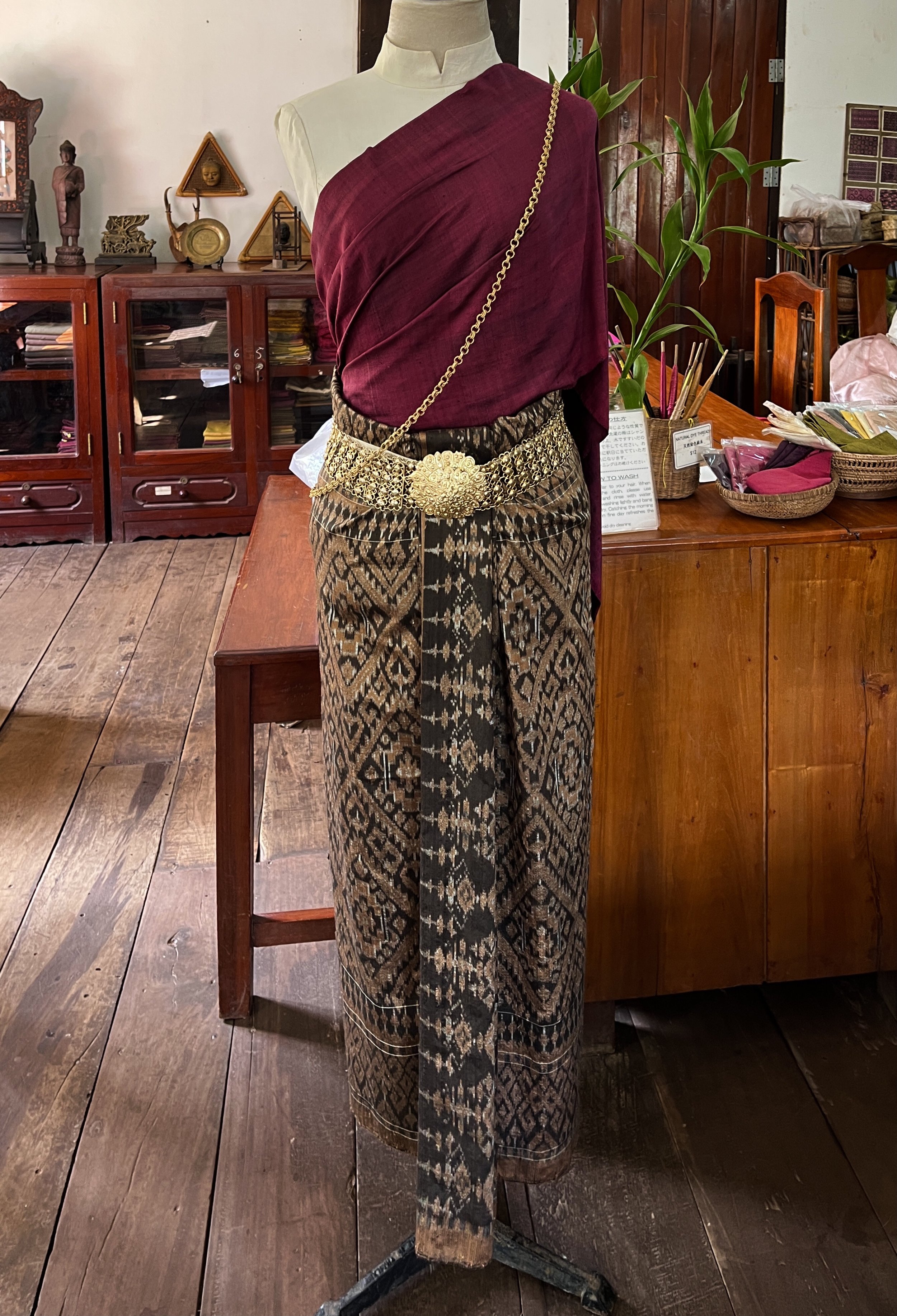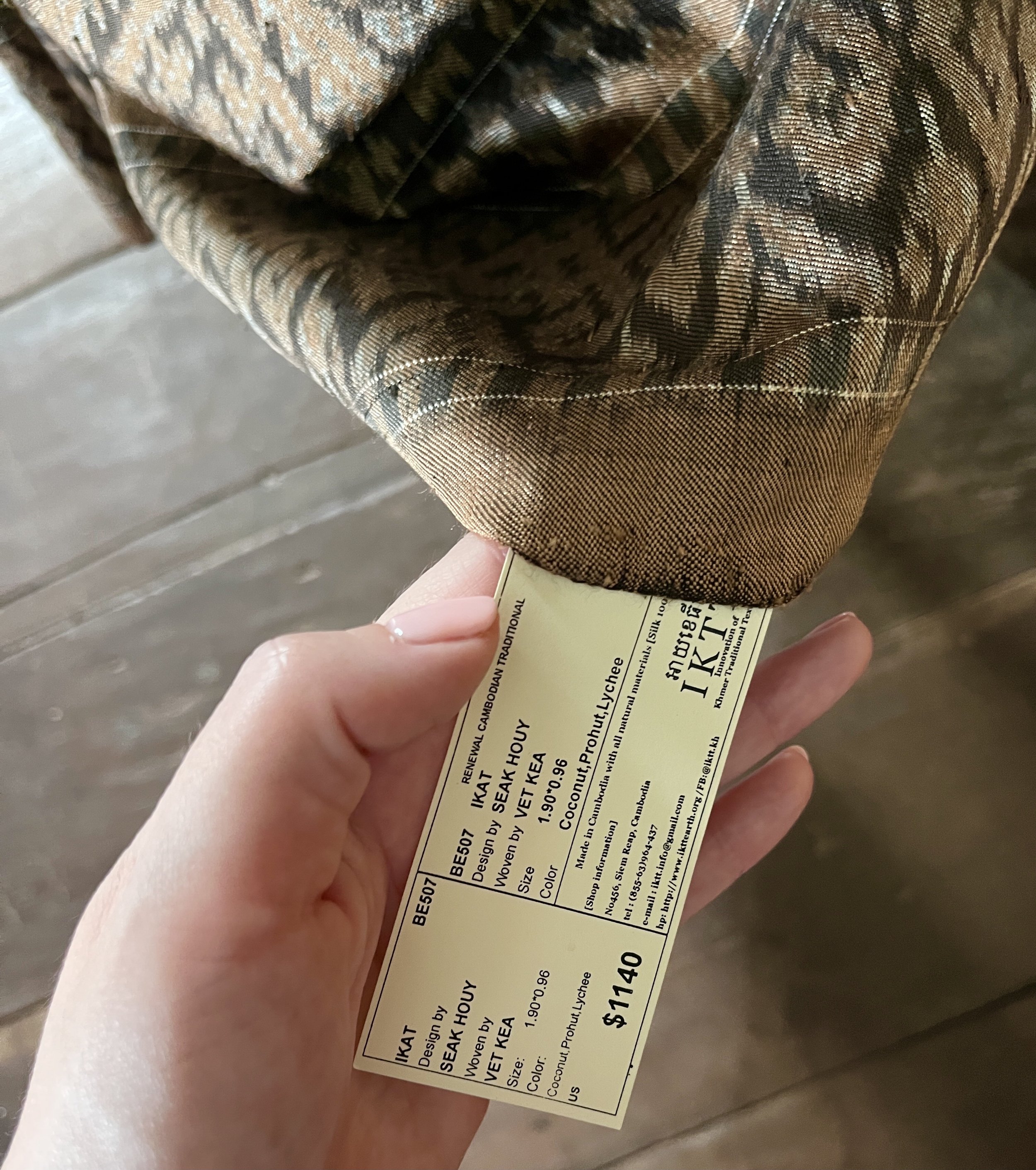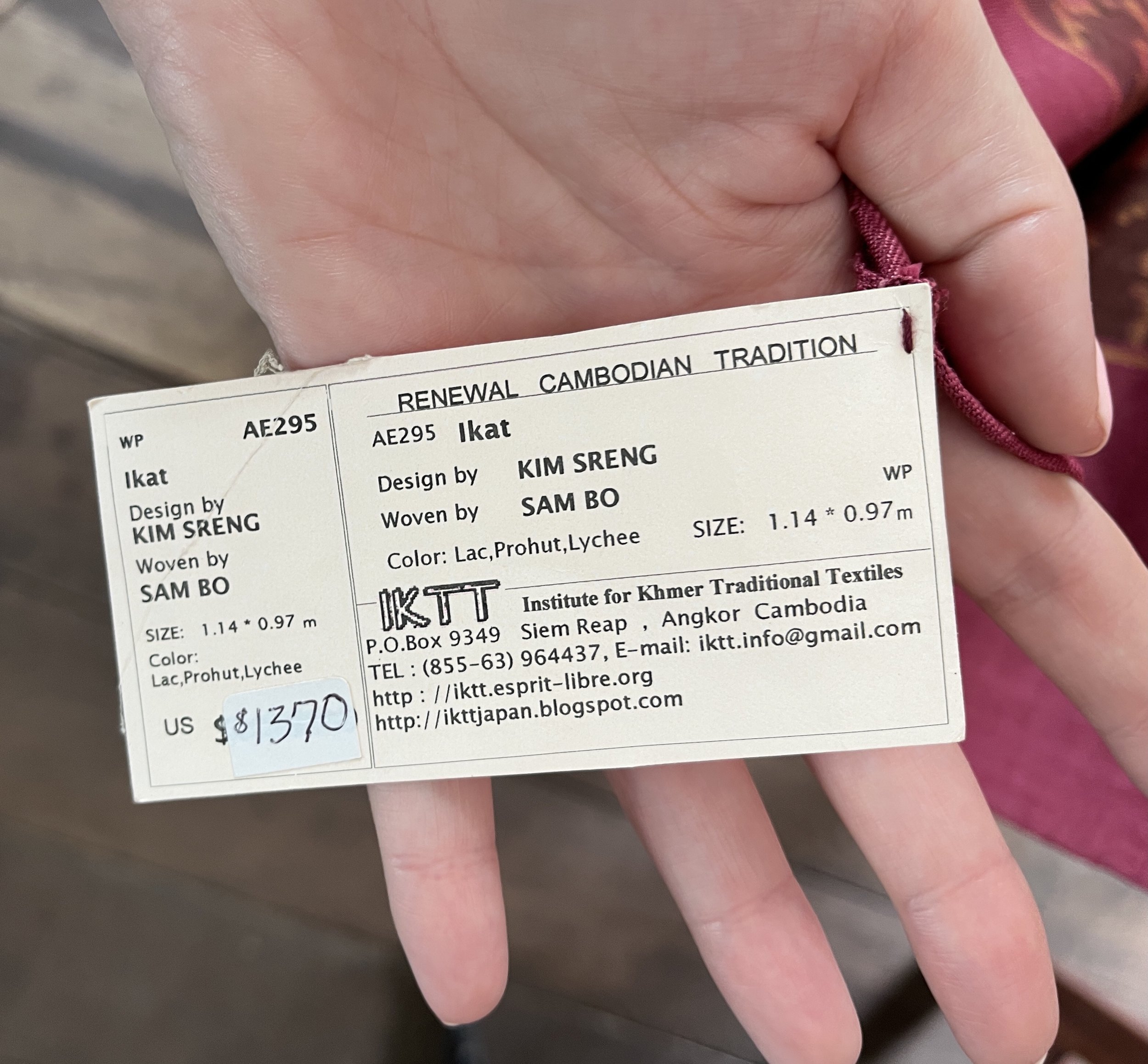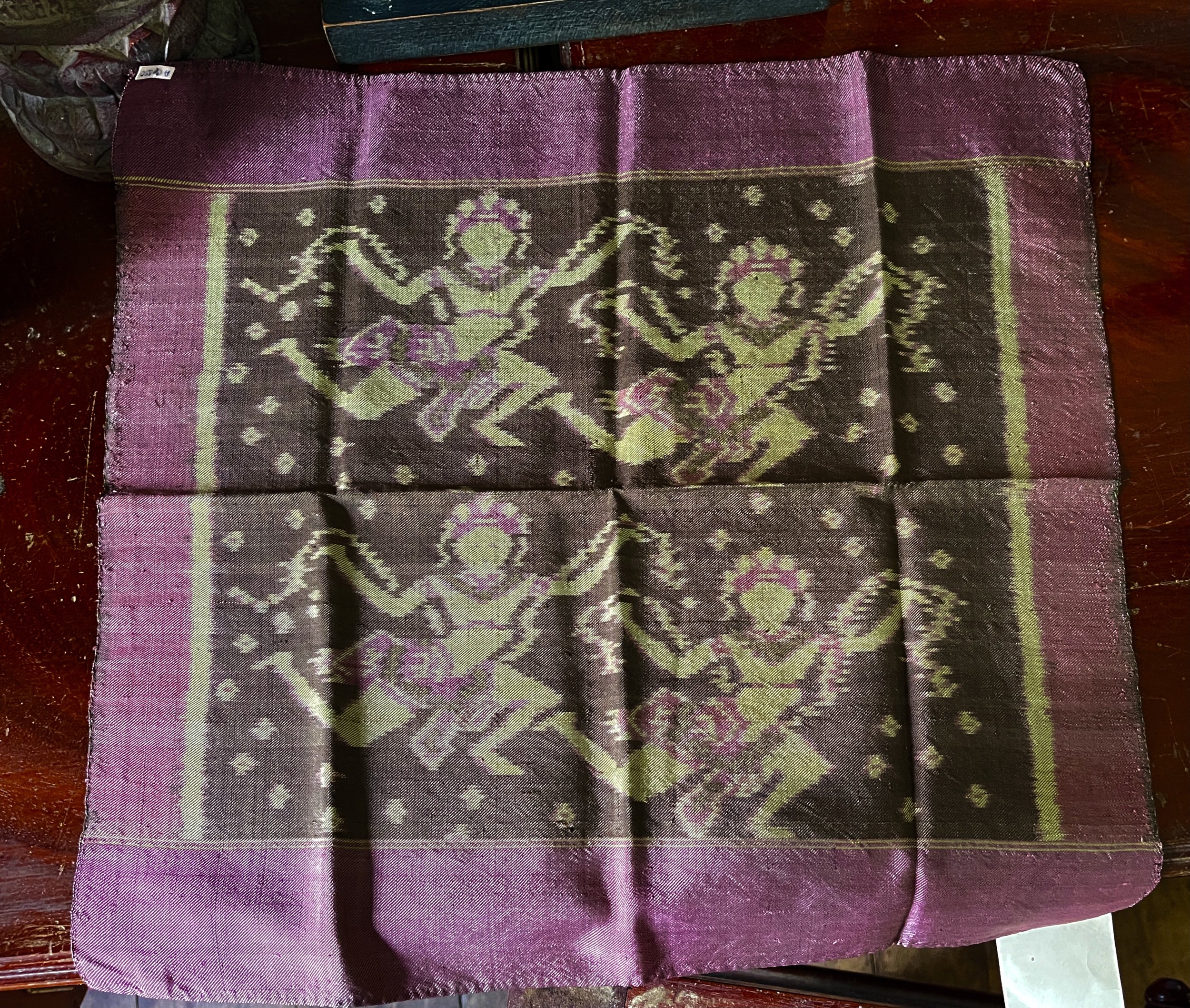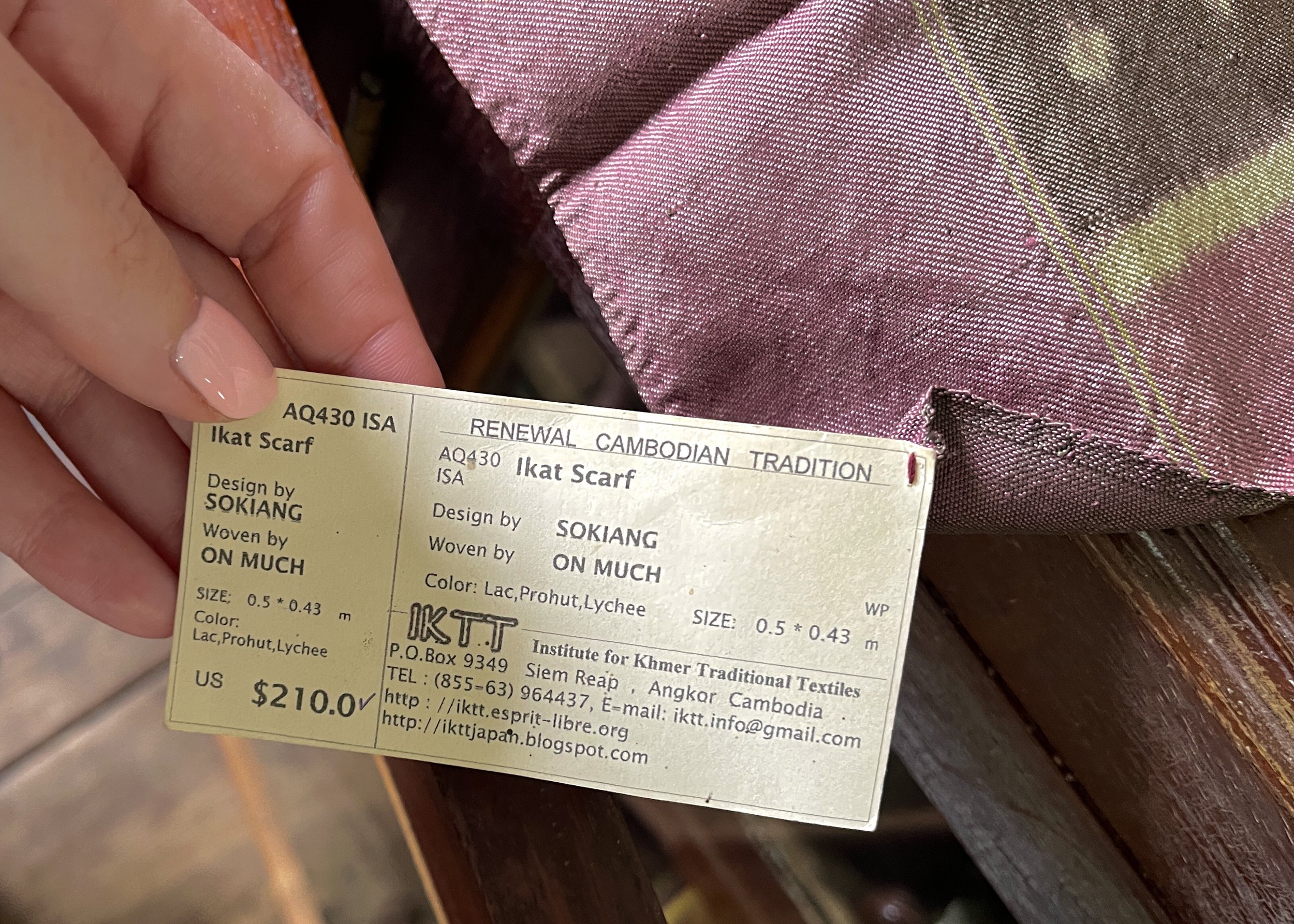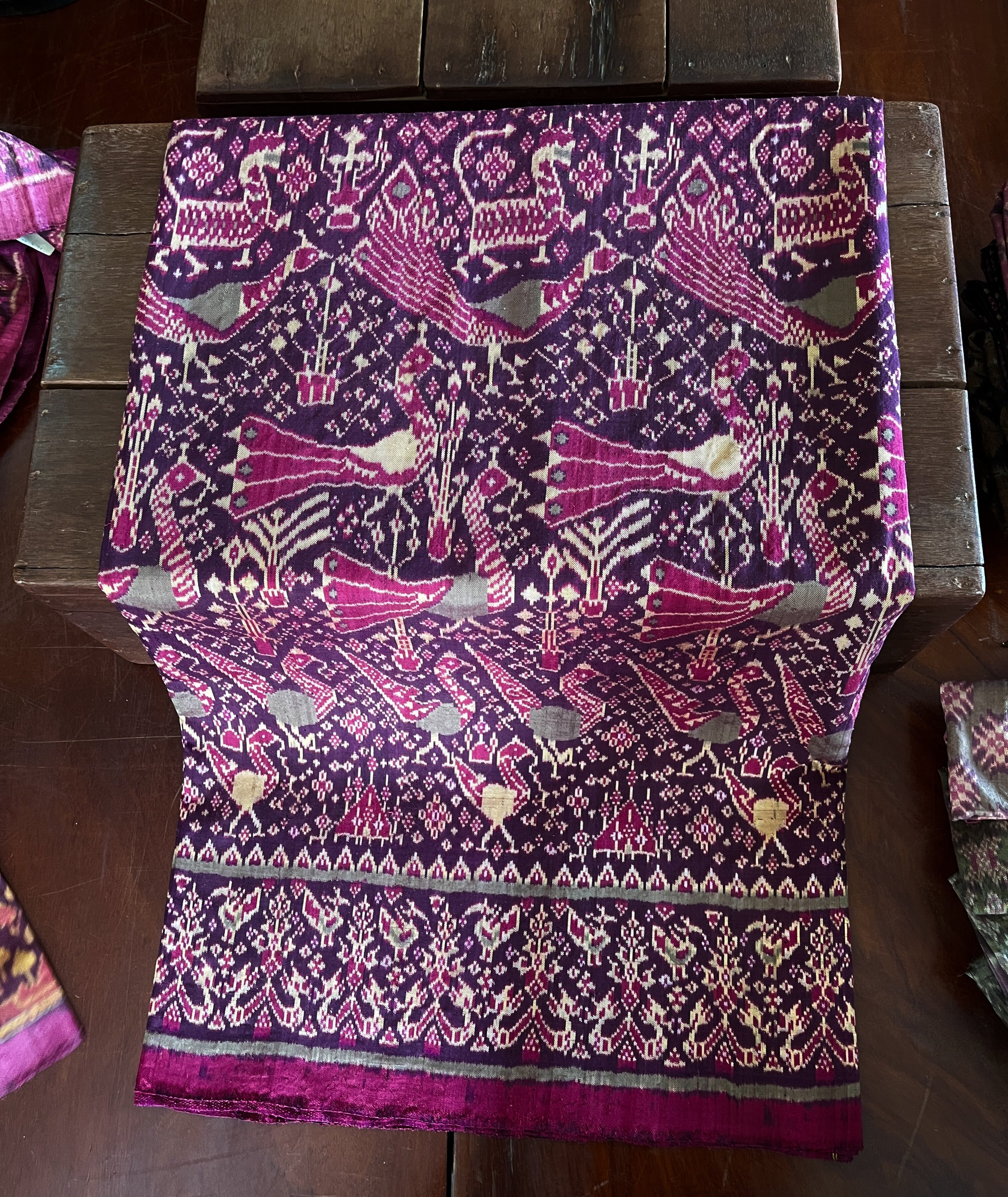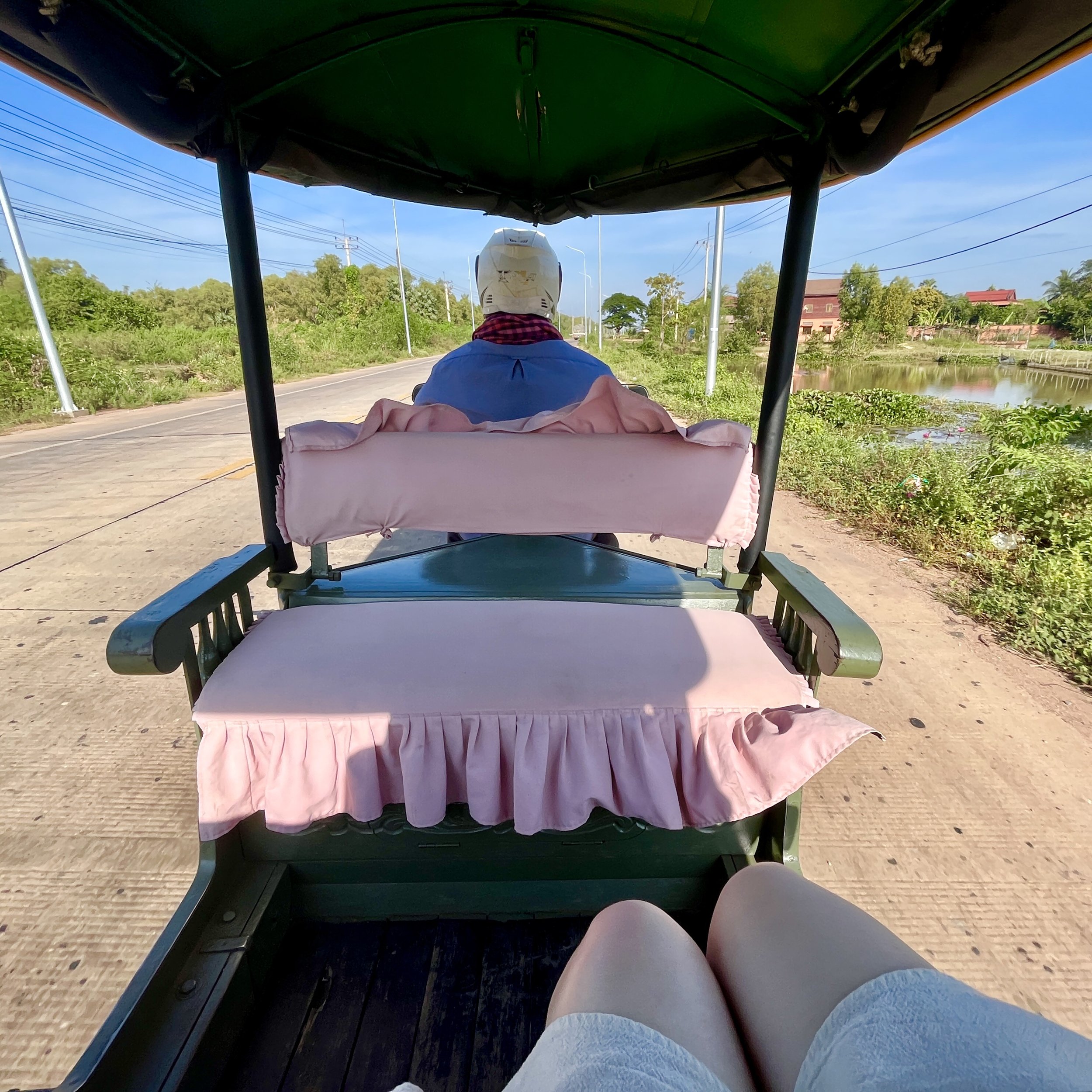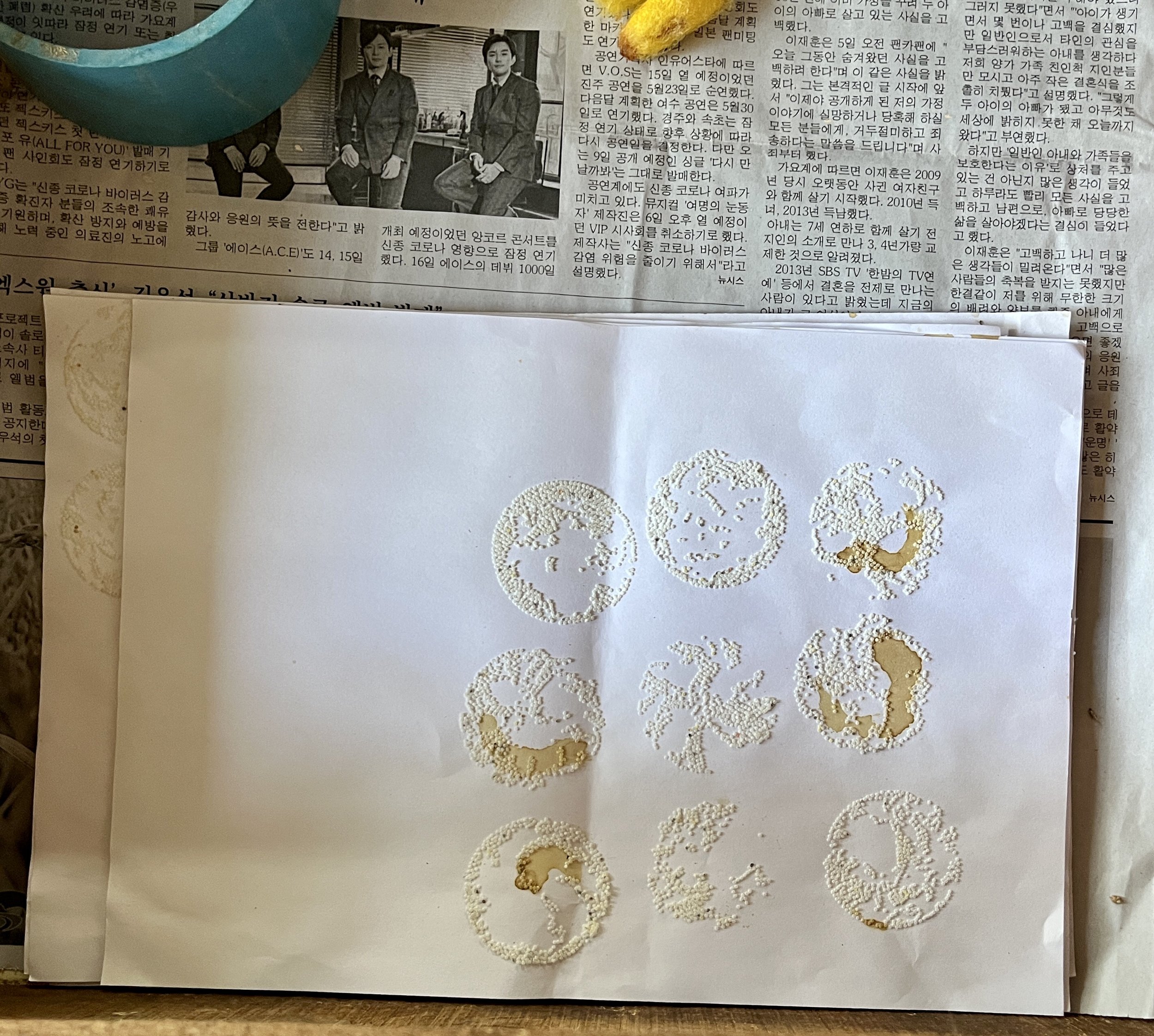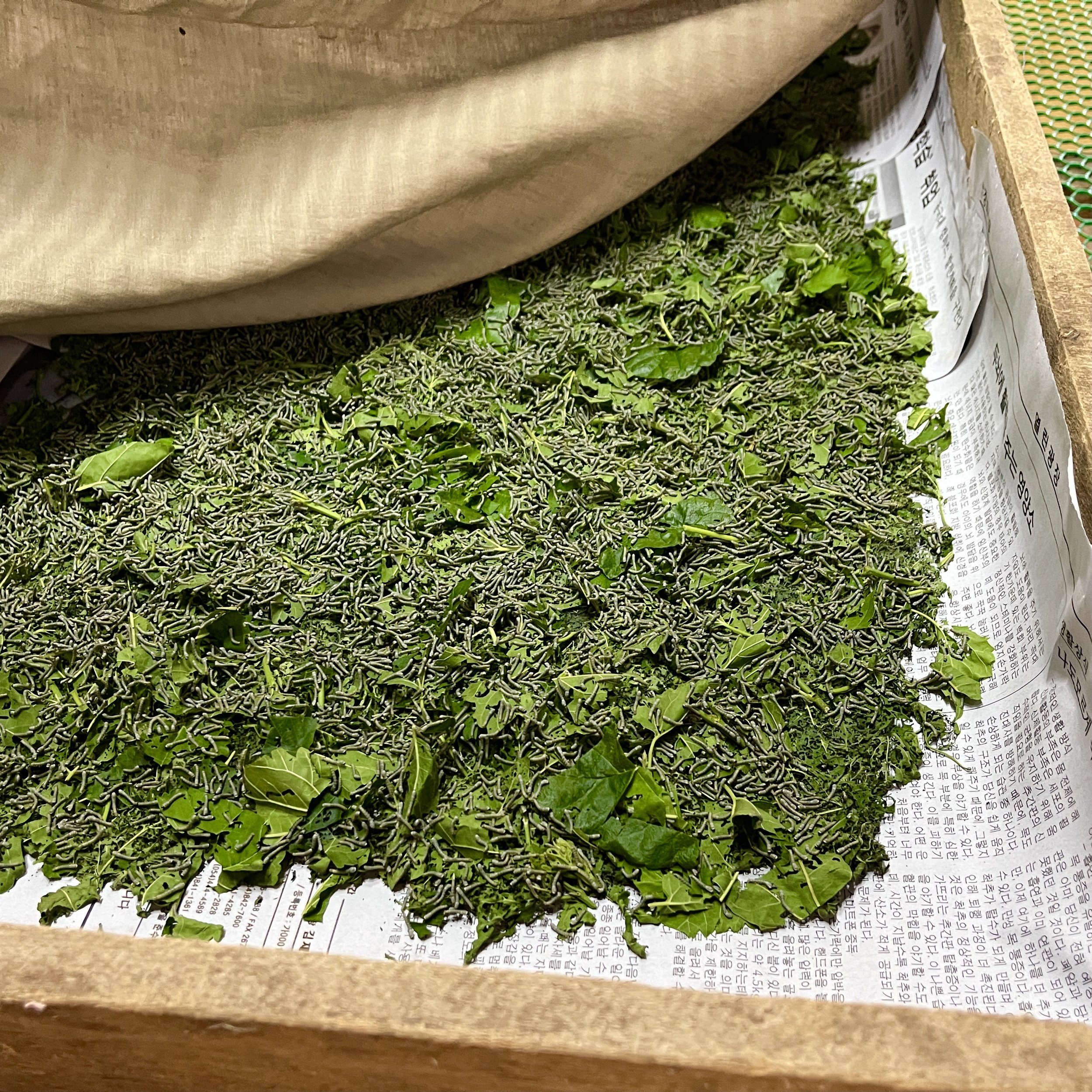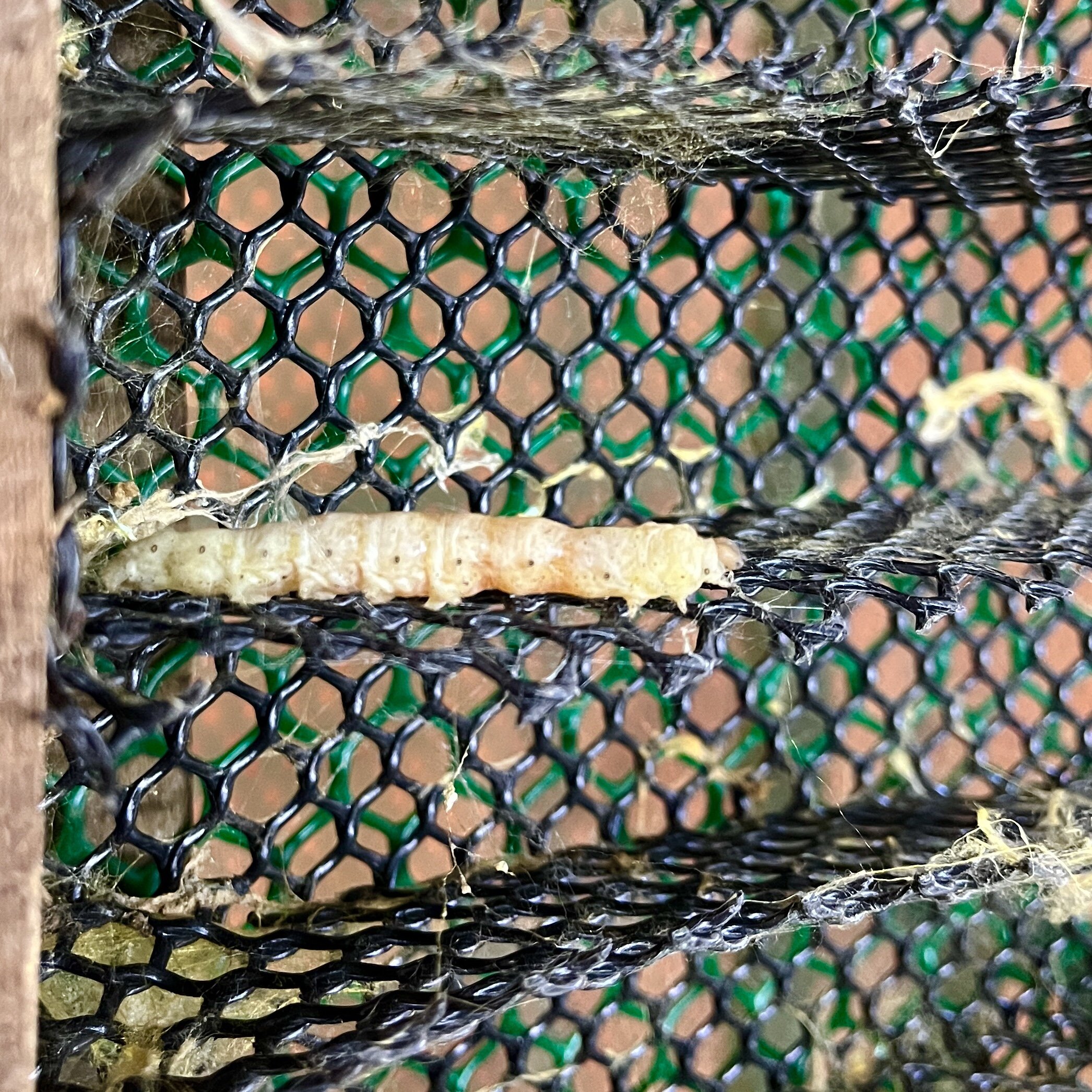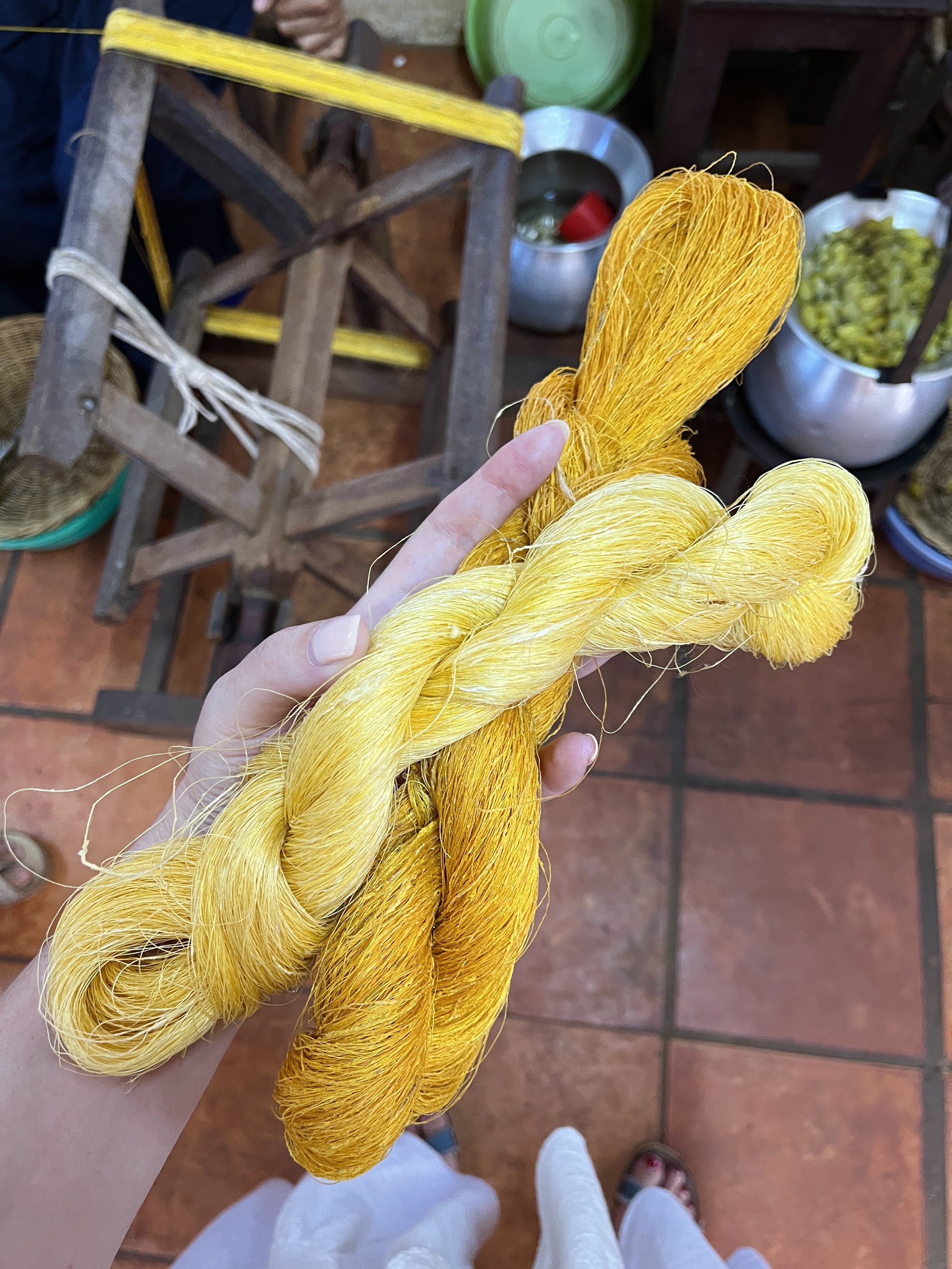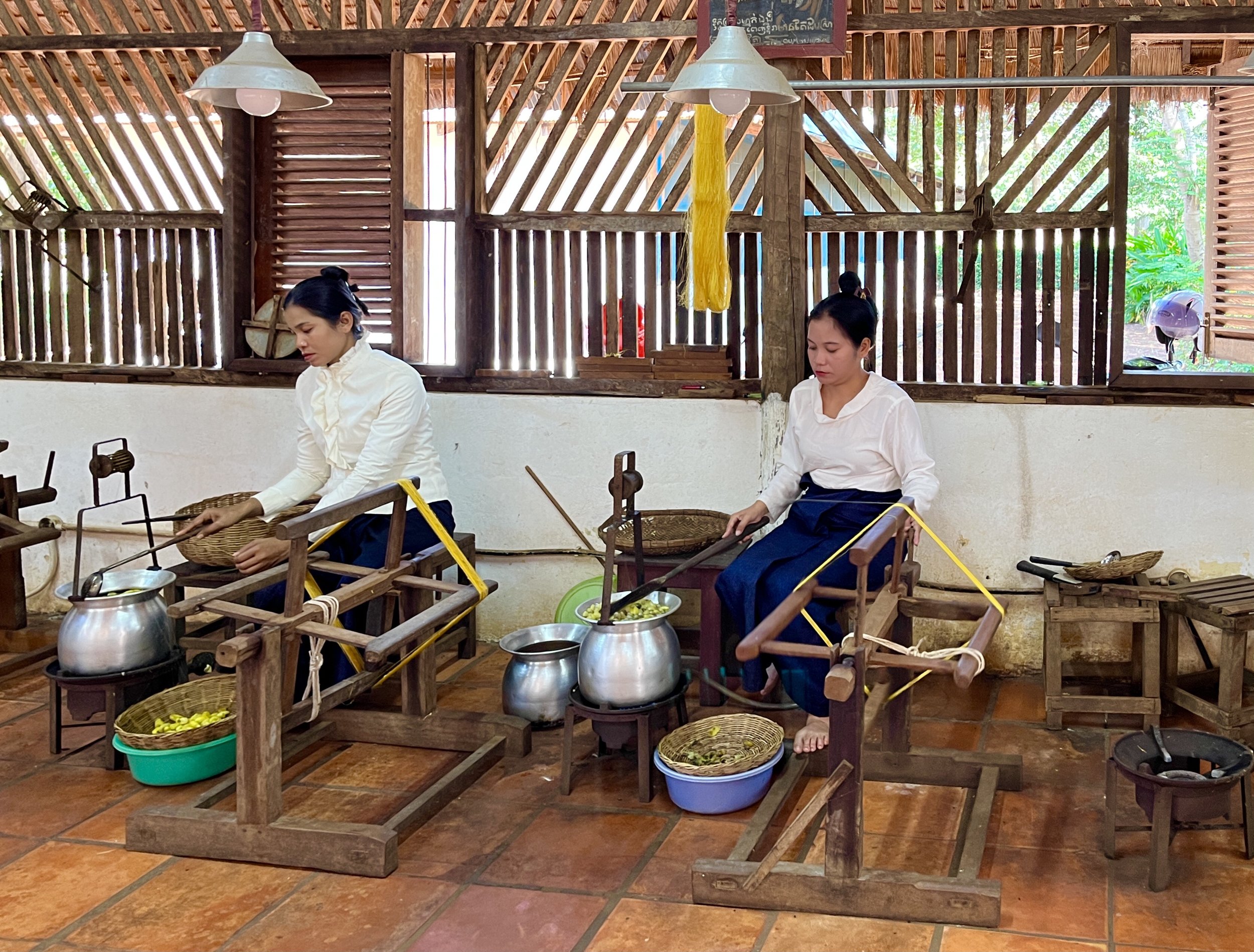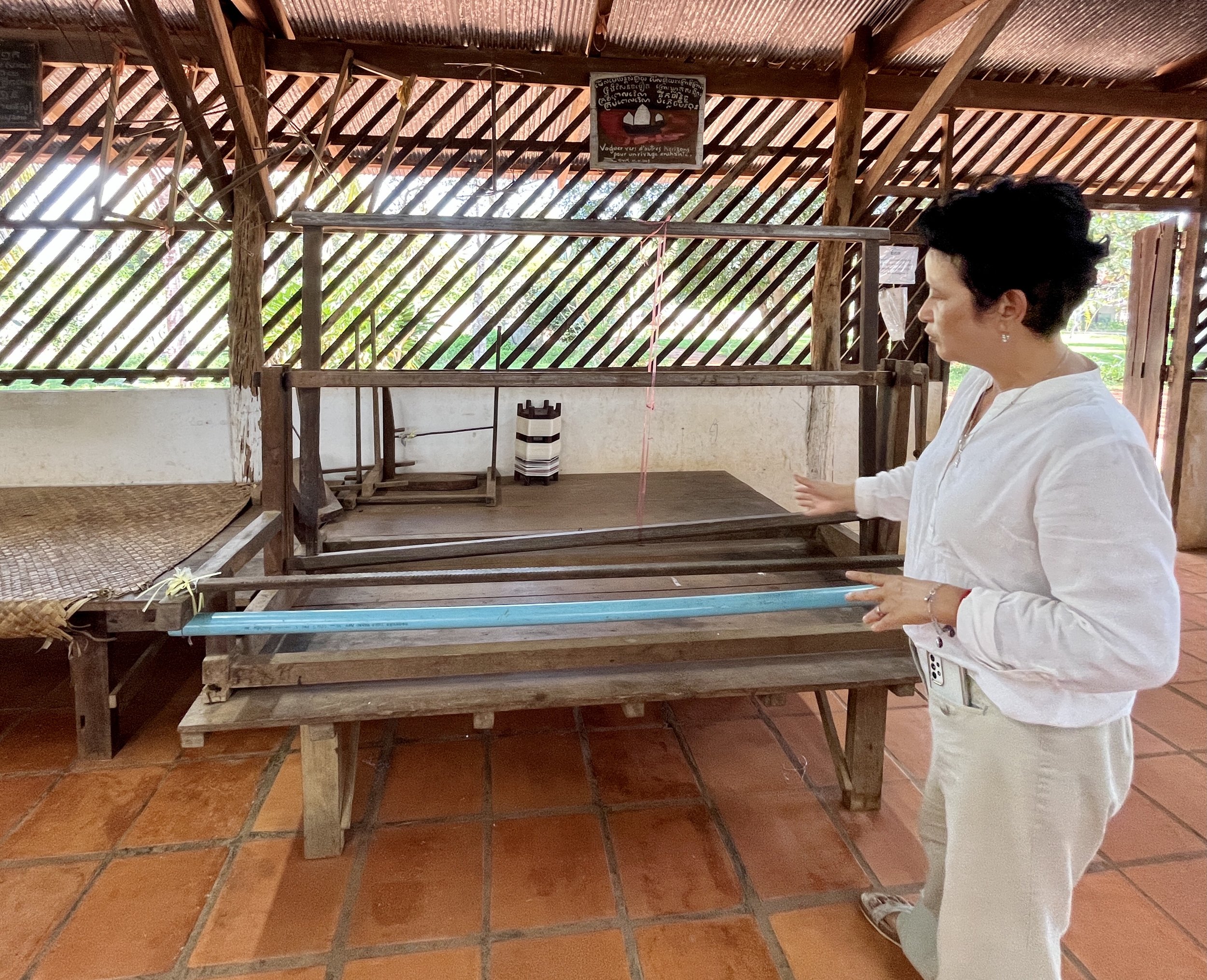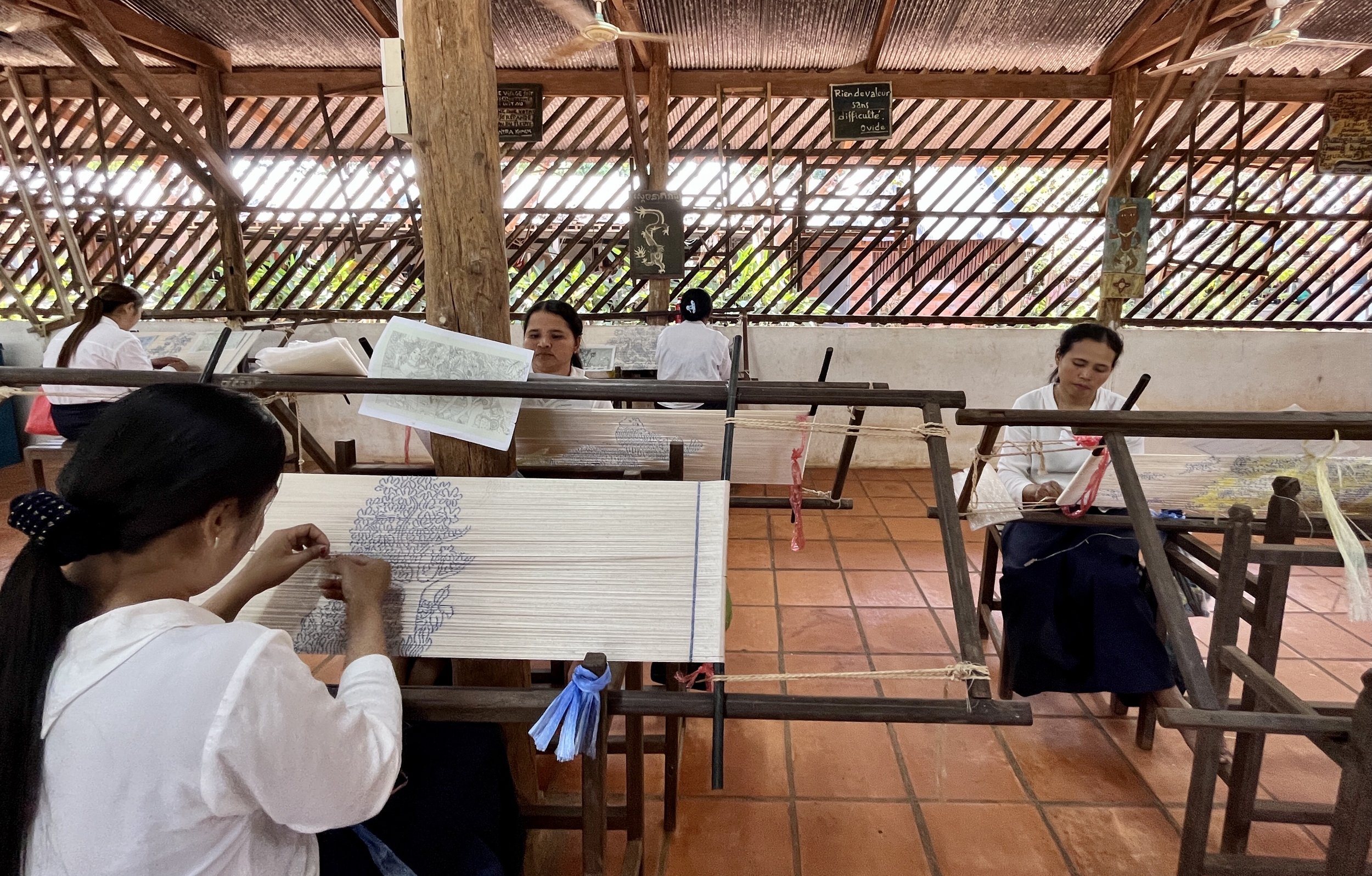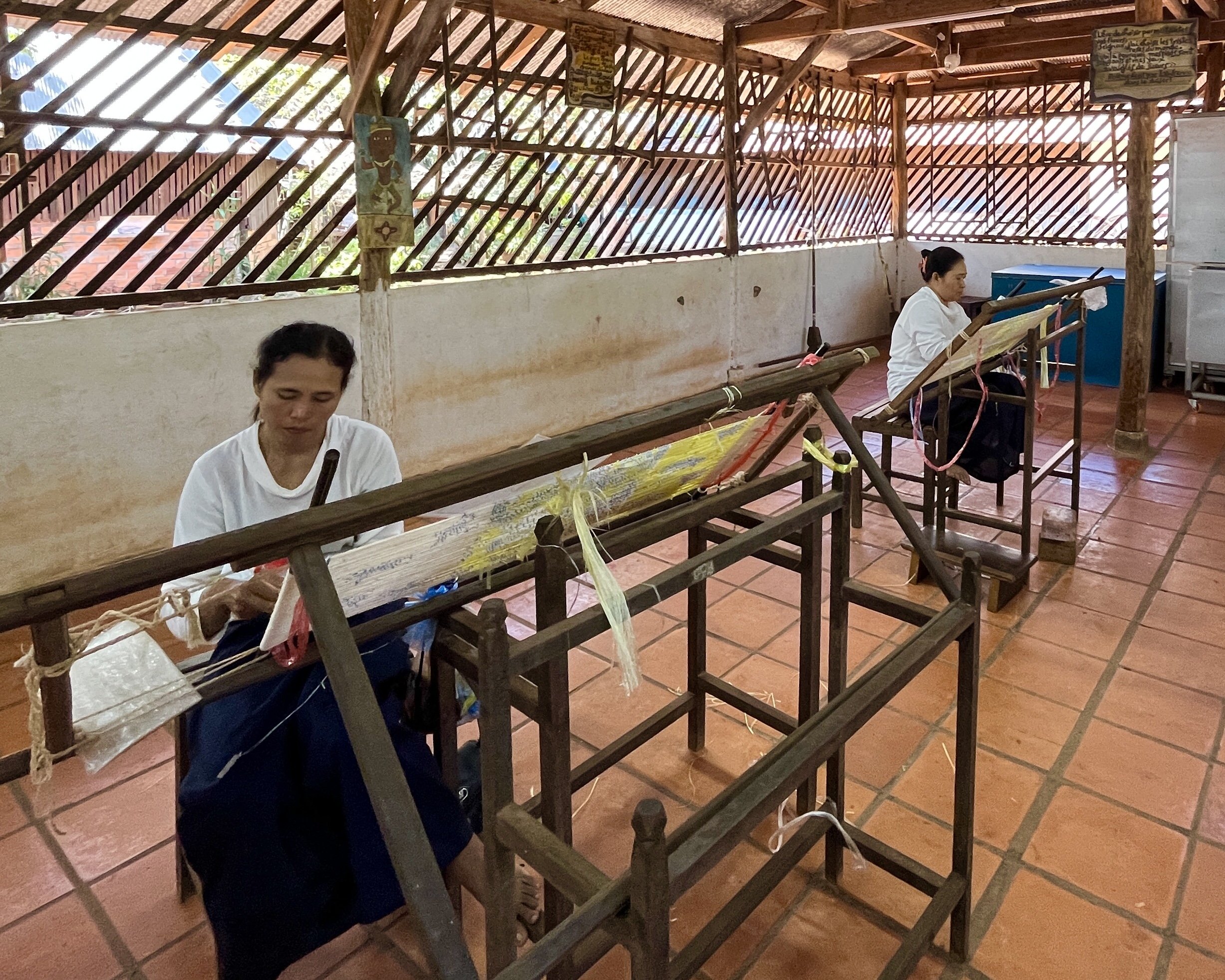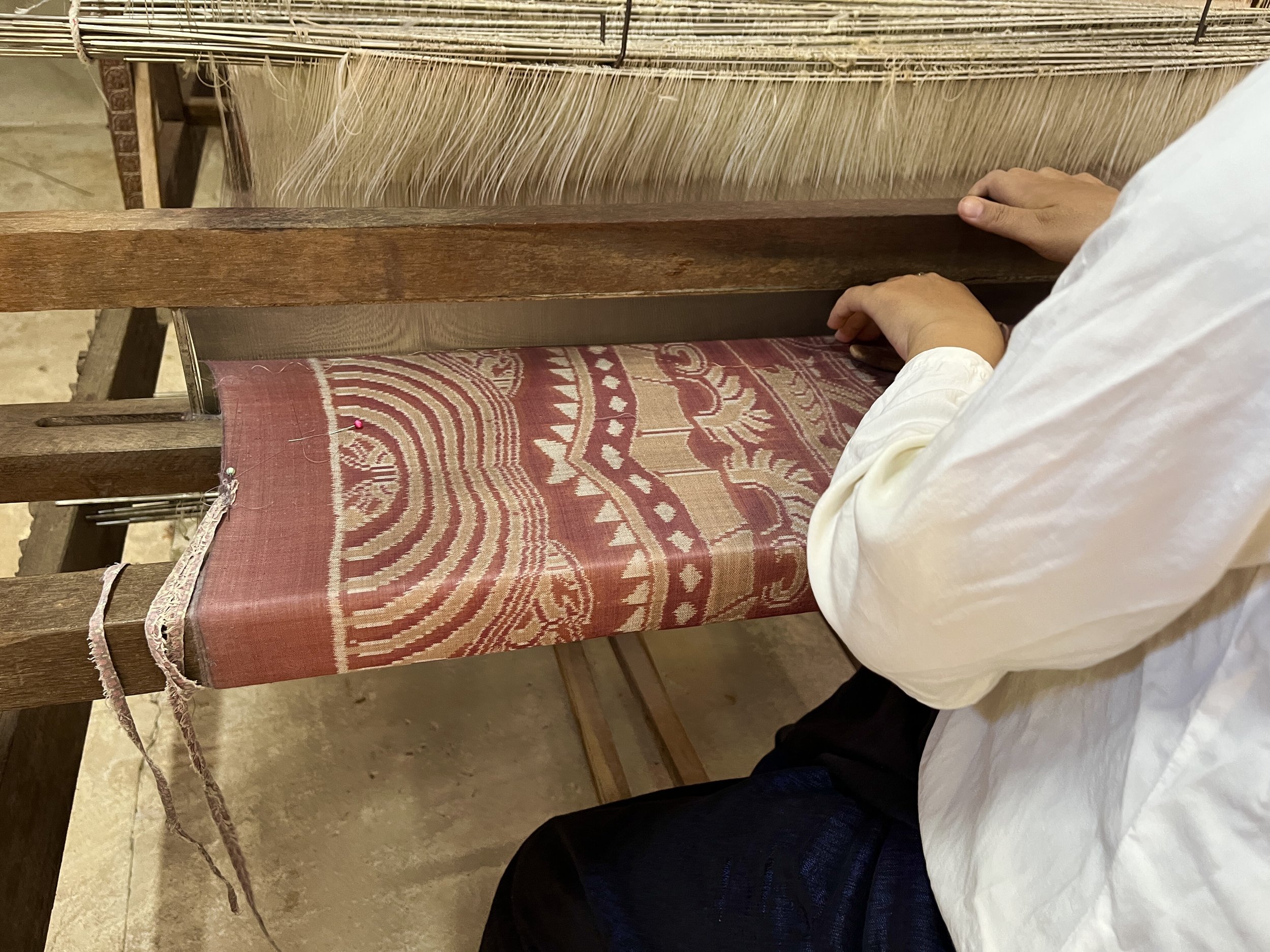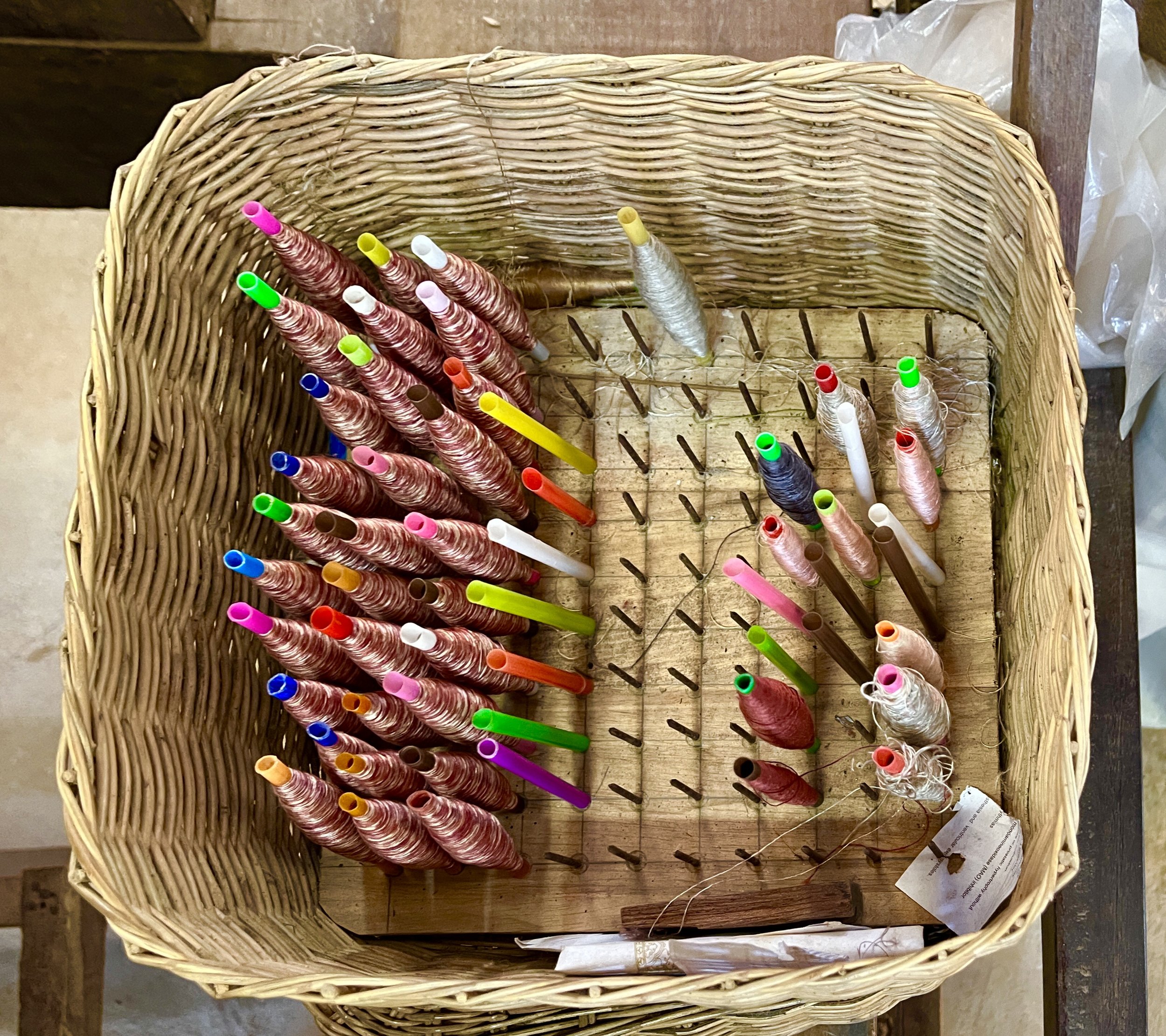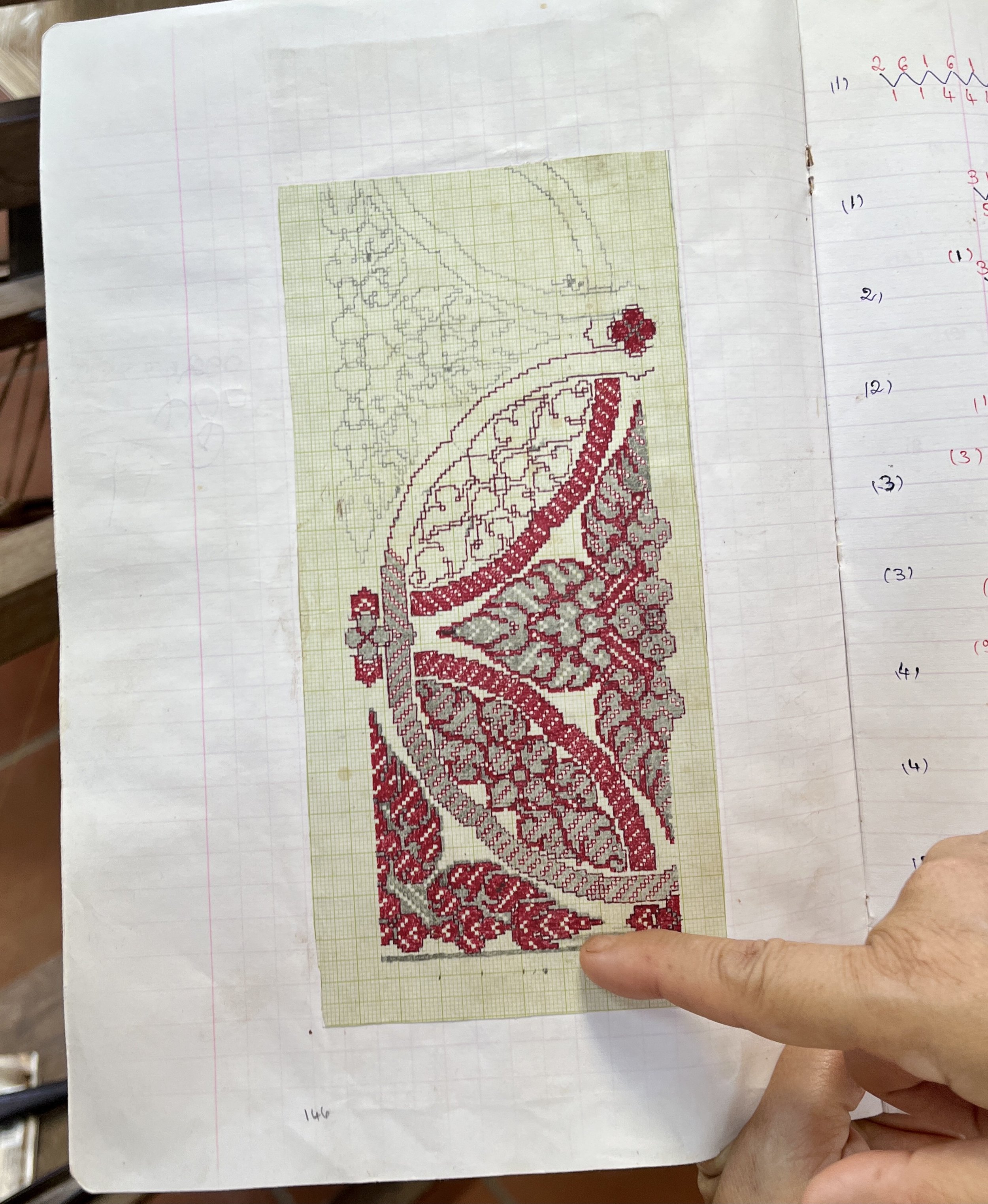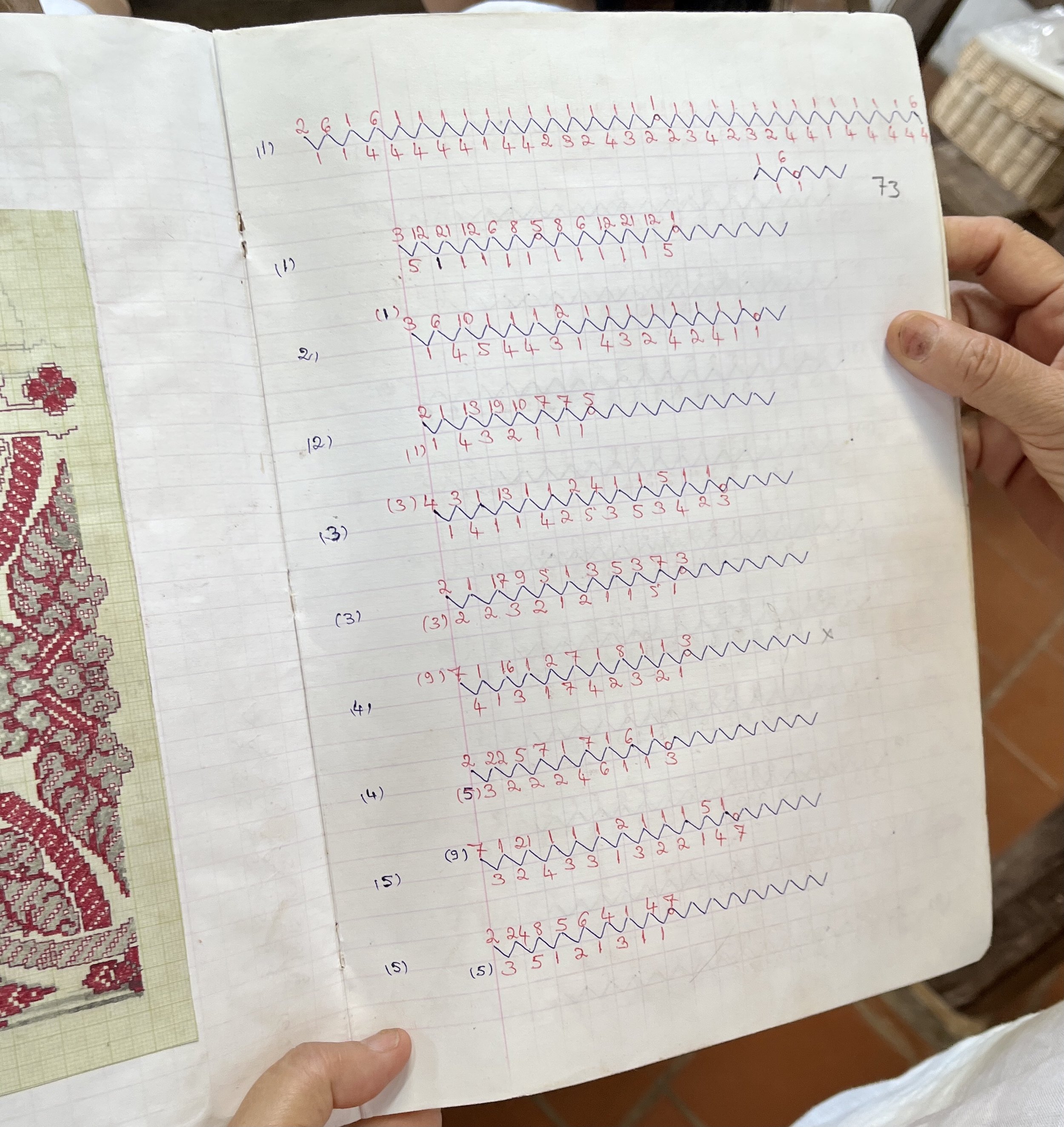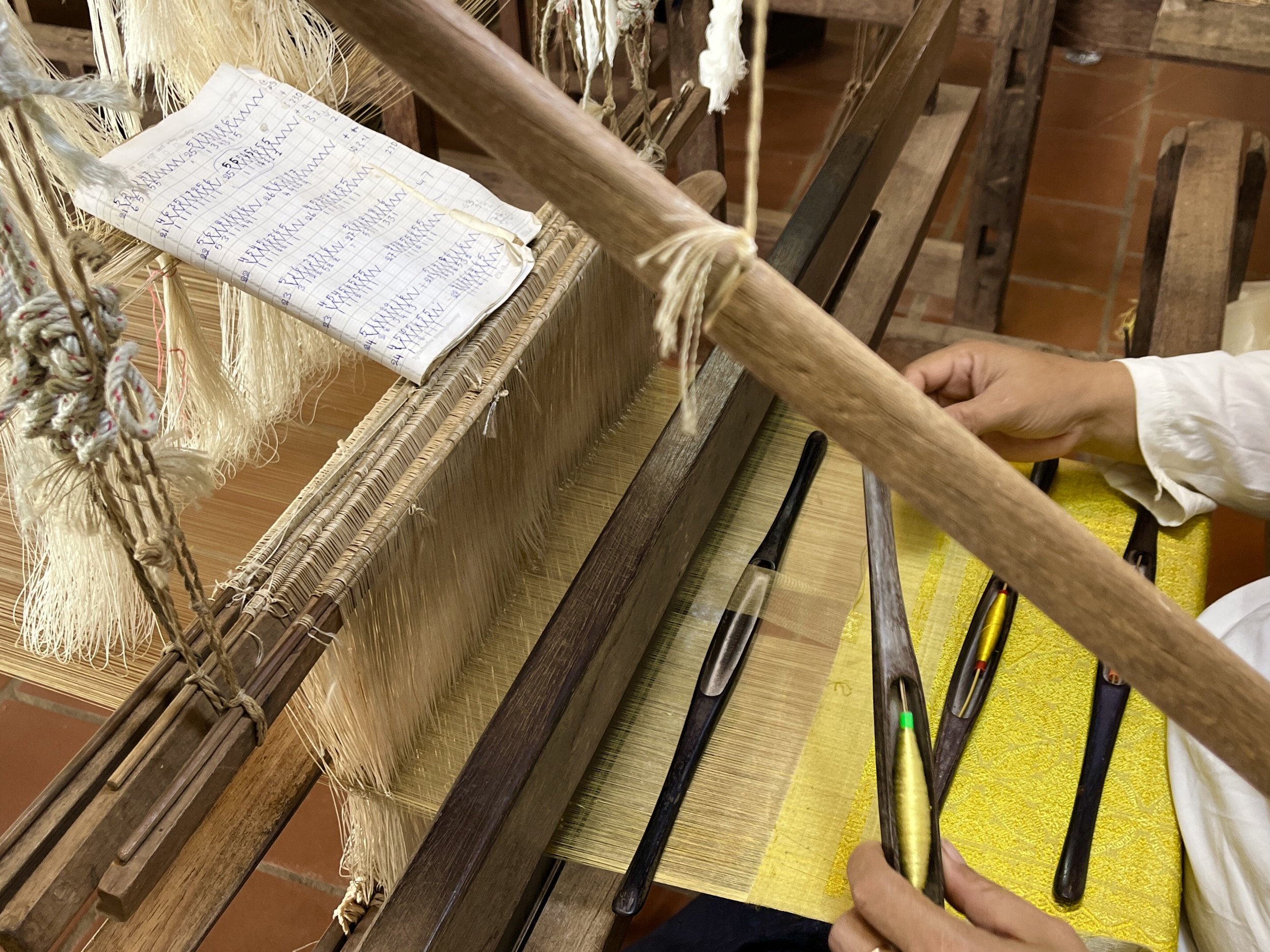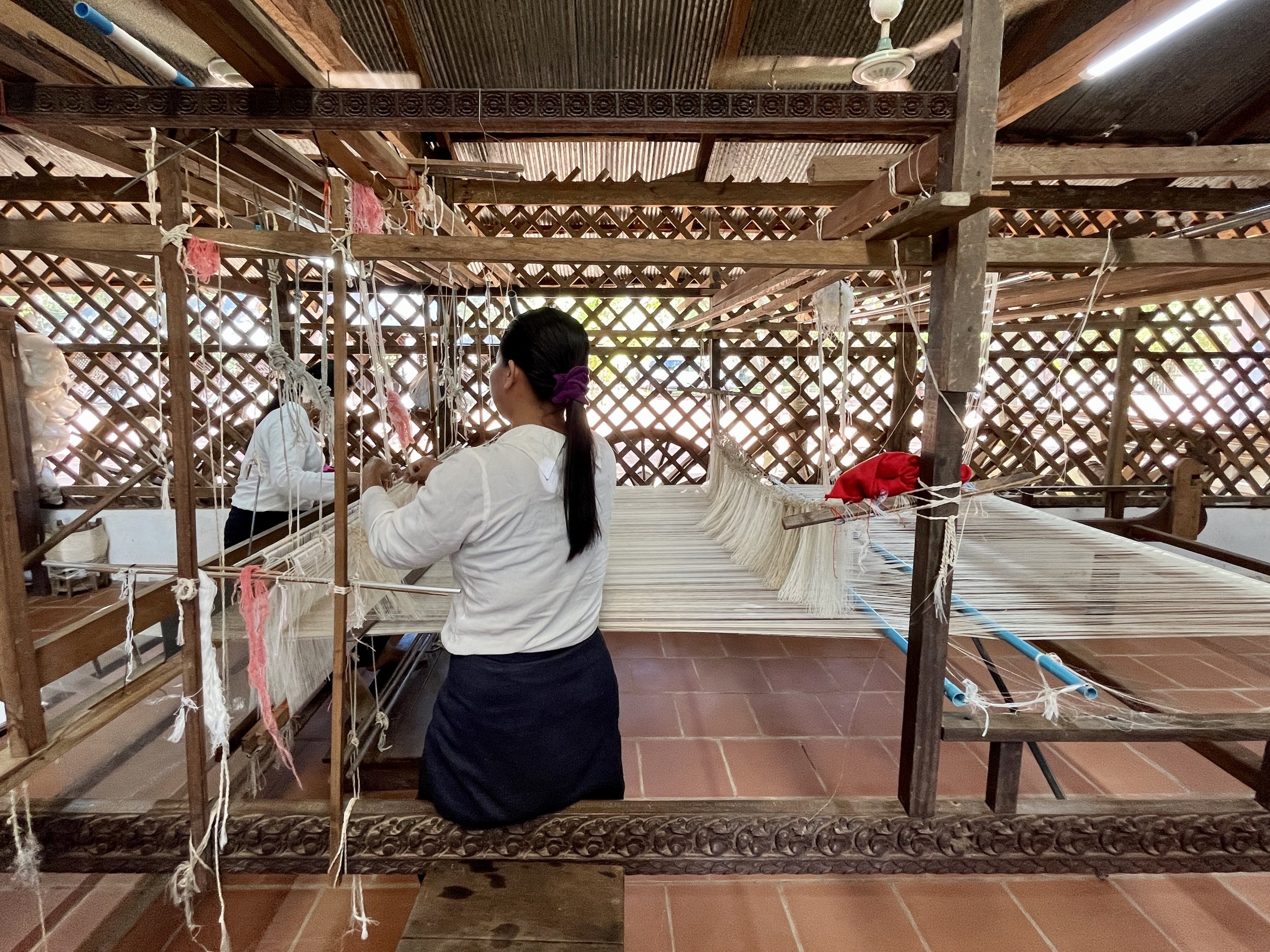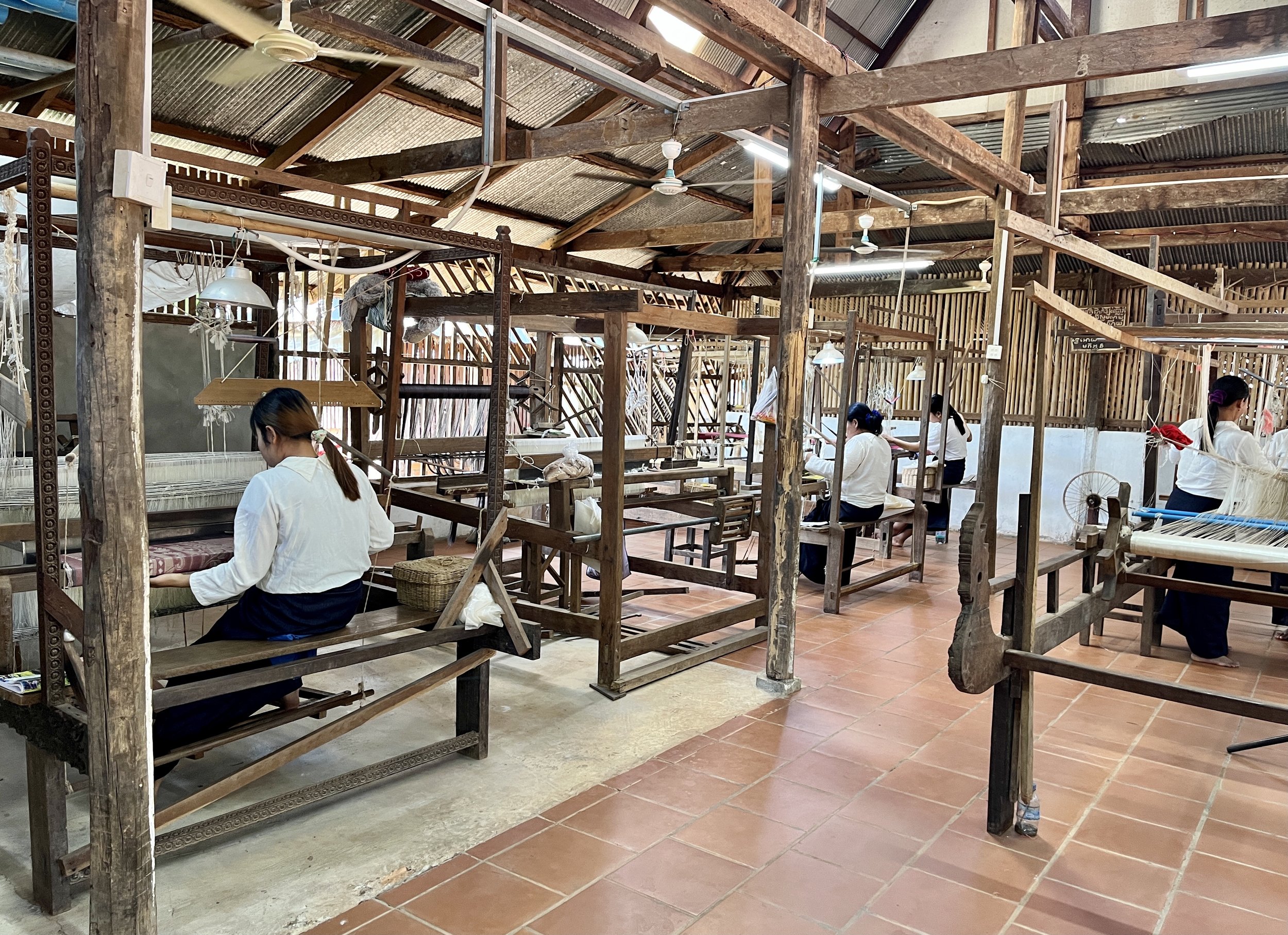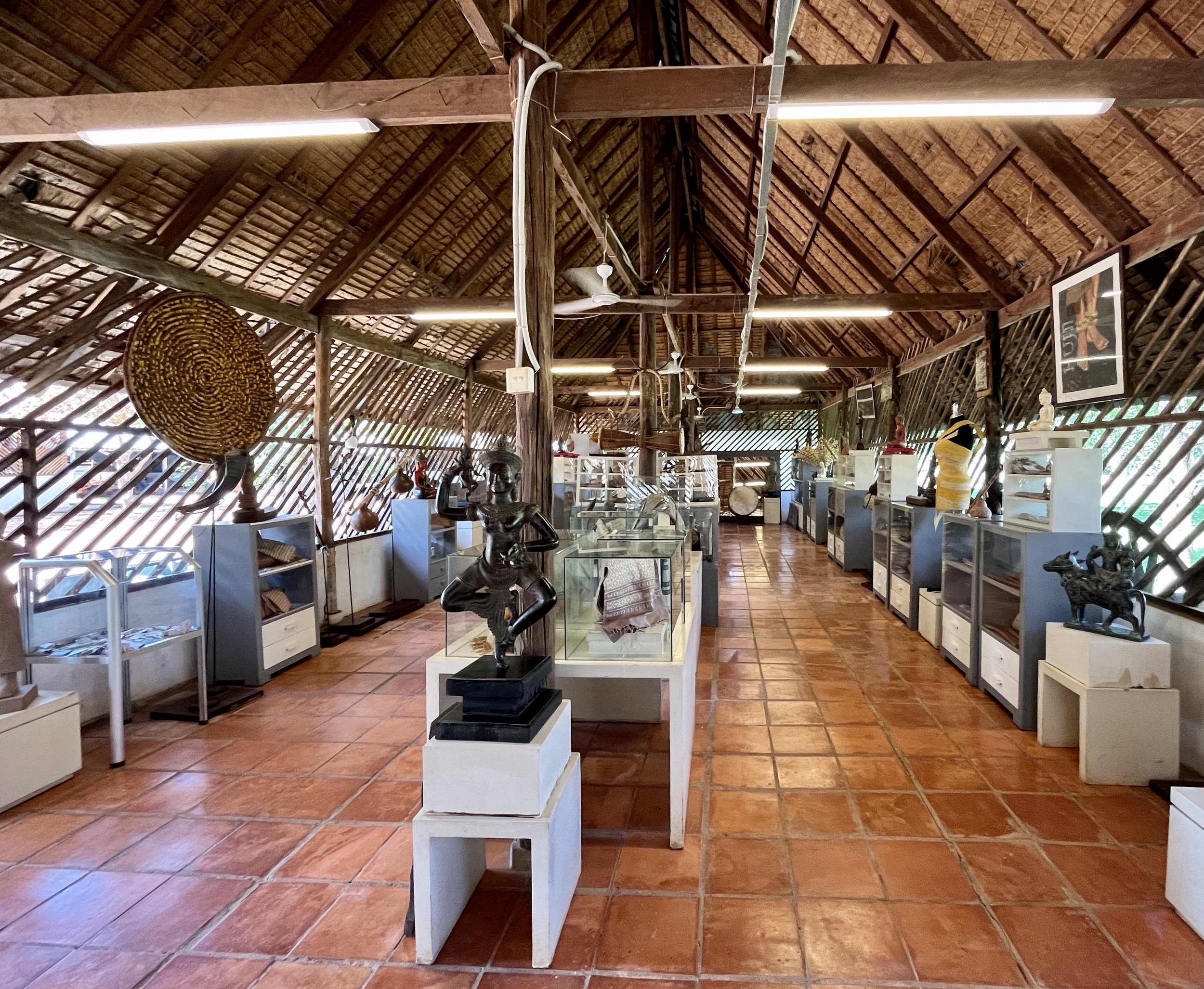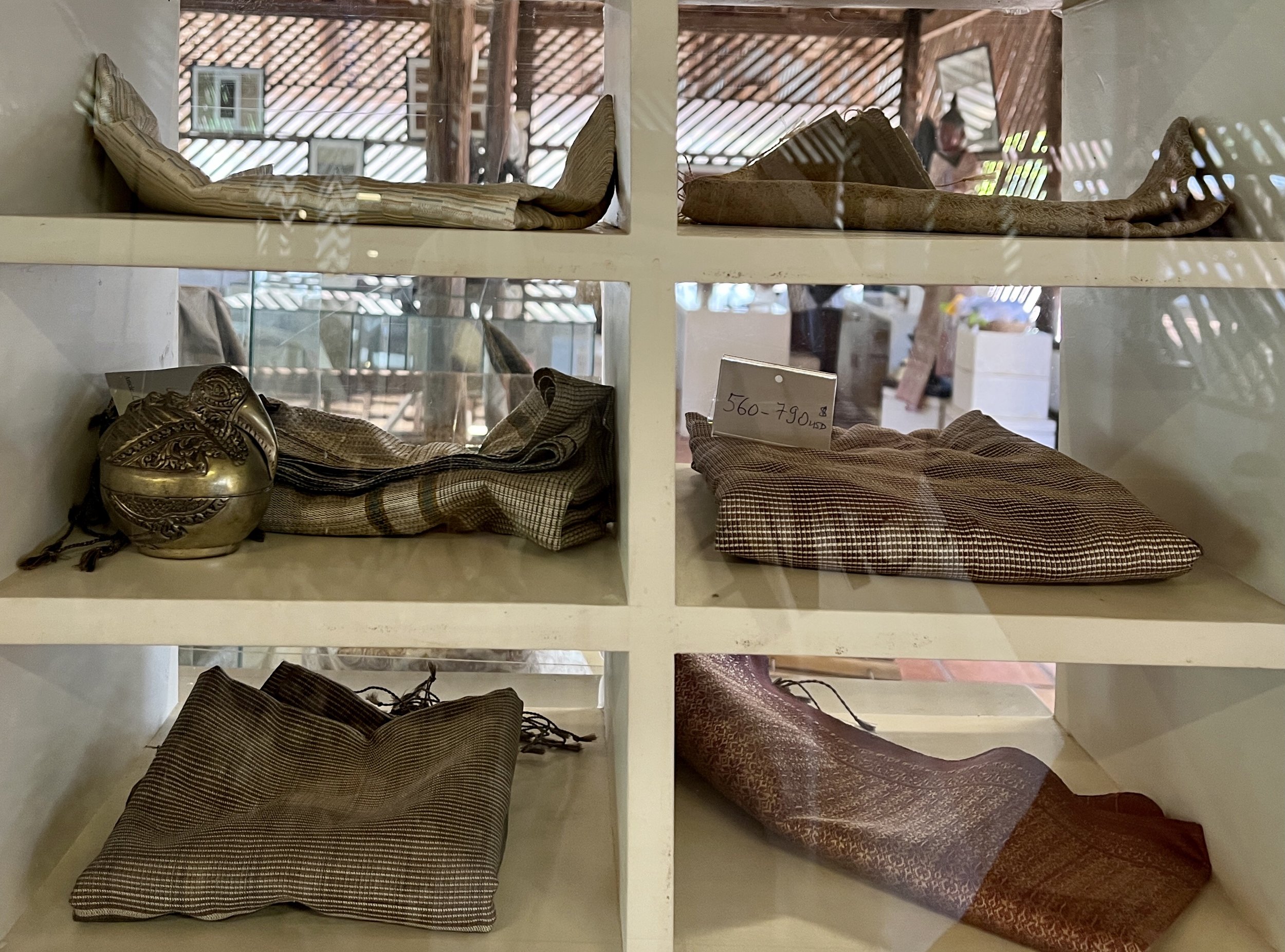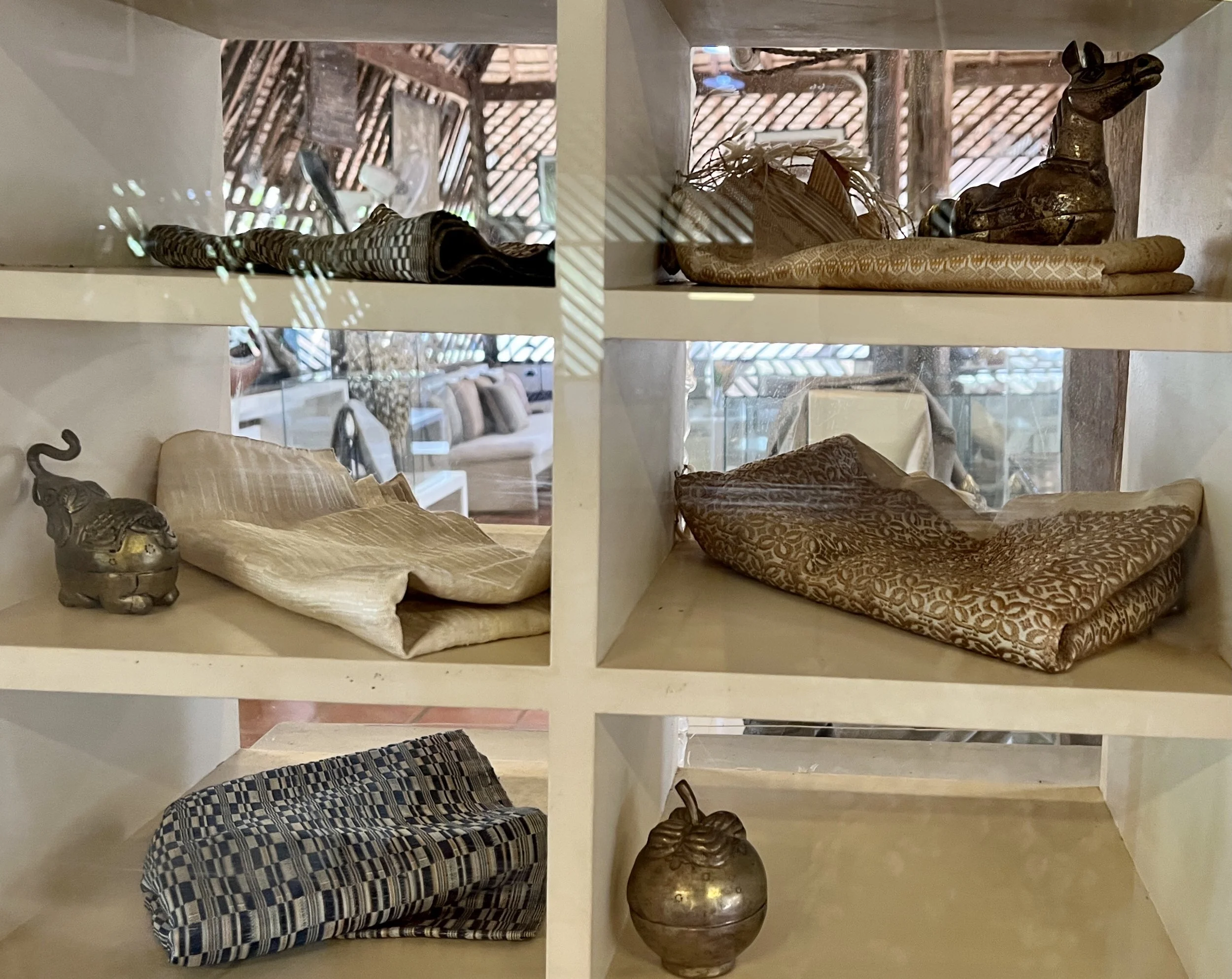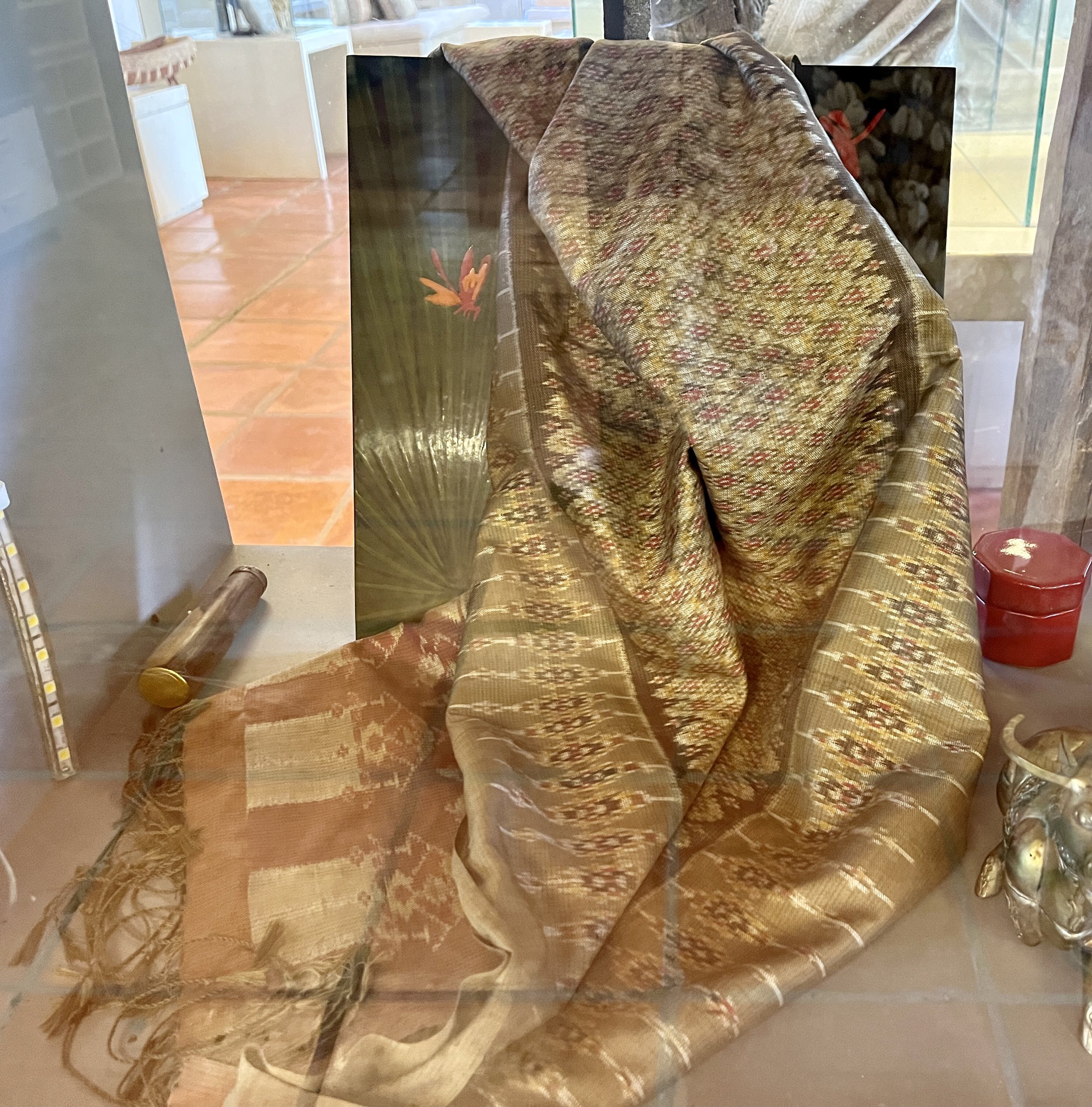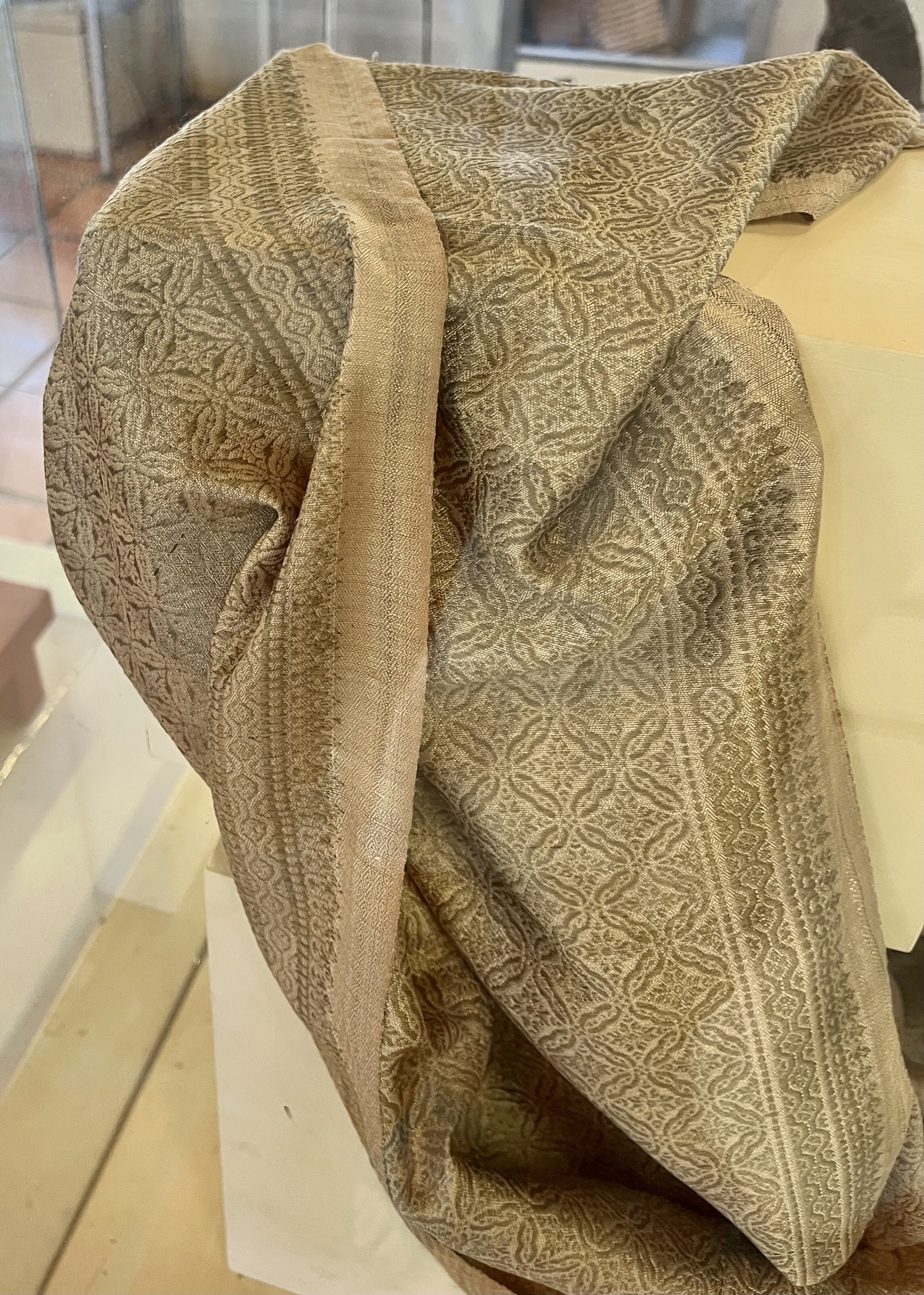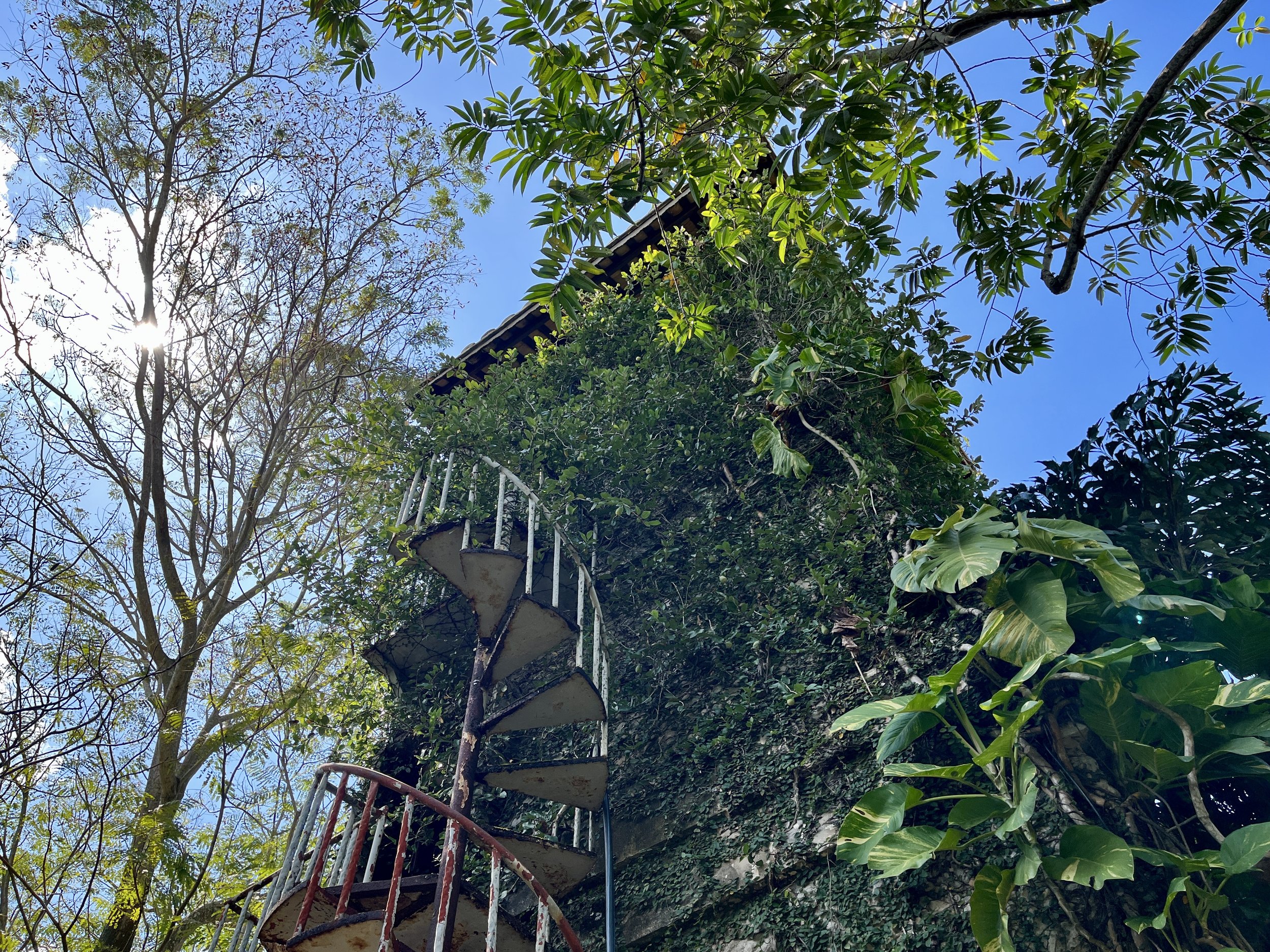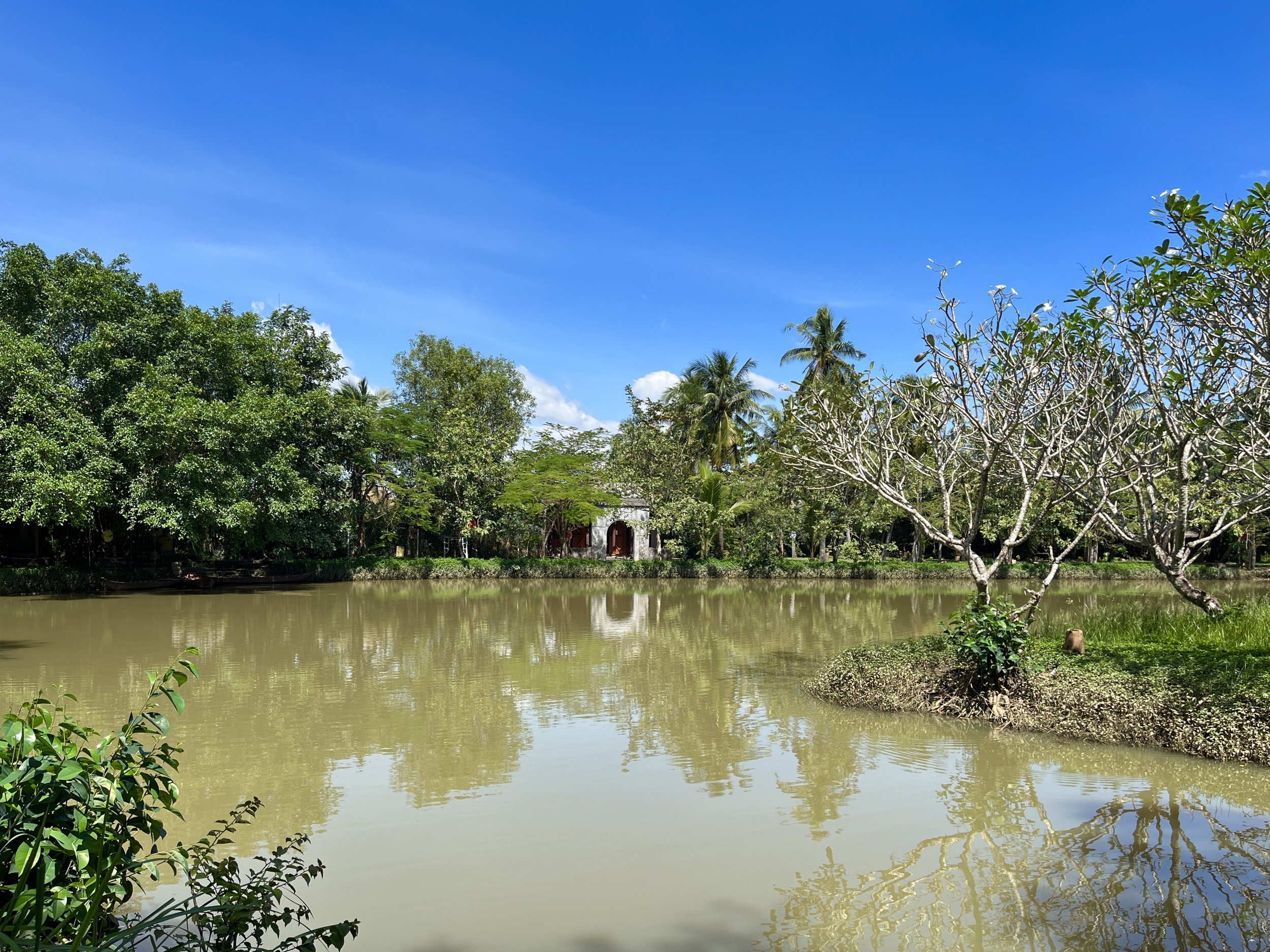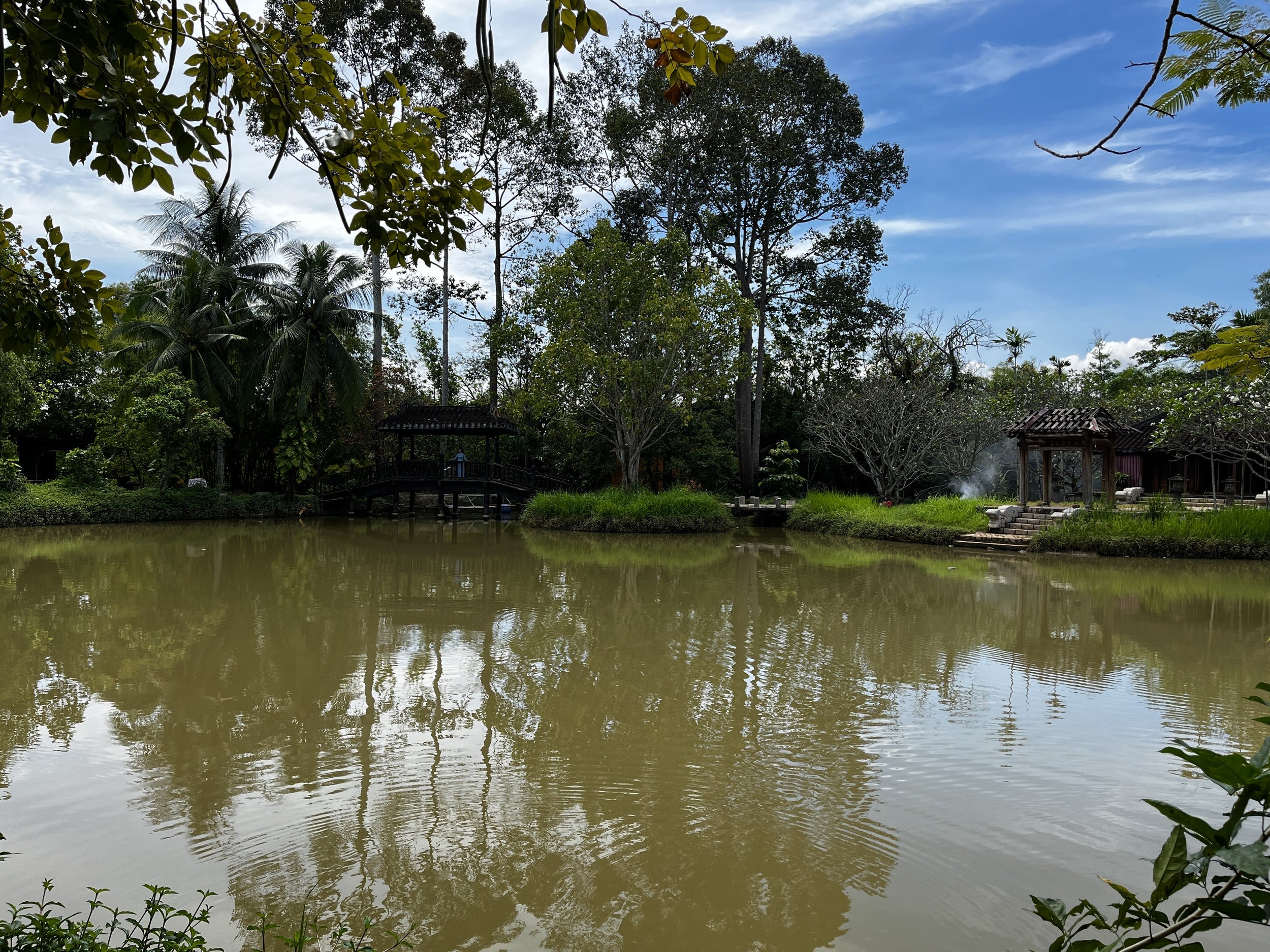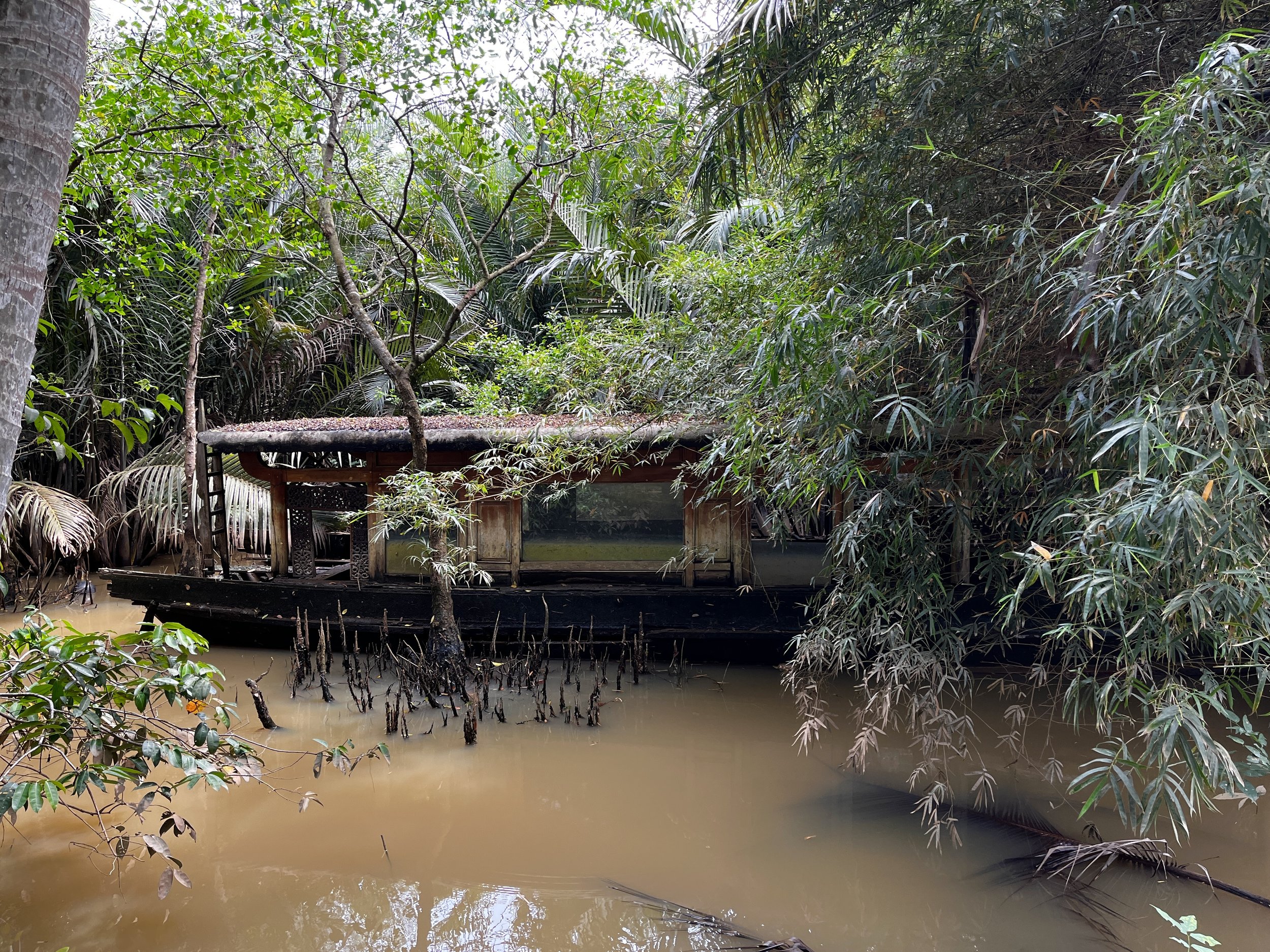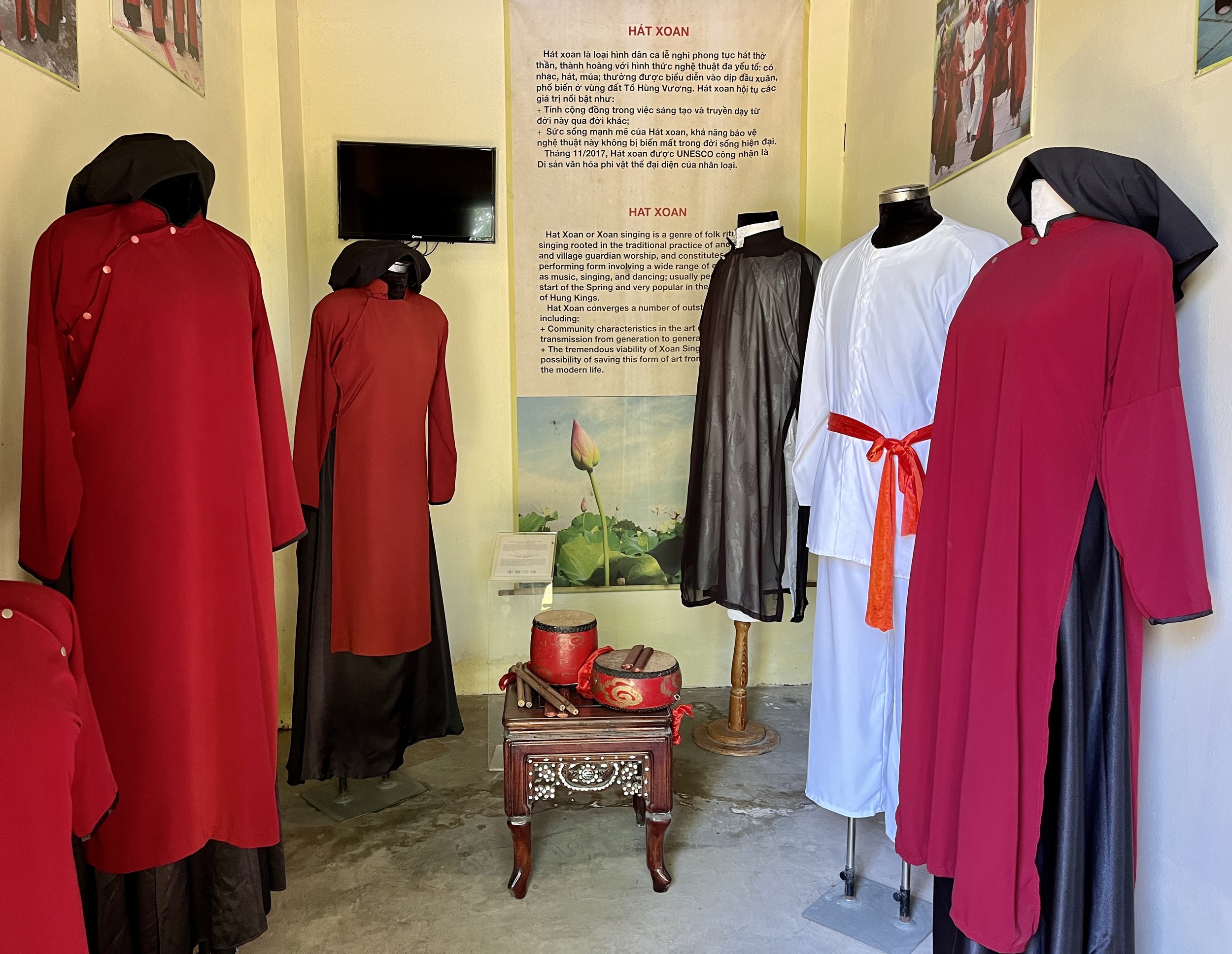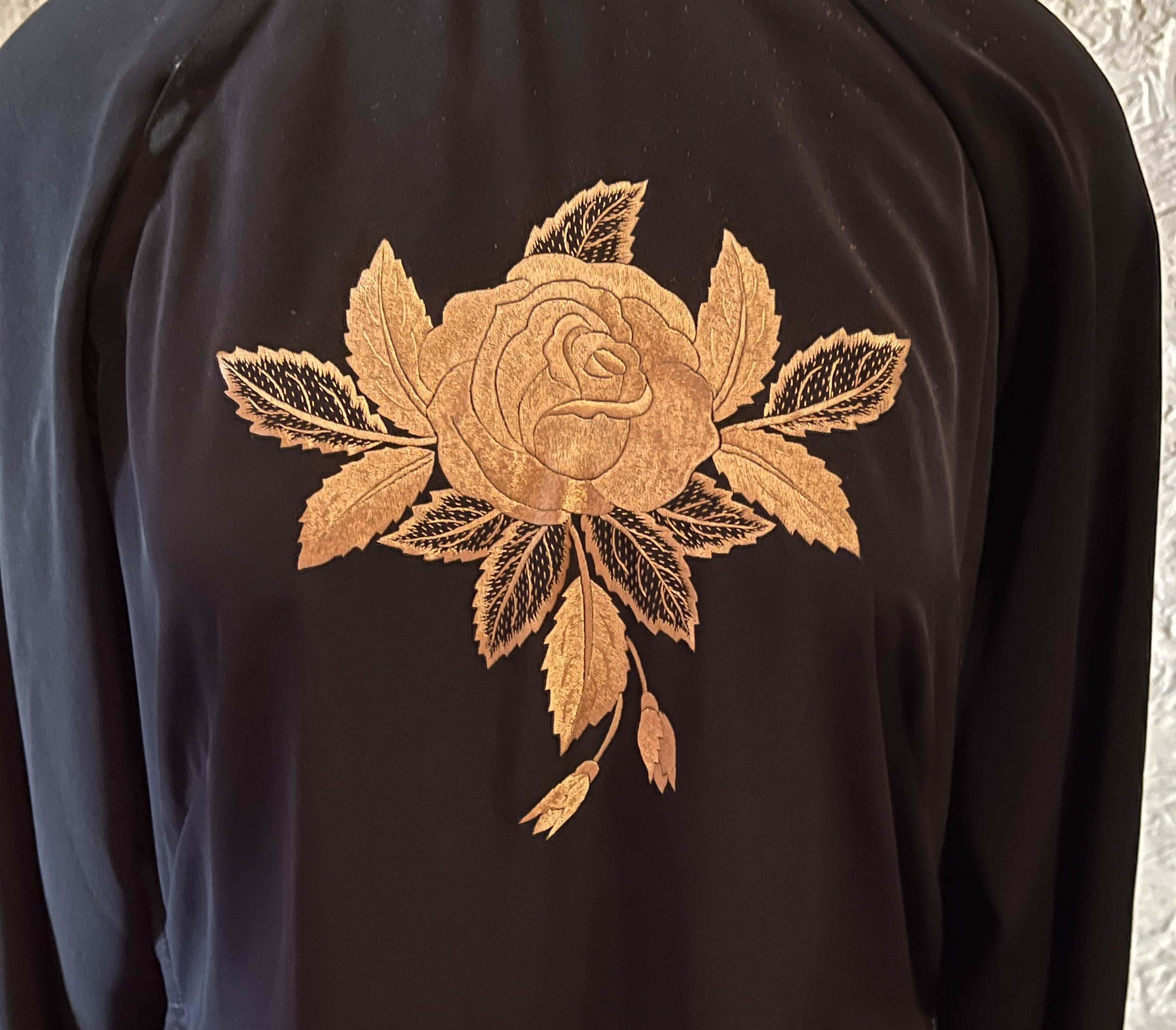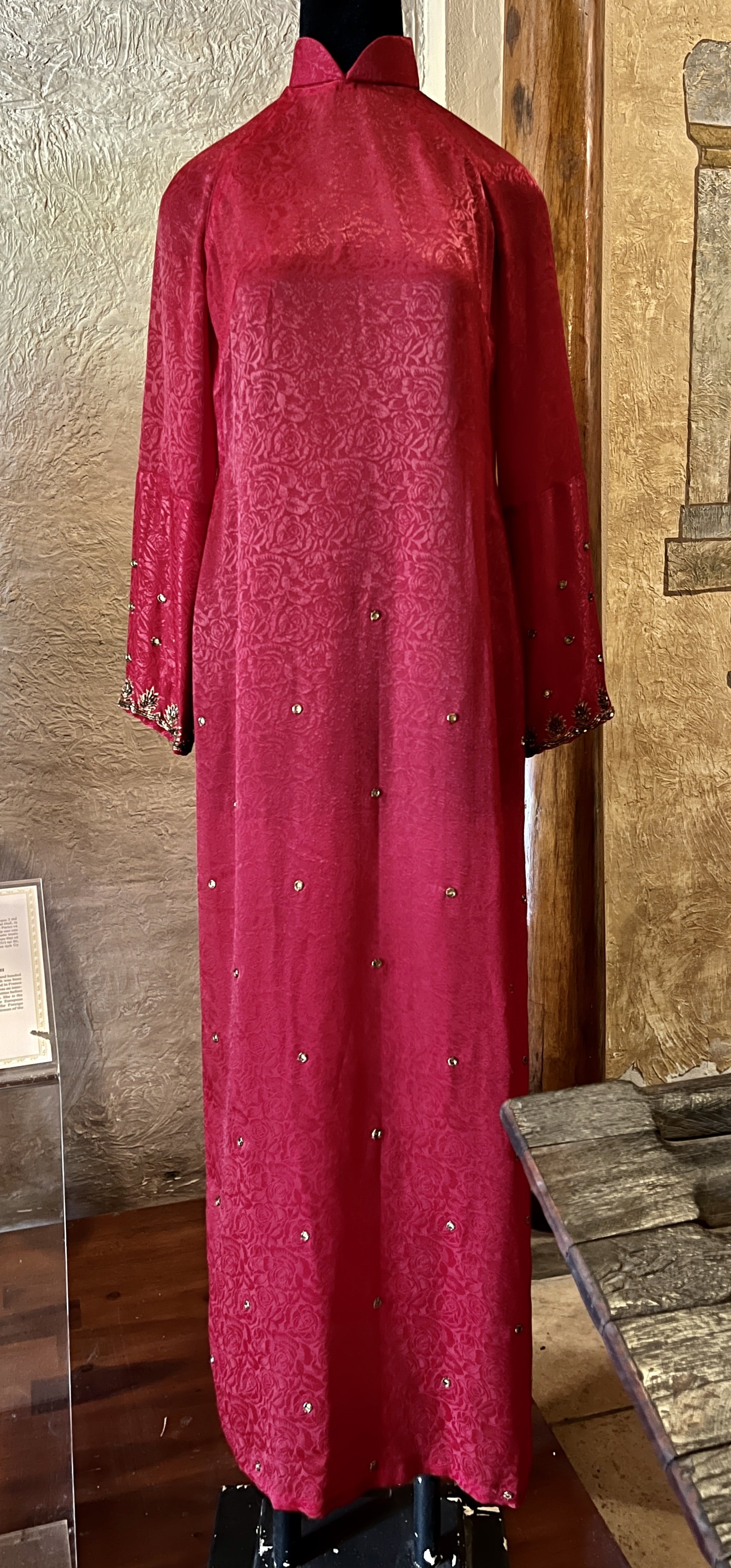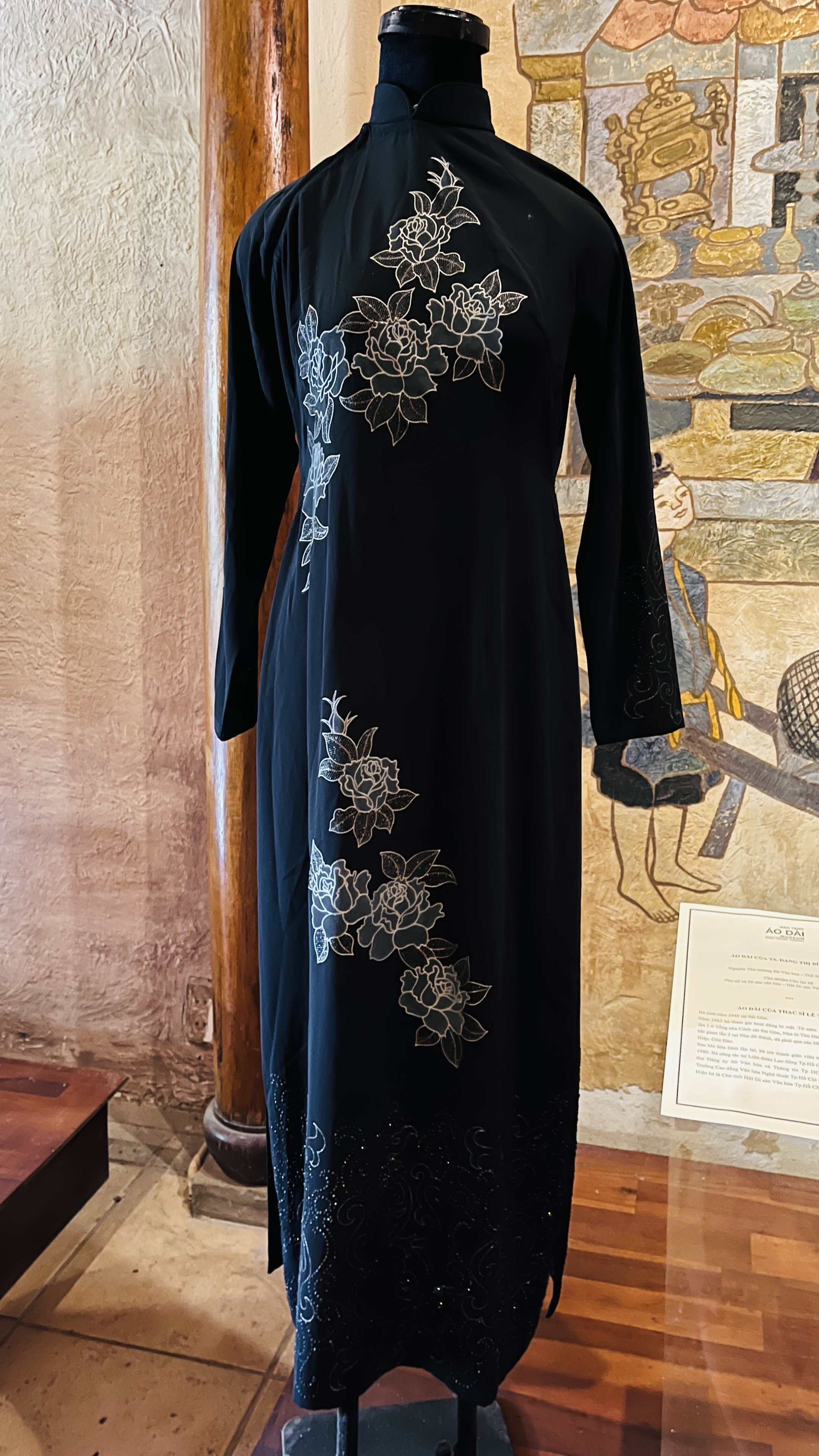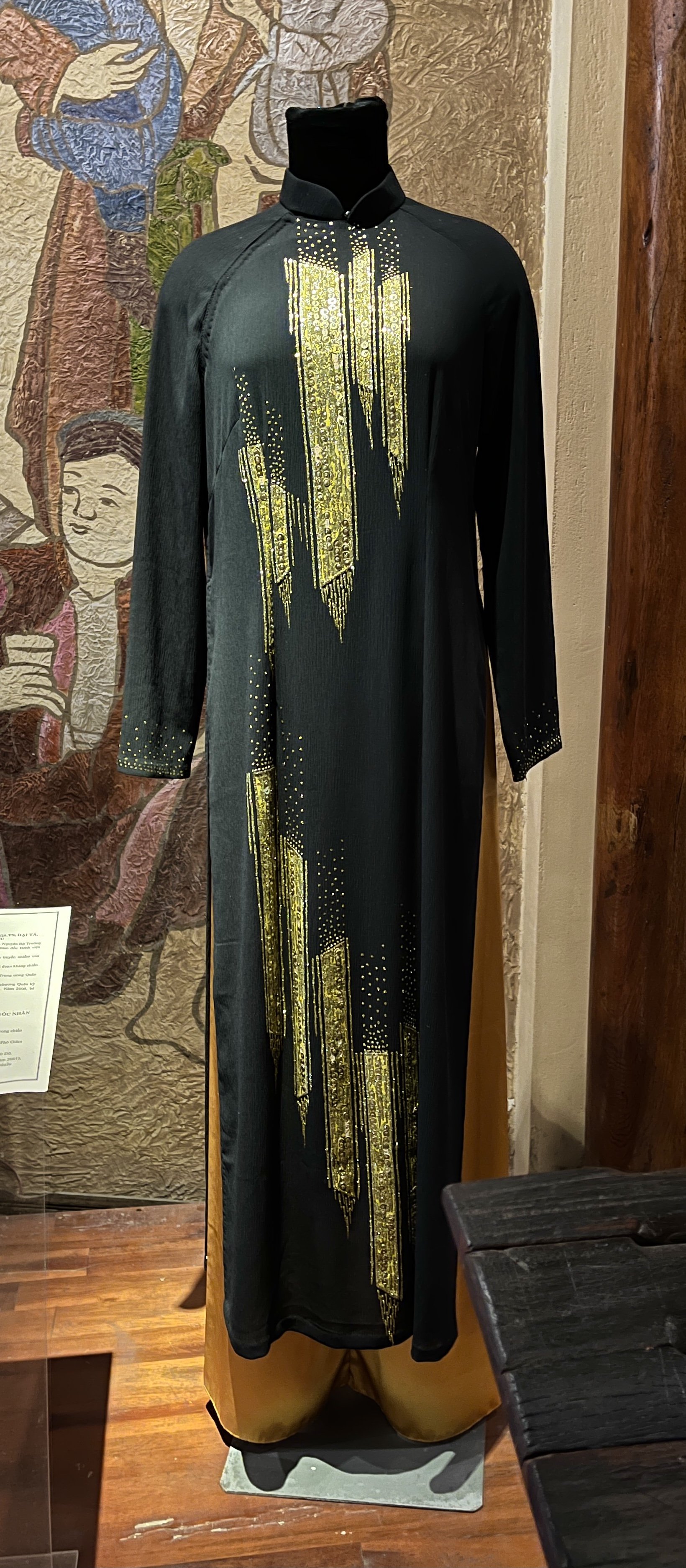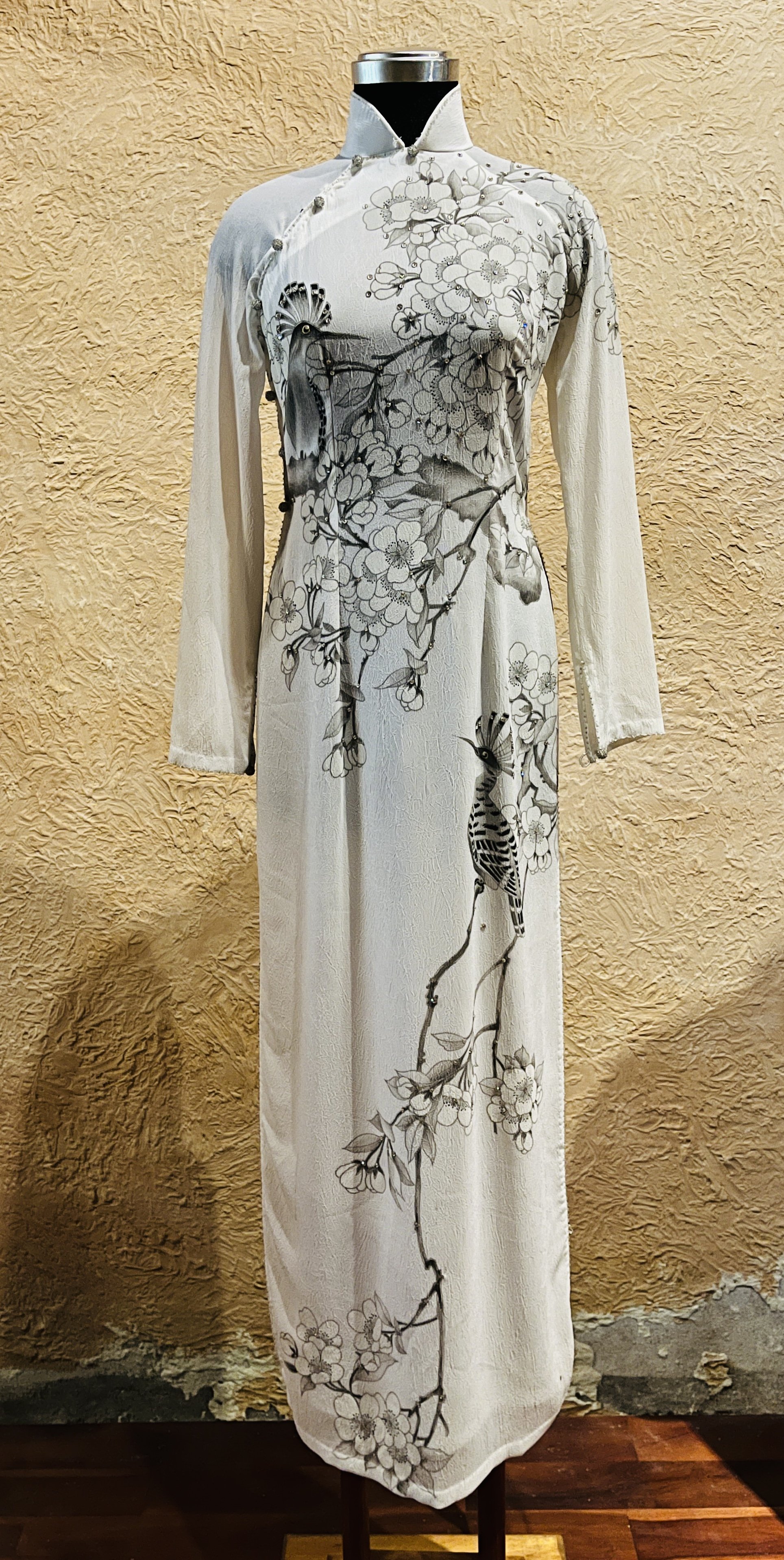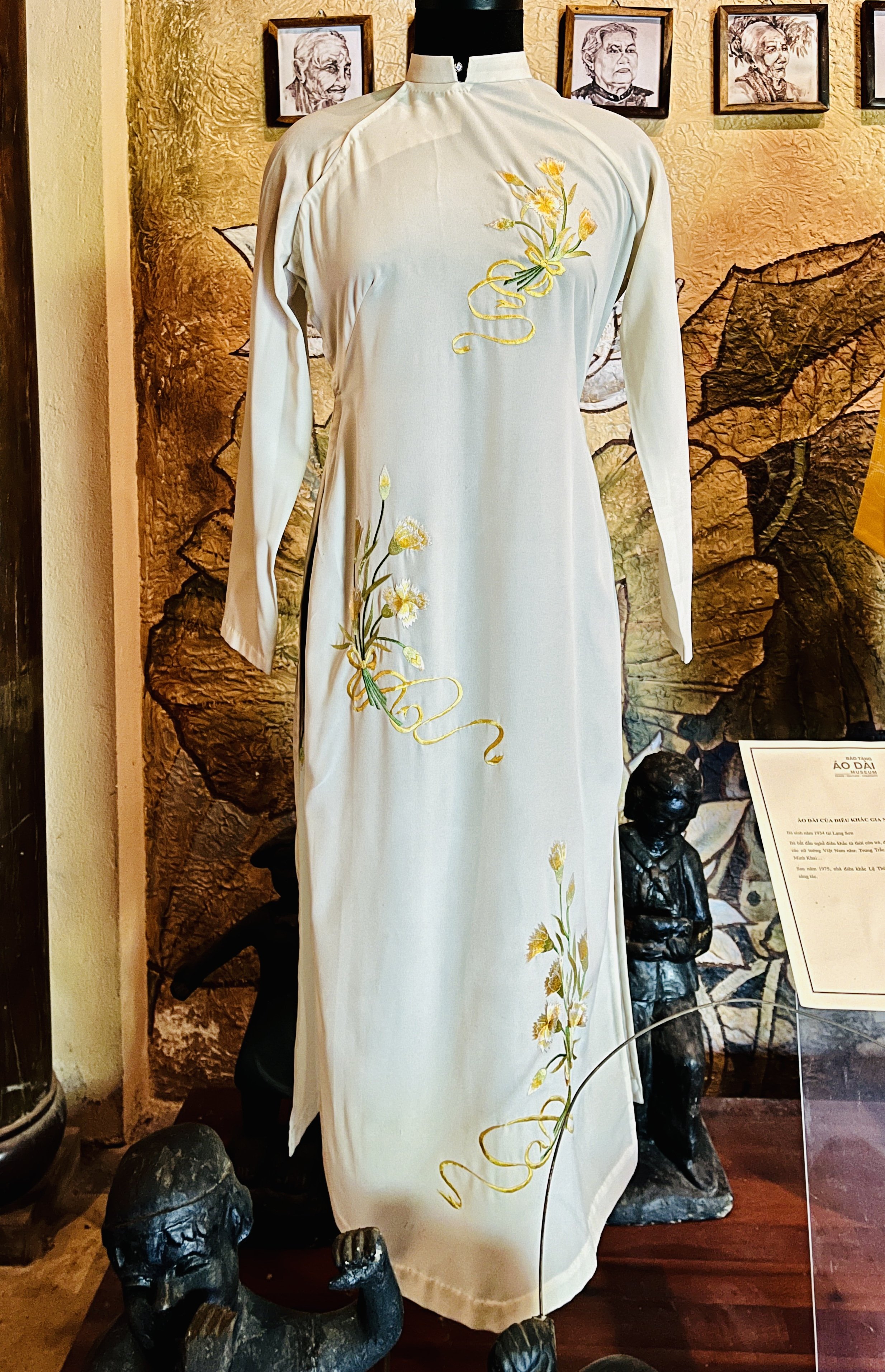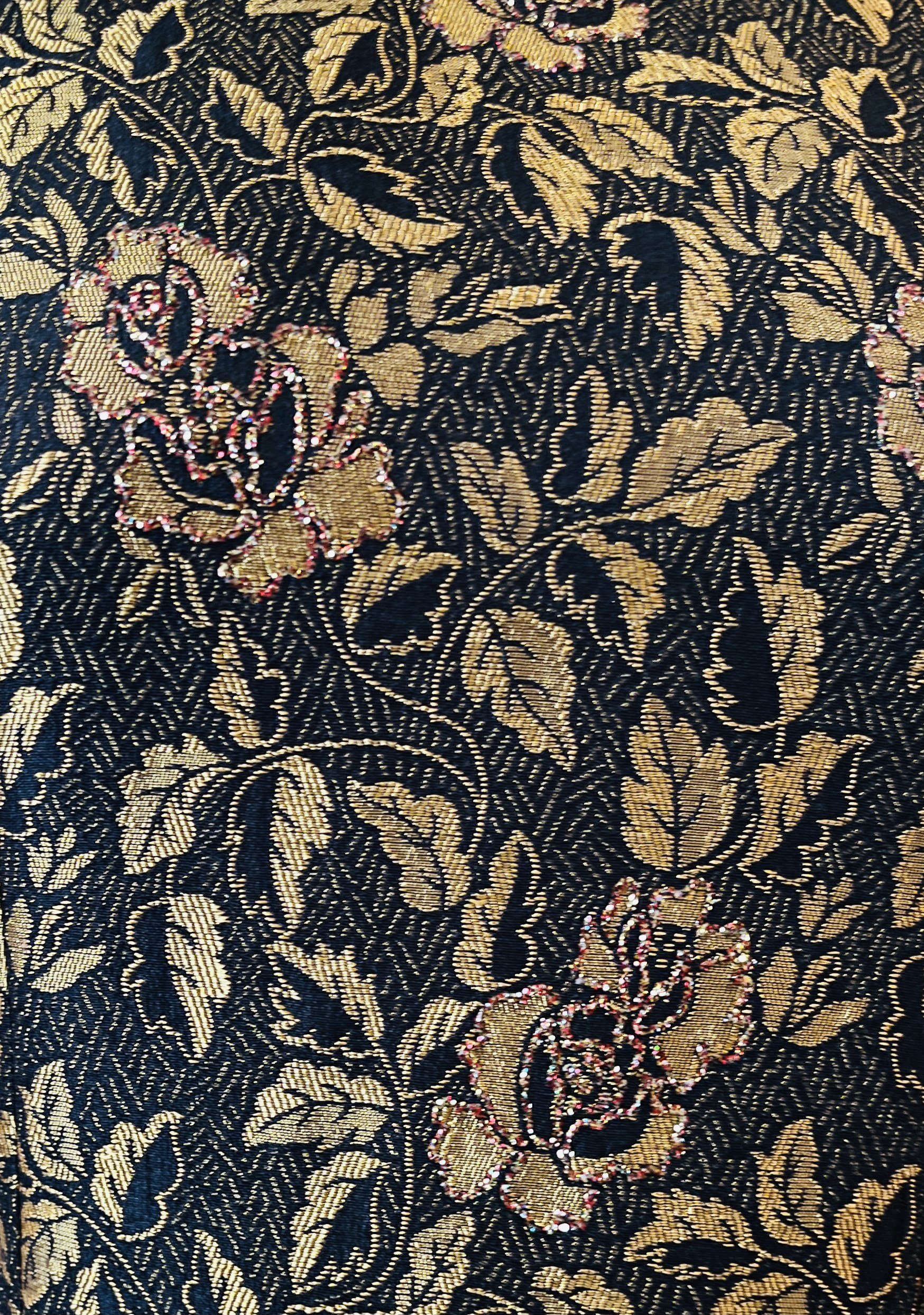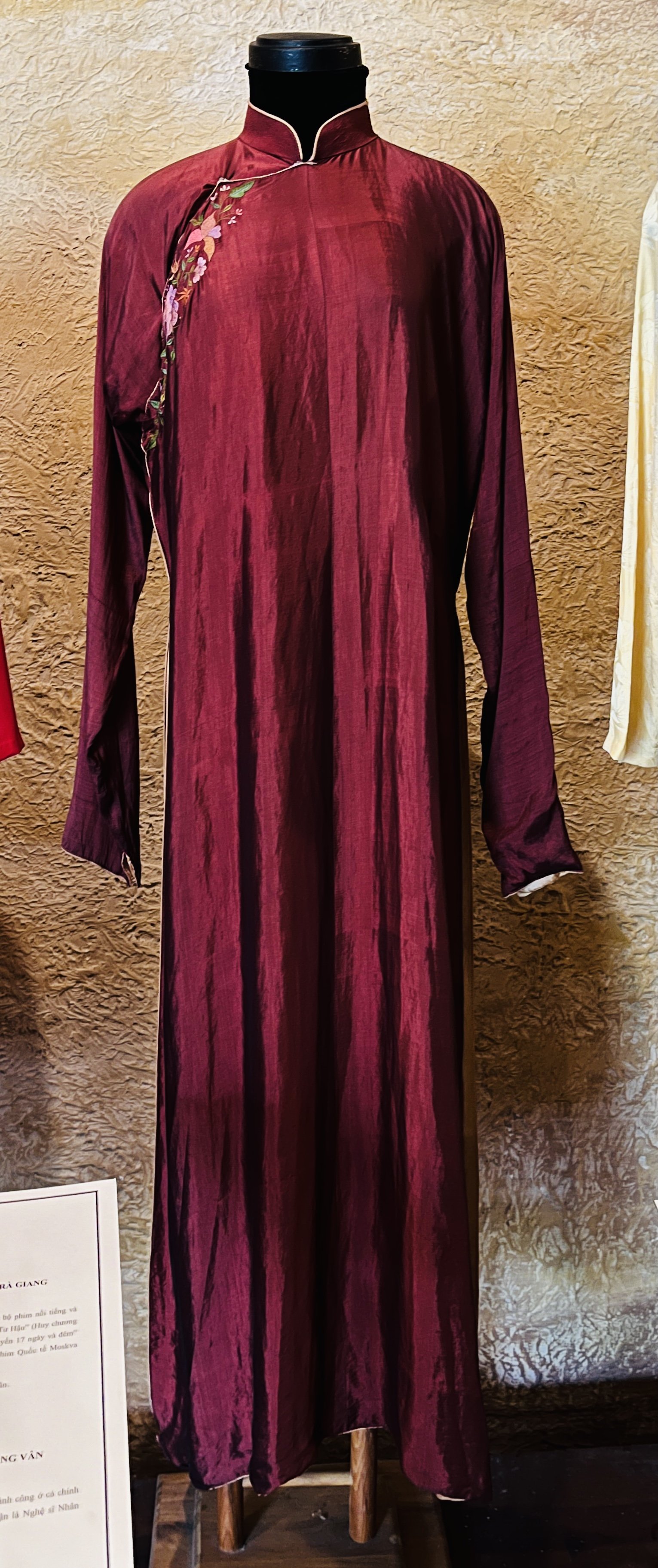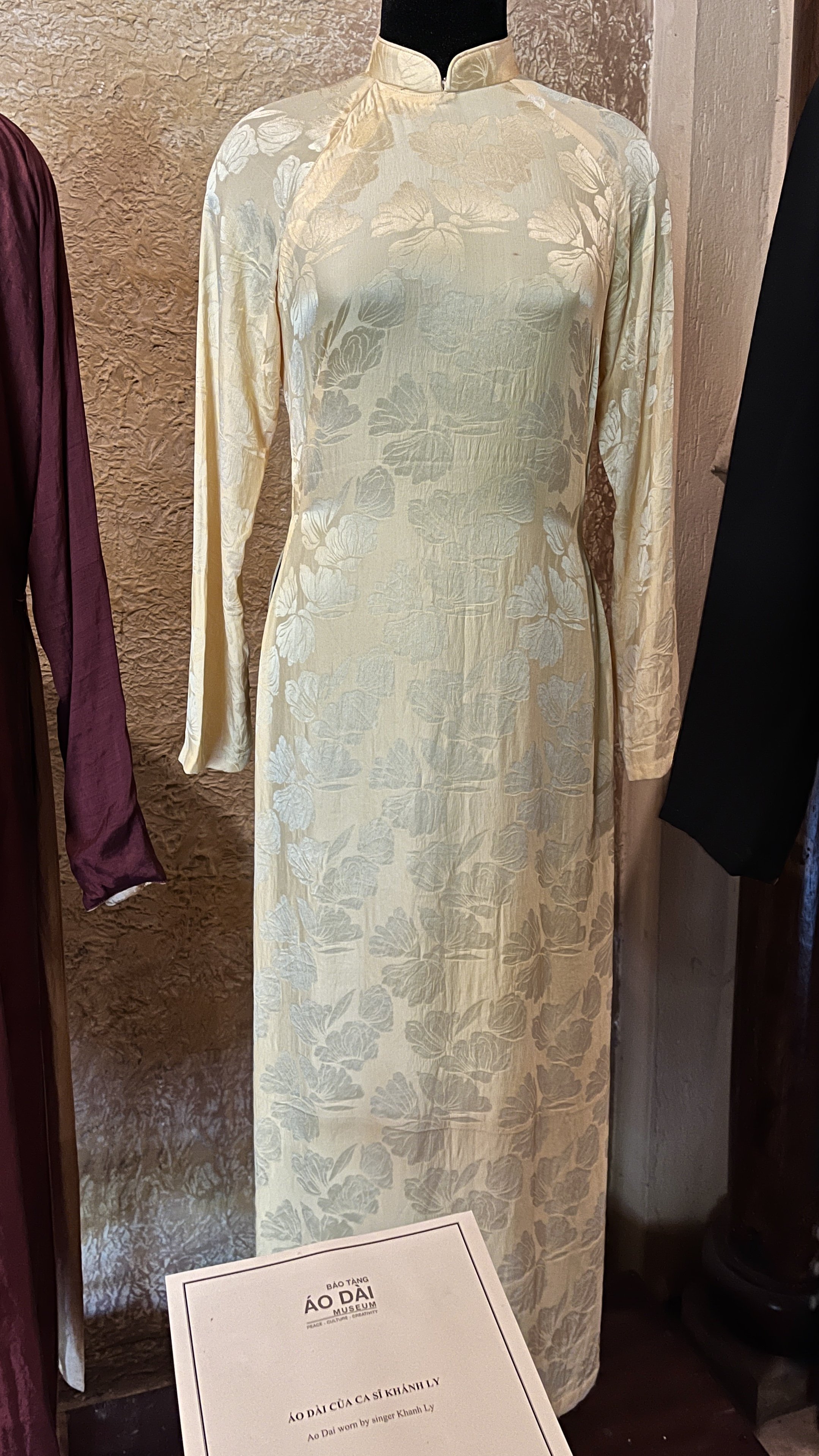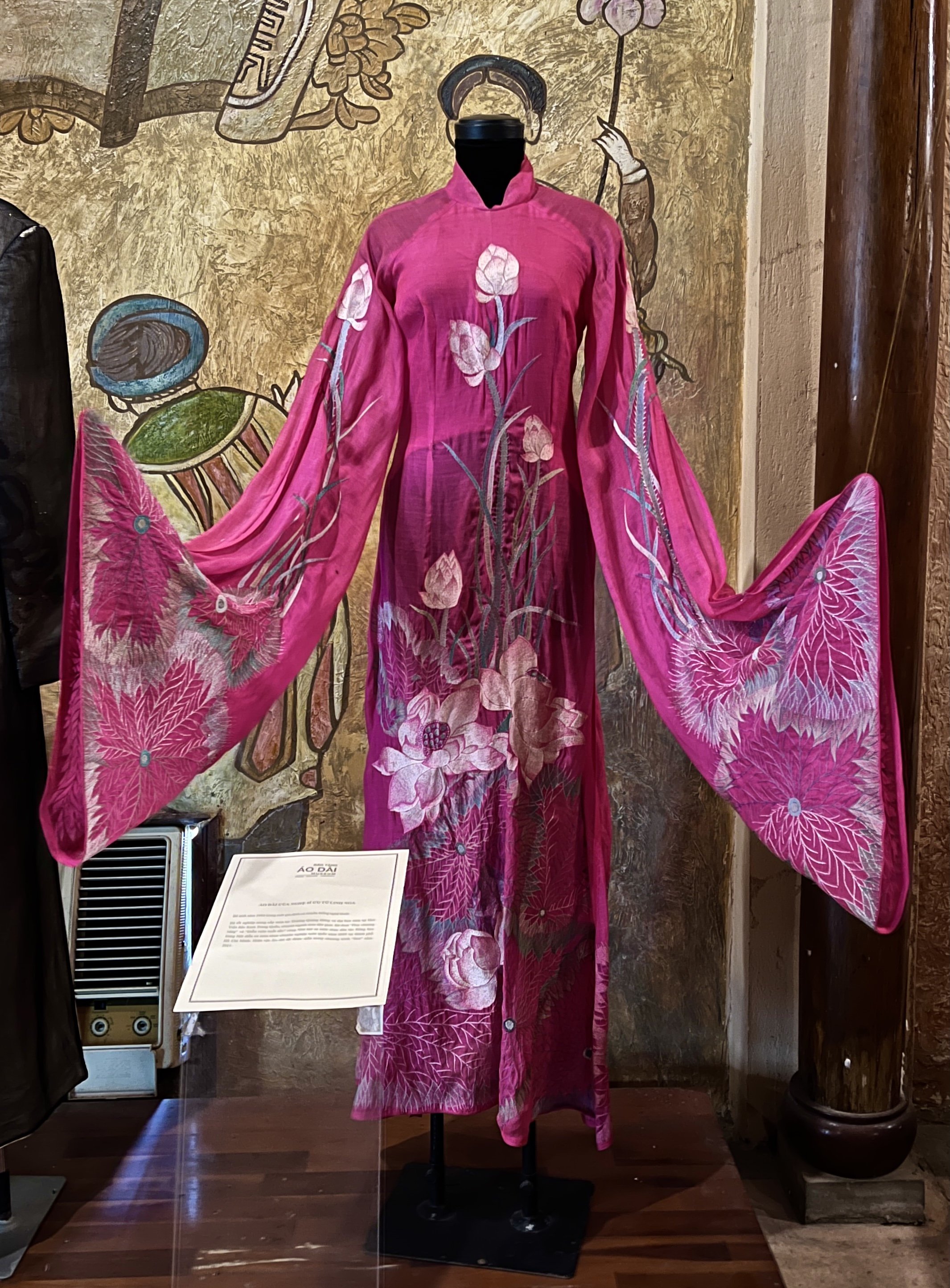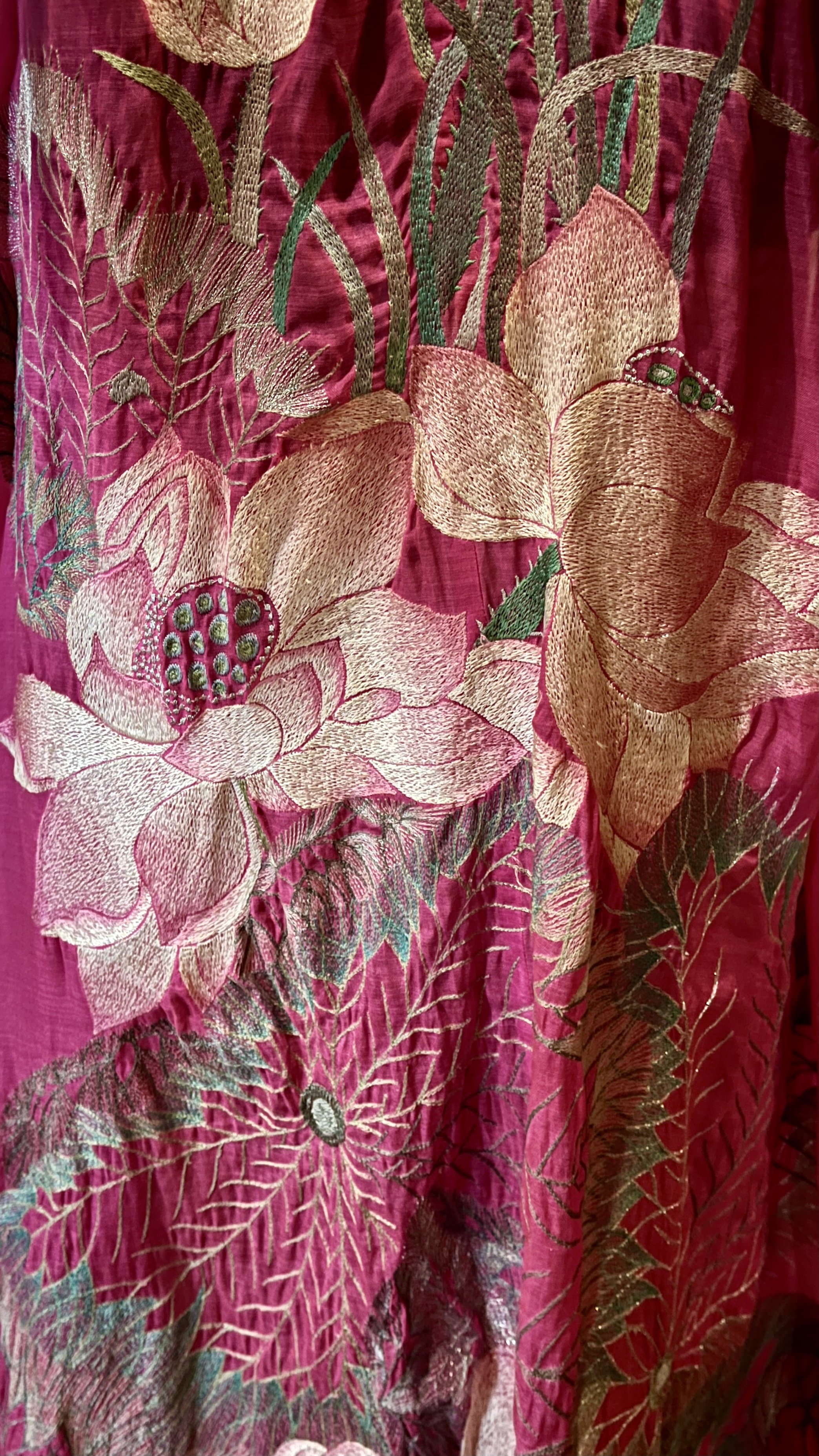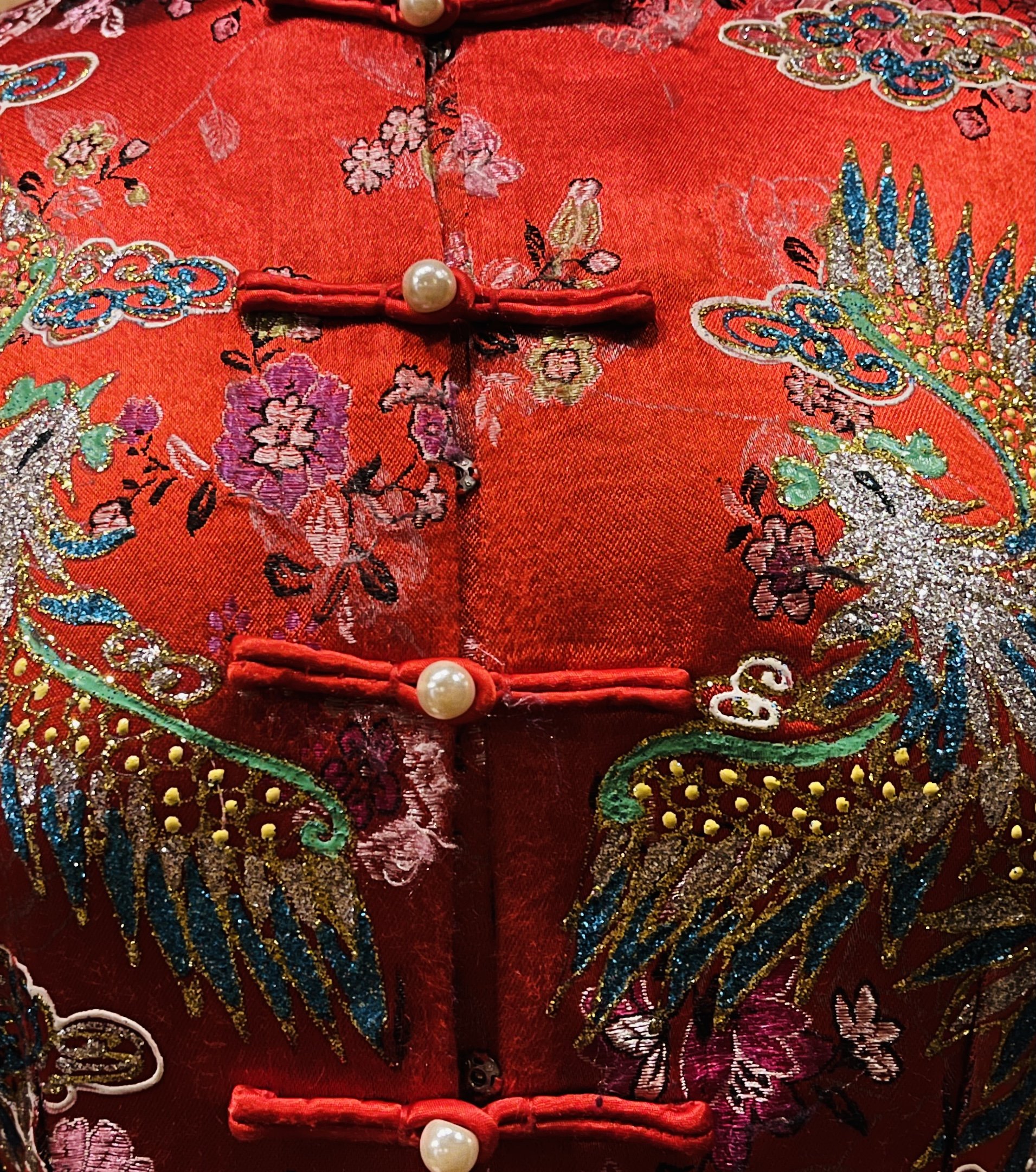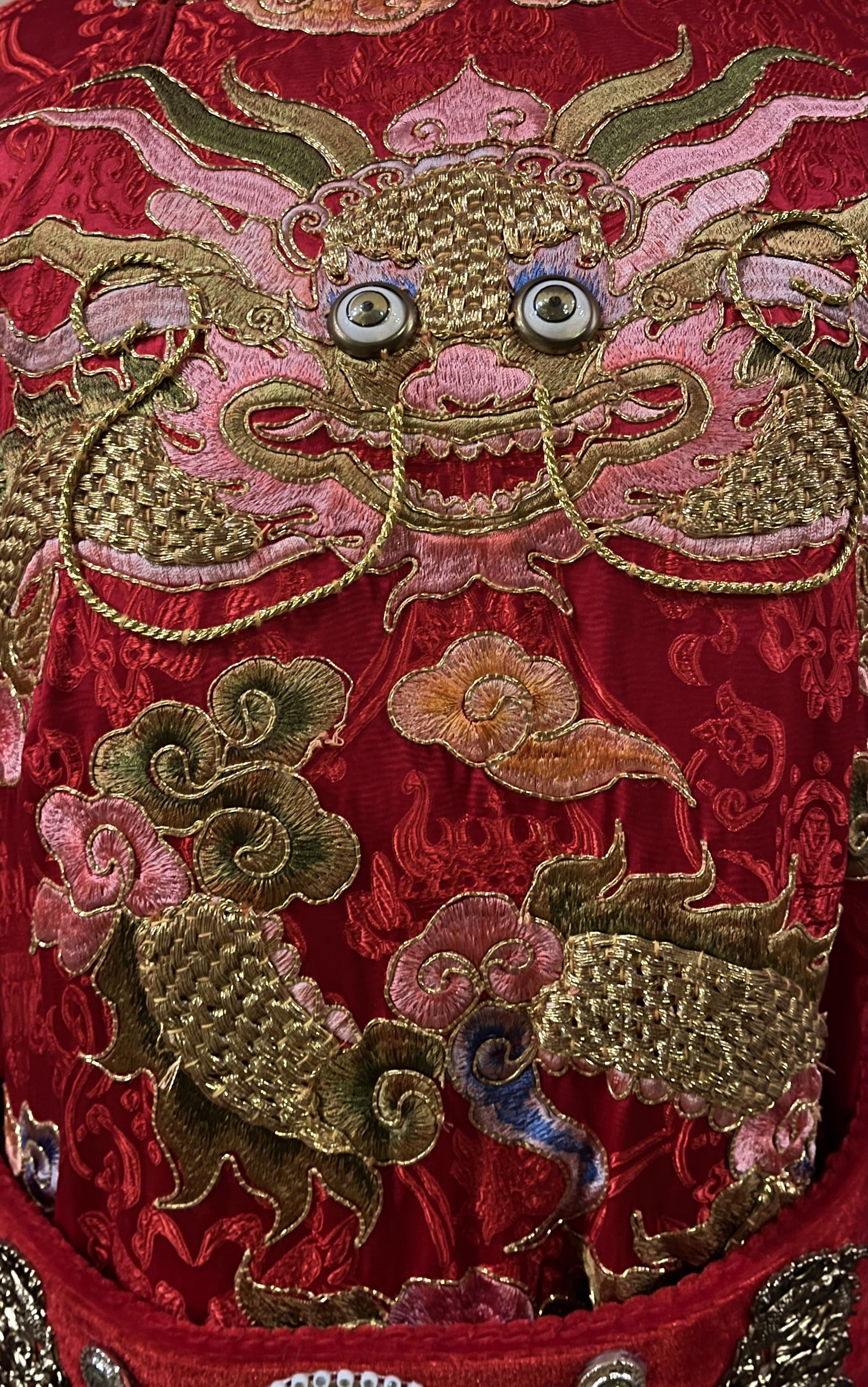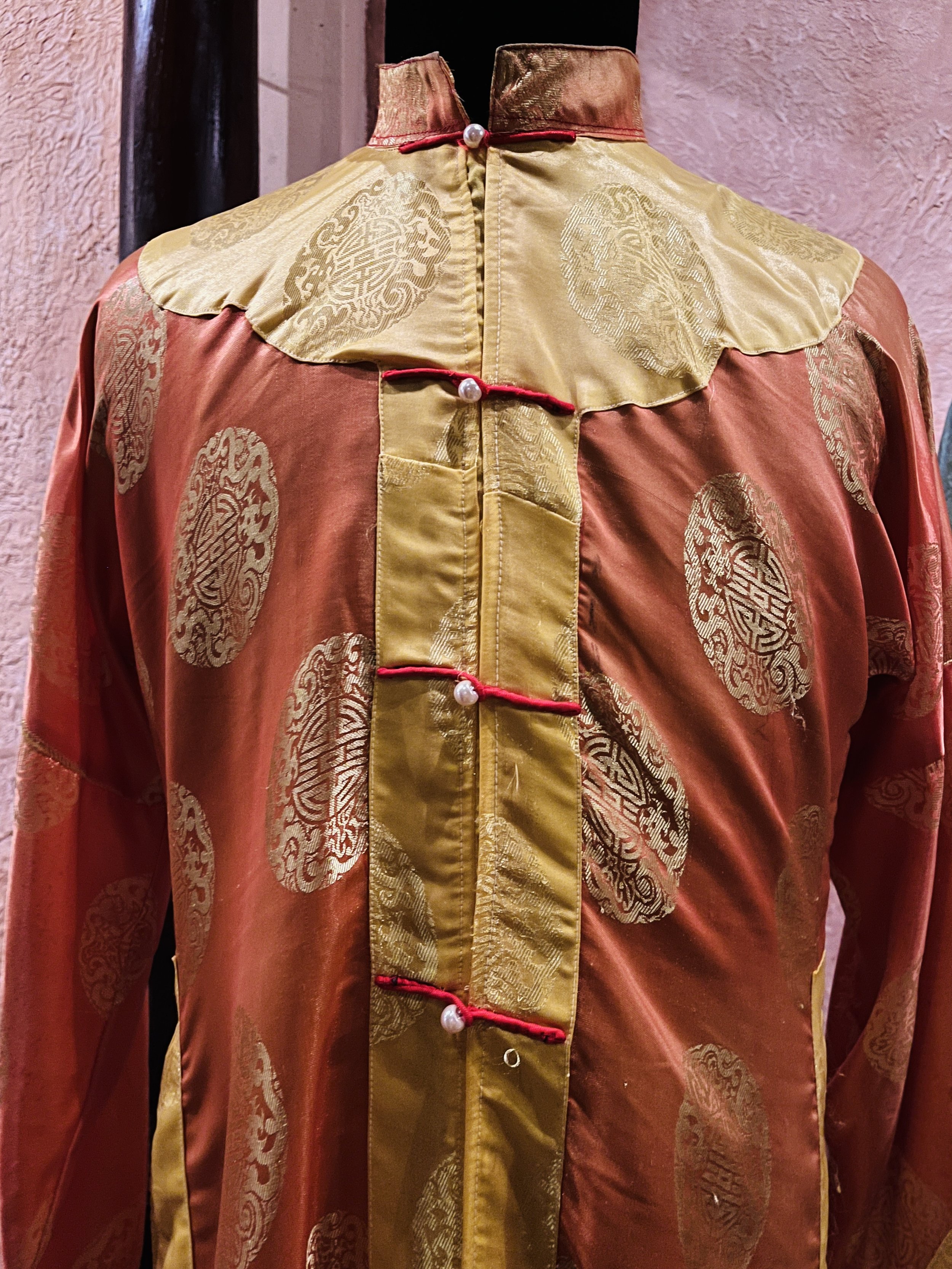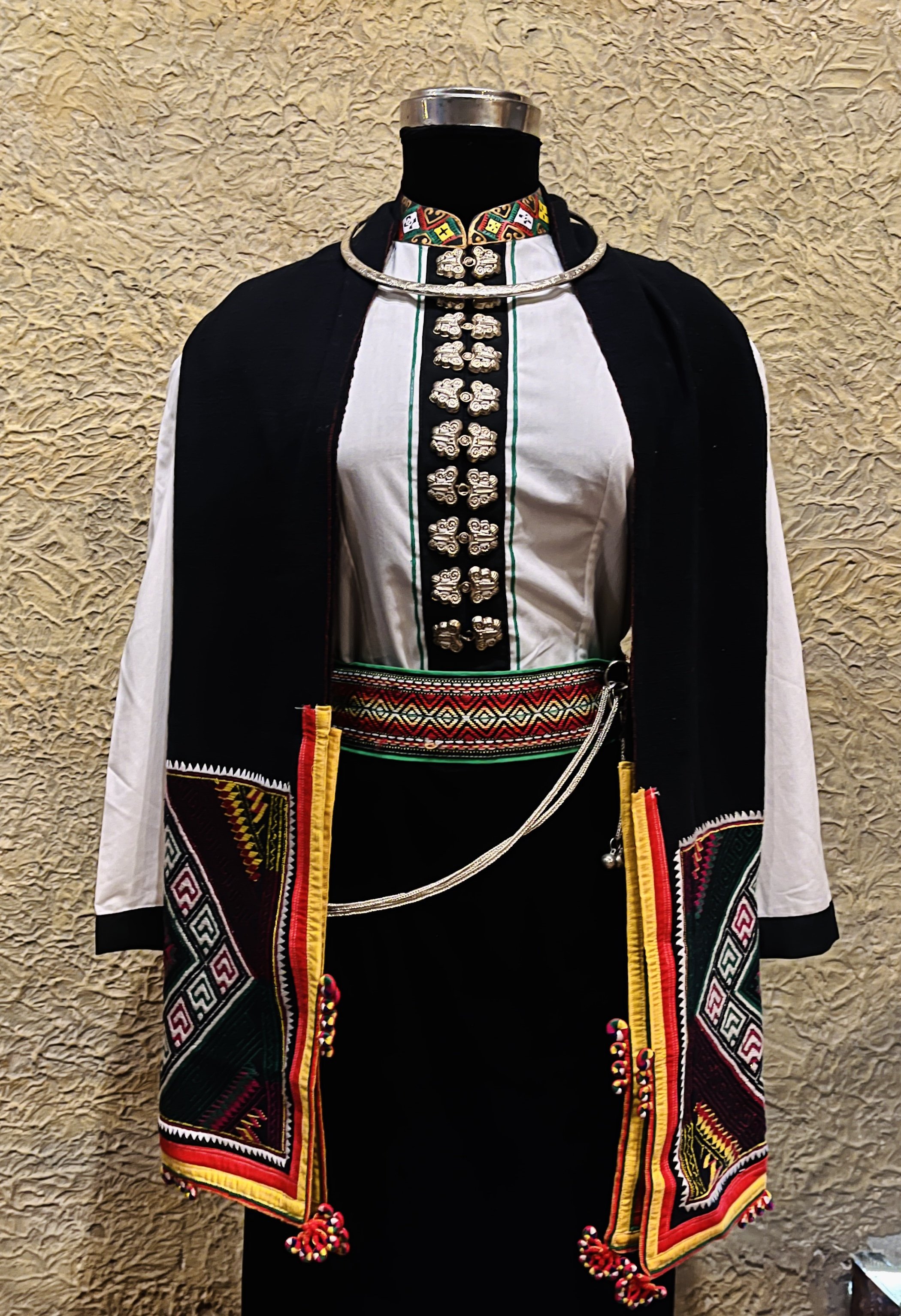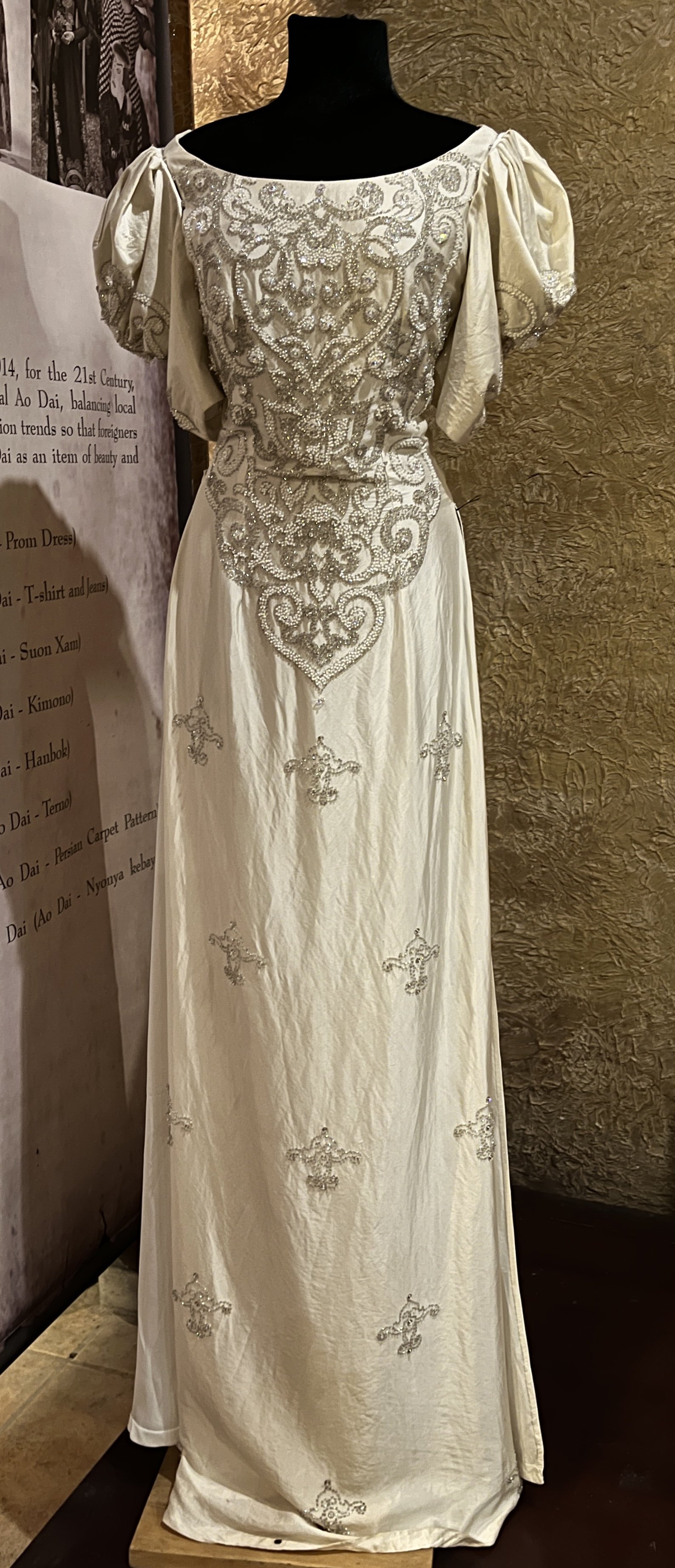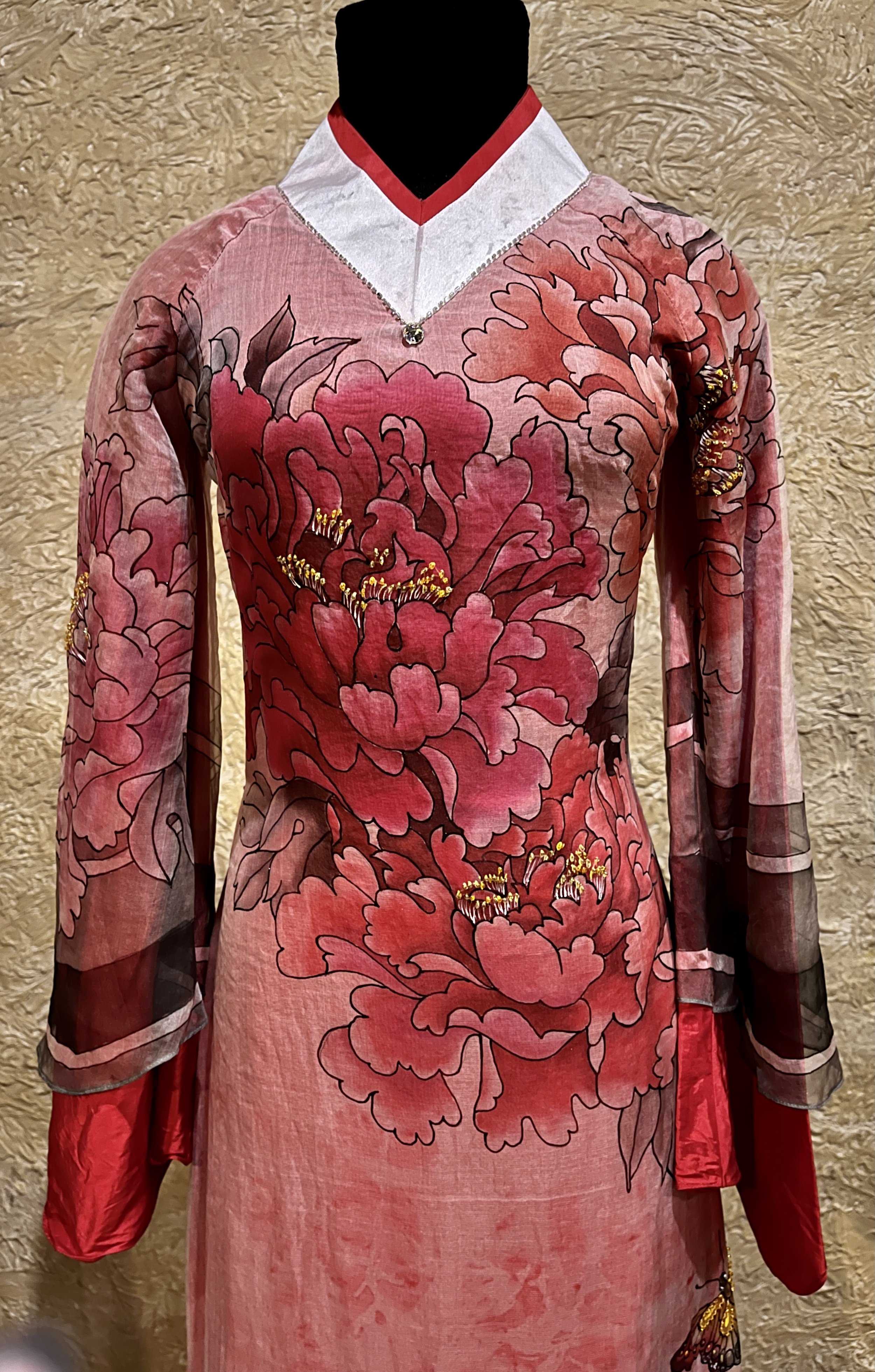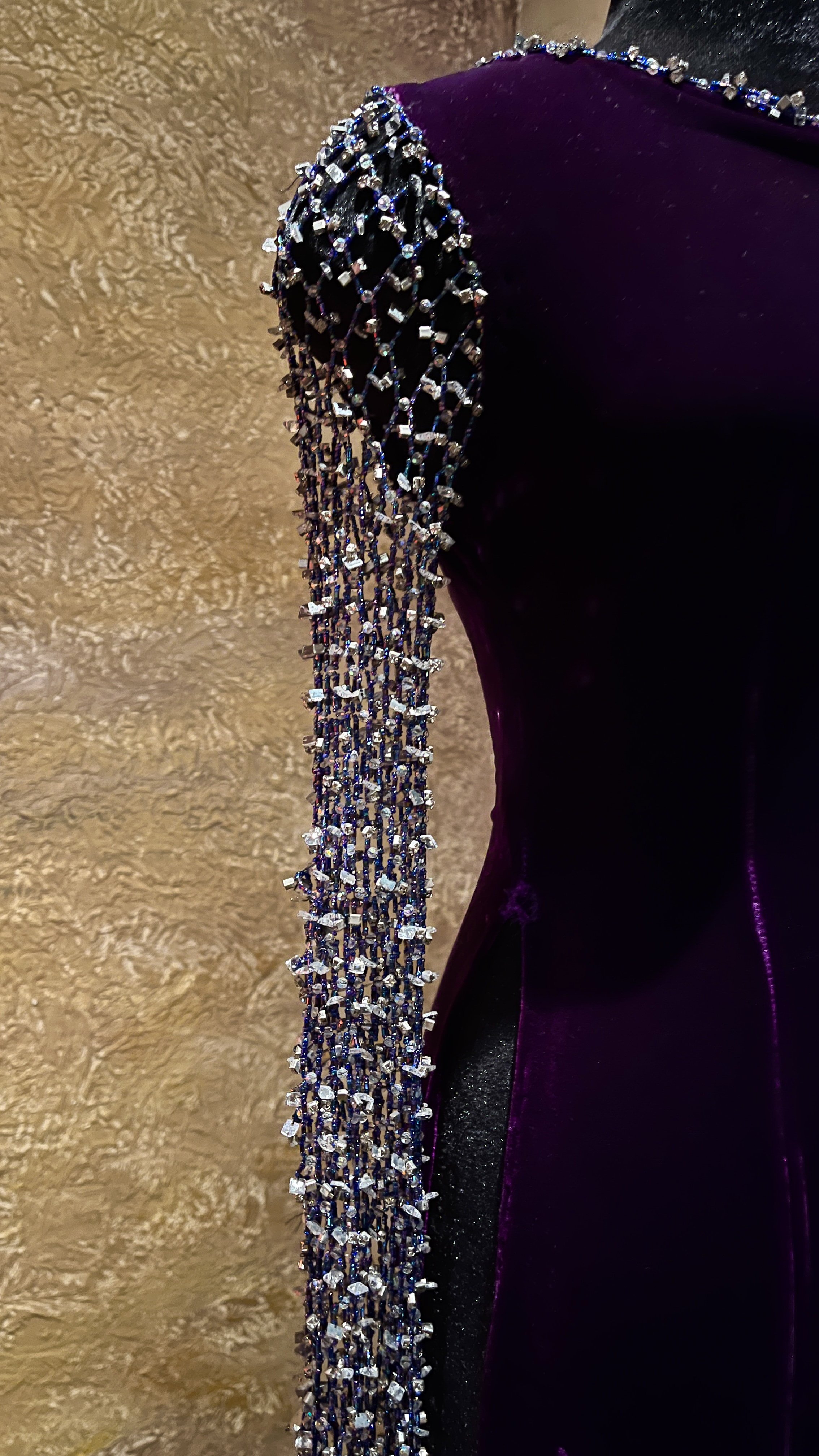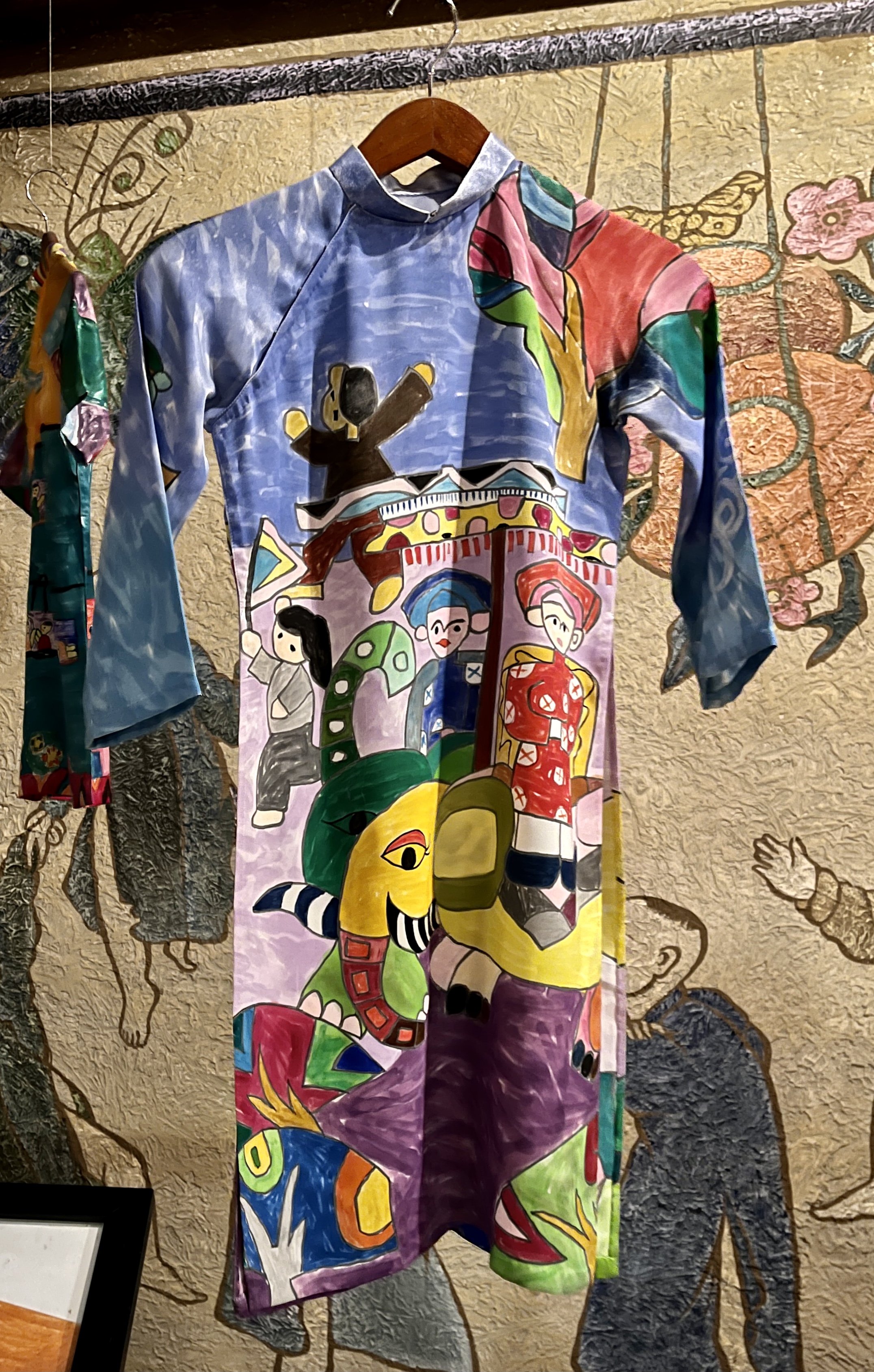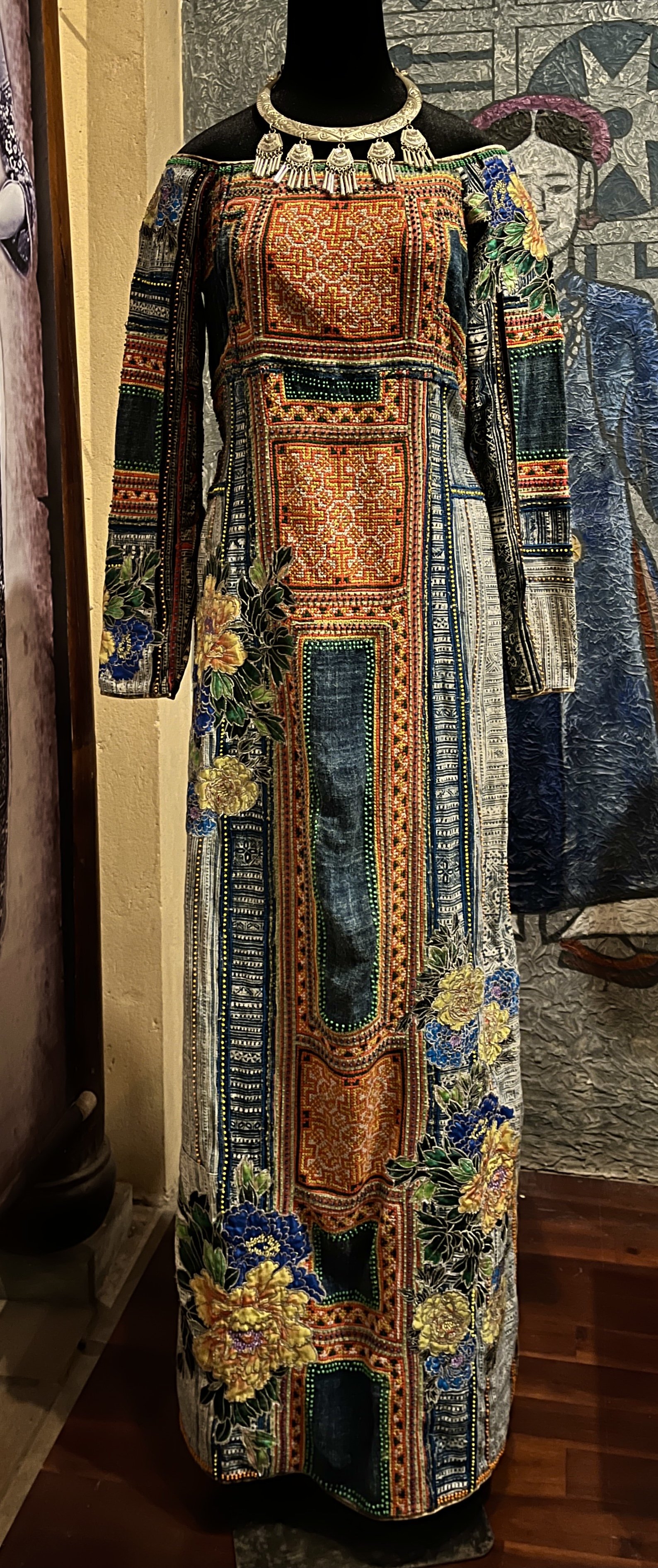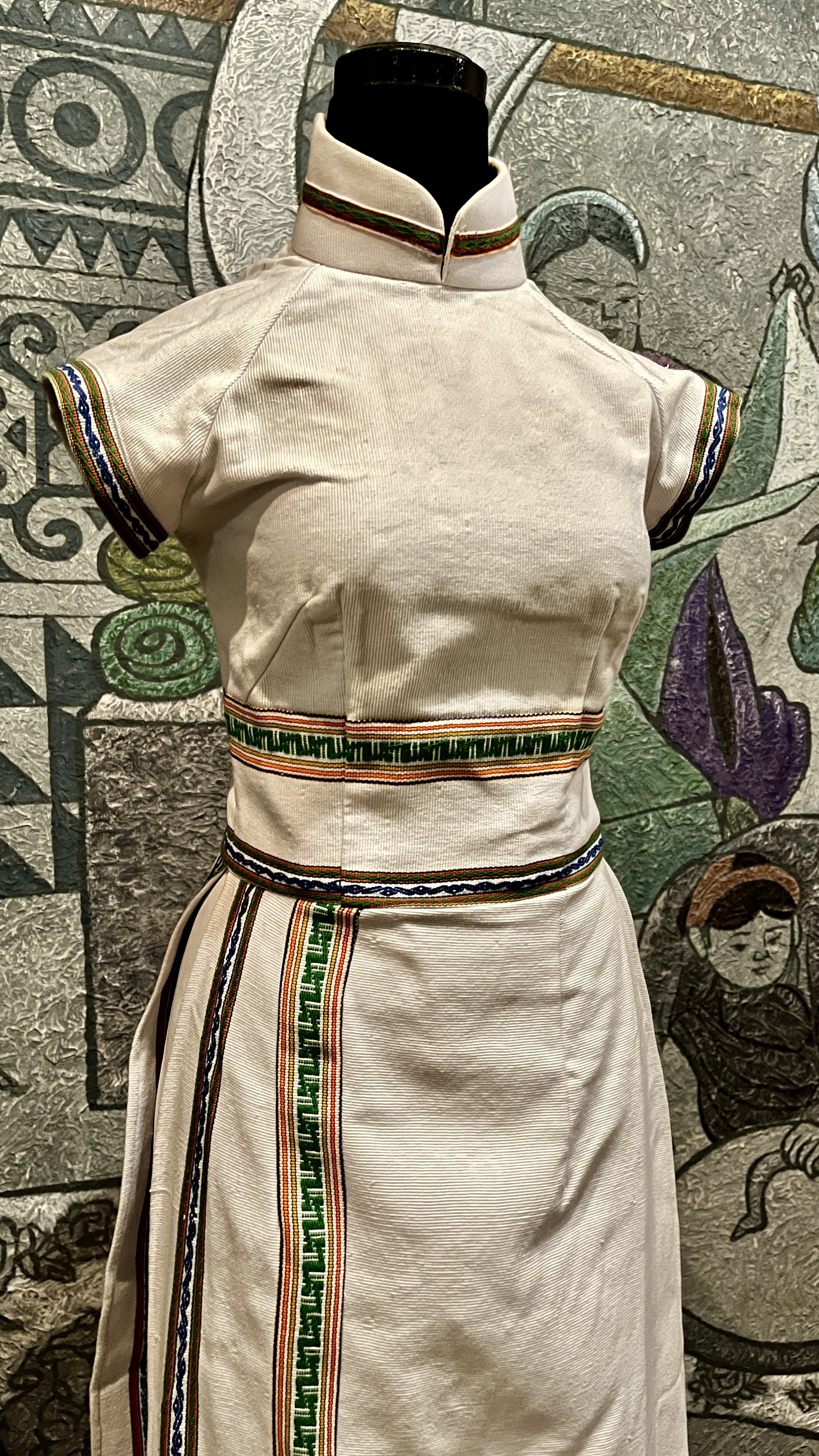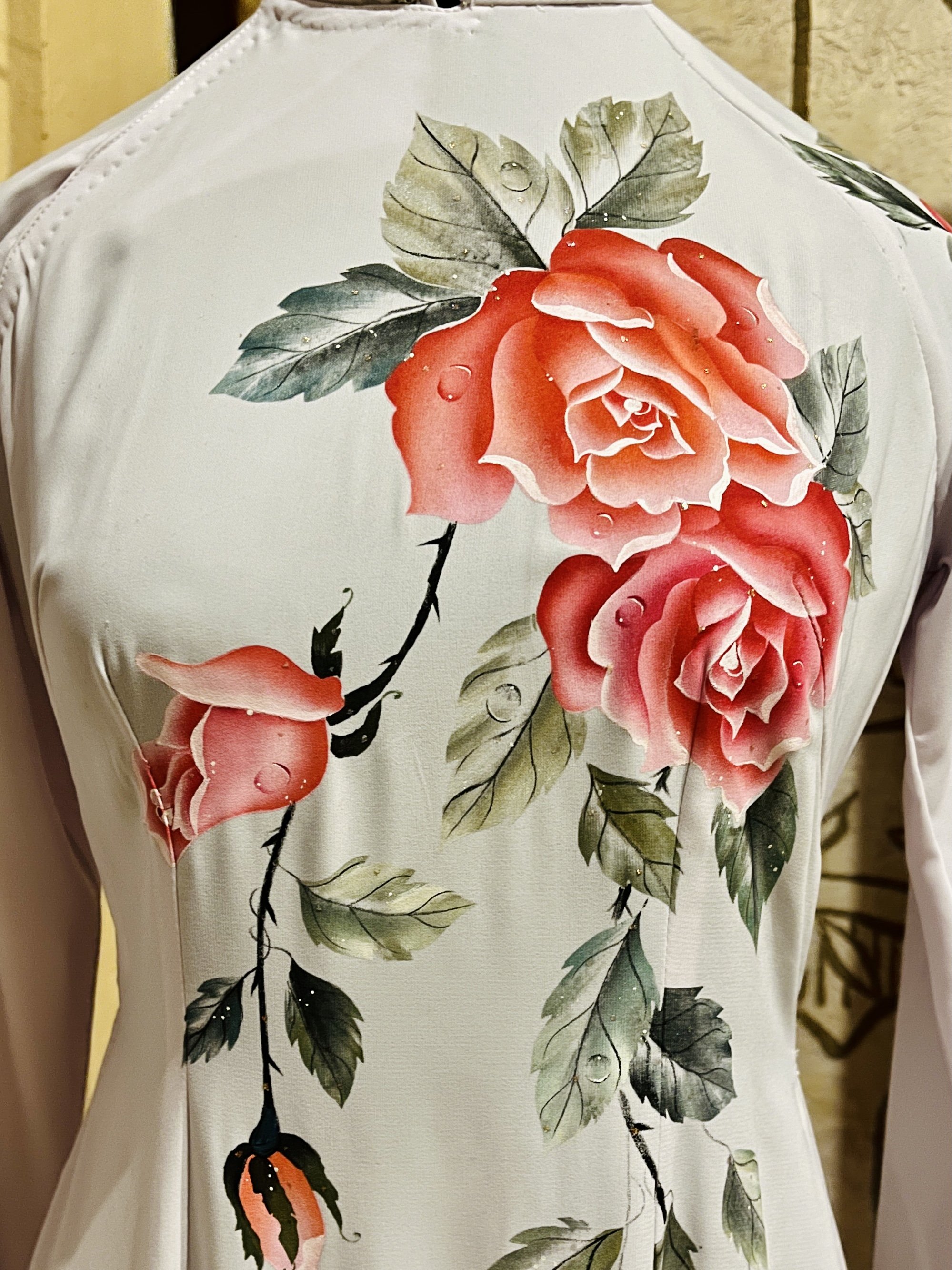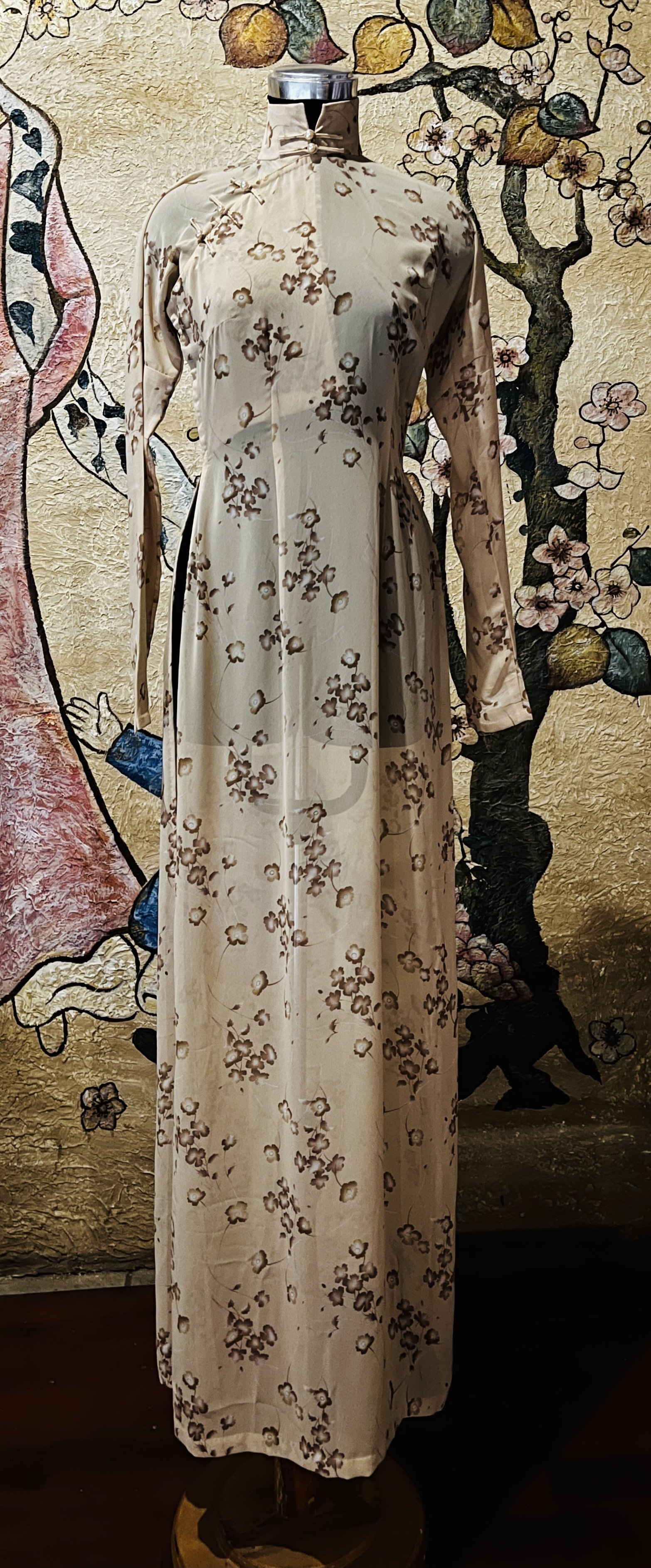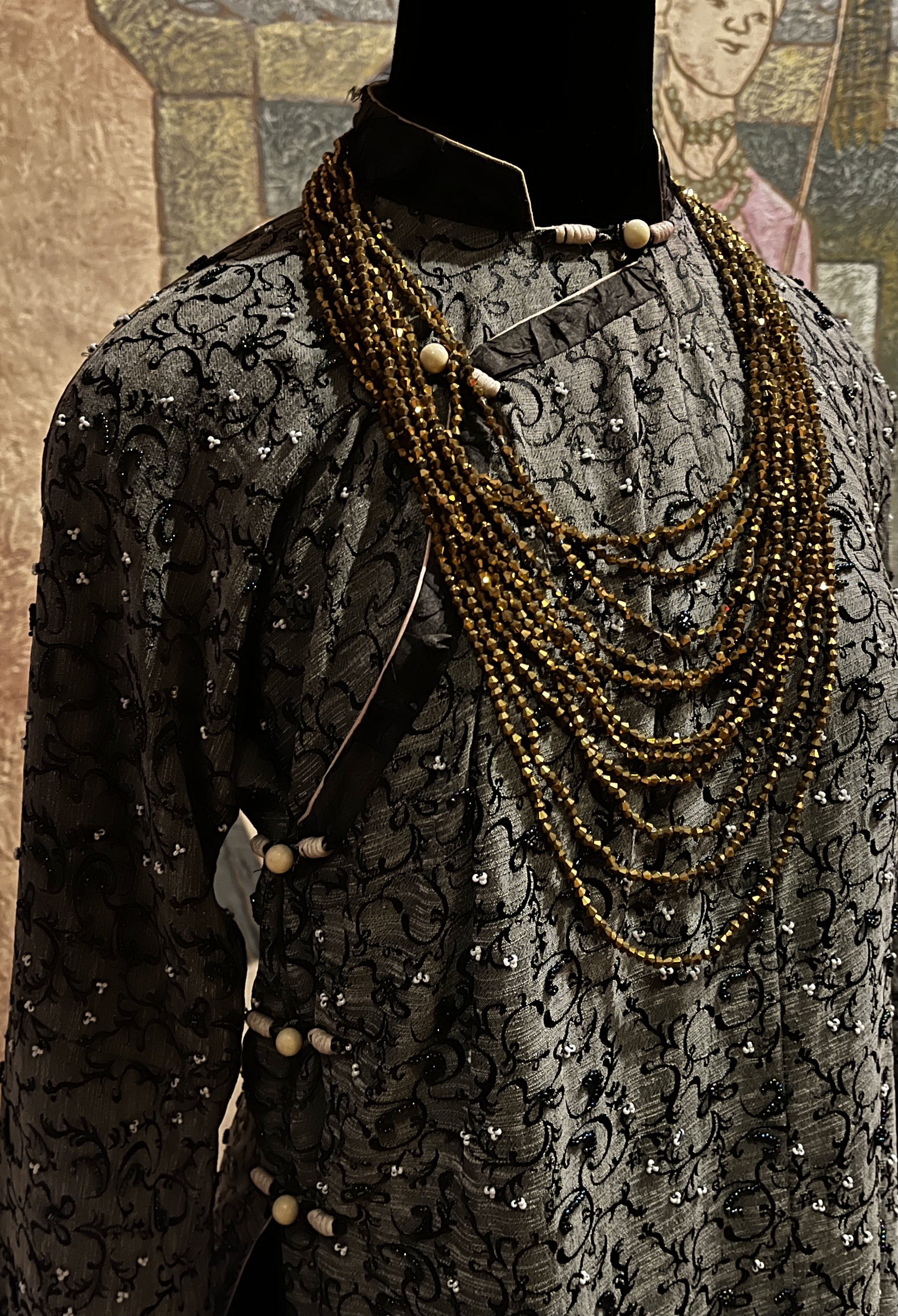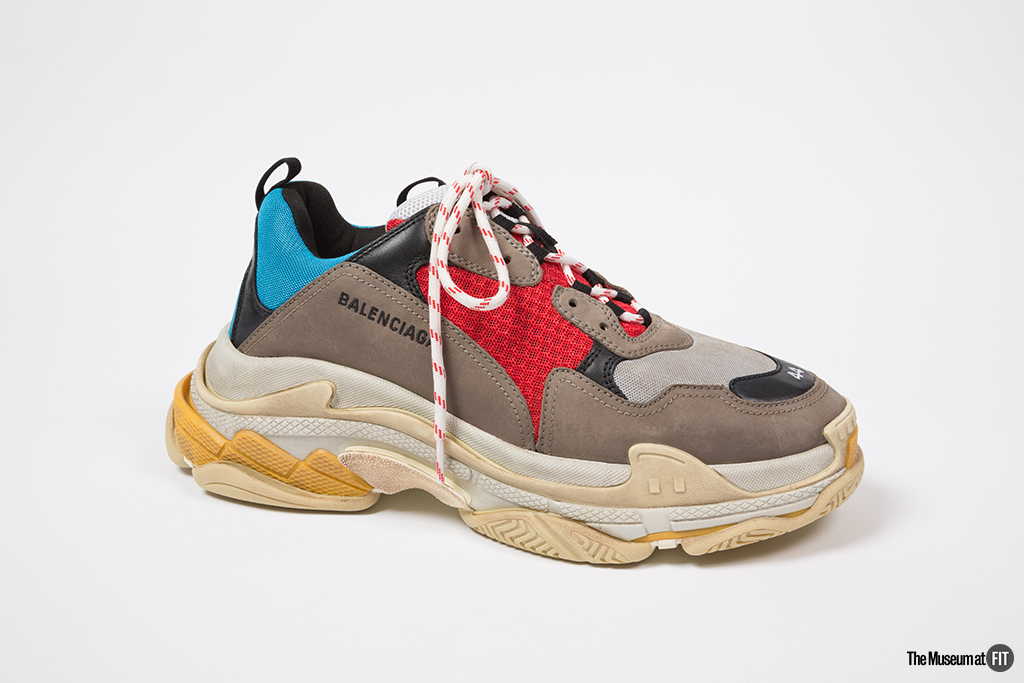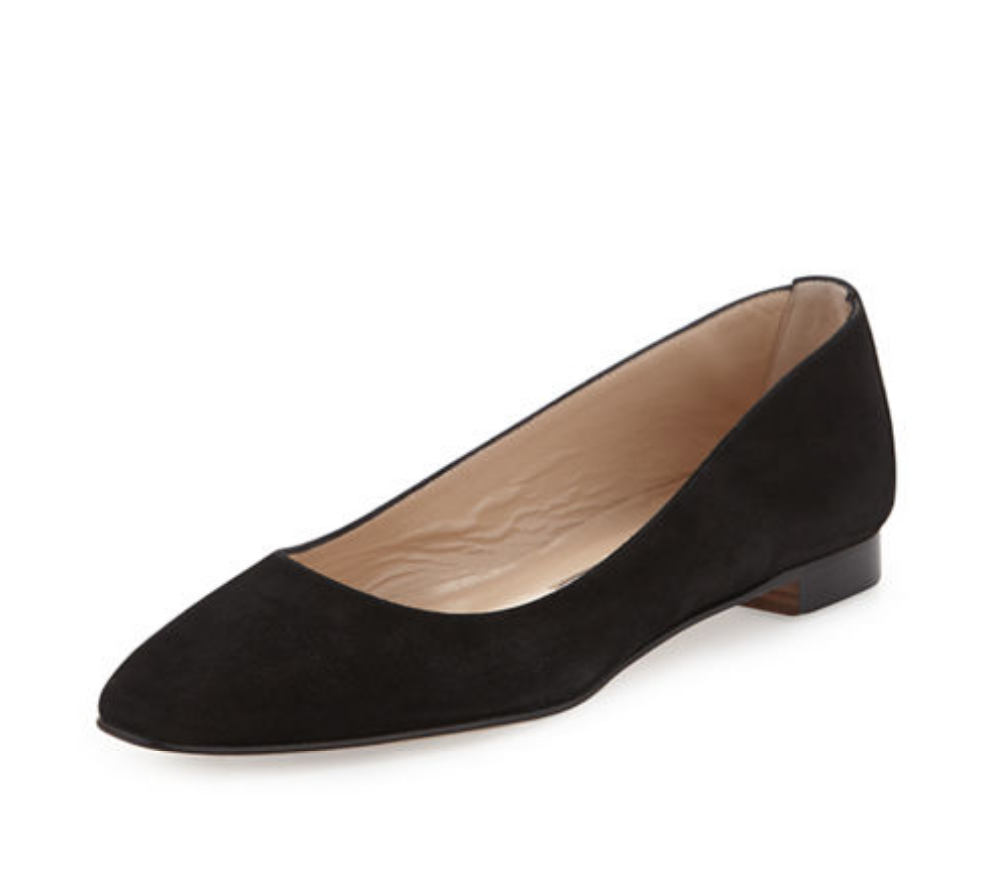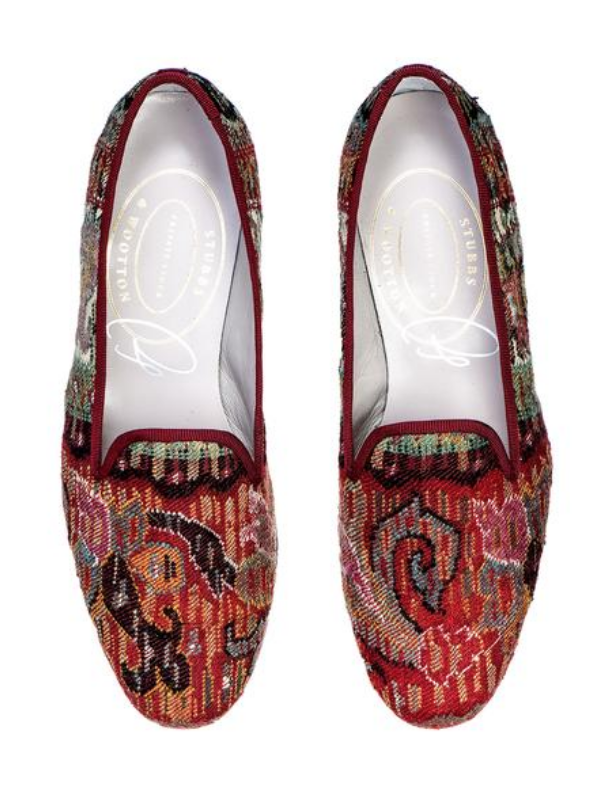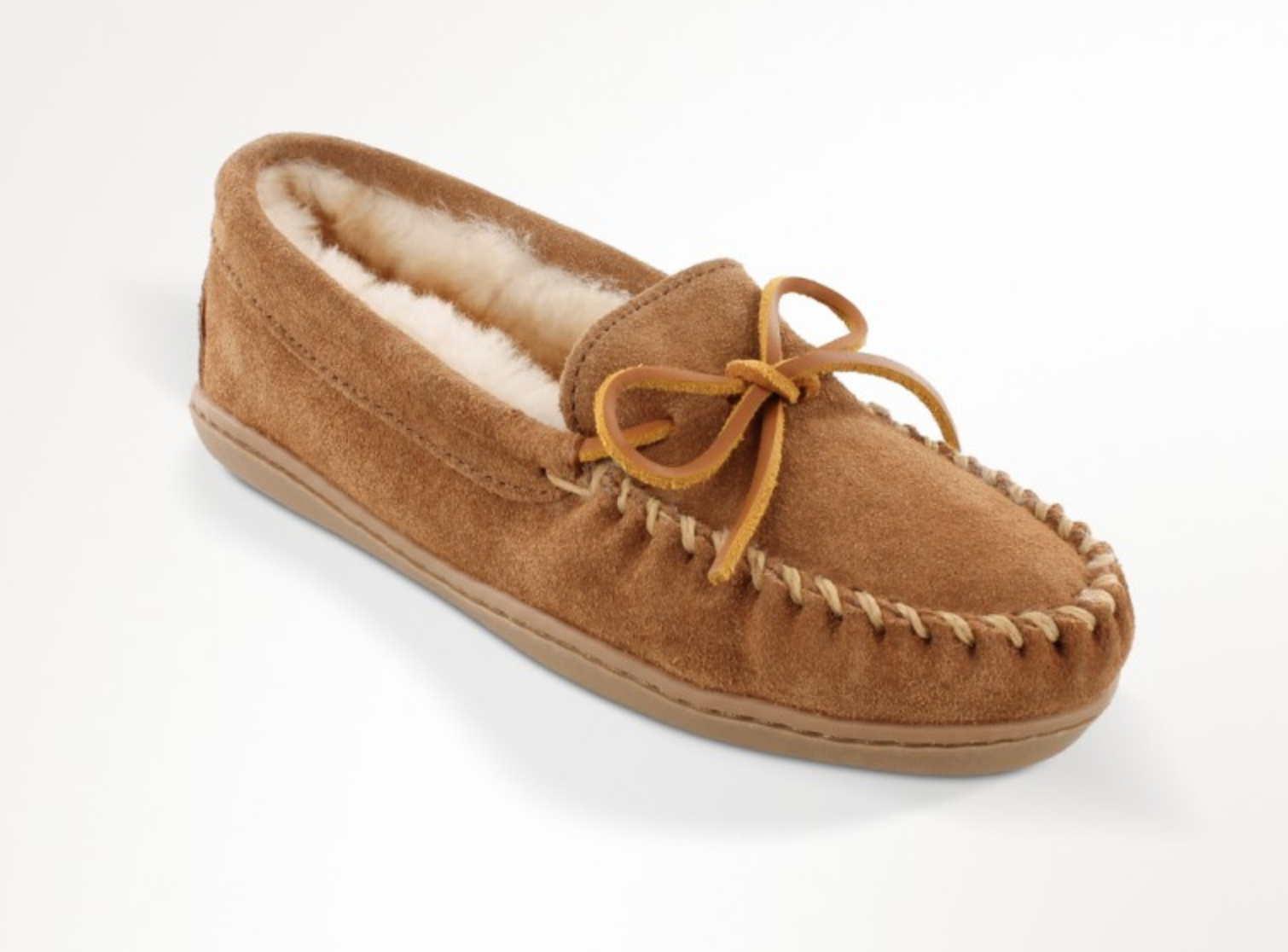Shopping in Siem Reap, Part 2: Couture & Heritage Textiles | Siem Reap, Cambodia
There are three places worth shopping in Siem Reap, but they will cost an arm and a leg (and another arm, thanks) and are only for fabric aficionados: Samatoa Lotus Farm, IKTT, and Golden Silk Pheach.
Samatoa Lotus Farm
For $35 (or sometimes $50? I think they undercharged me) you can take a tour of the Samatoa Lotus Farm and factory. They make lotus silk, one of the most expensive fabrics in the world. It is harvested by hand from lotus stalks, filament by filament.
First, the owner explains why lotus silk is special- it's incredibly absorbent and naturally antimicrobial, plus completely sustainable. You also learn about kapok fruit fabric and some natural dye options. During your craft portion, you break apart lotus stems and twist the wet filaments to make a buddhist thread-style candle, make a sort of rough paper from lotus pulp, make old-fashioned incense sticks, drink lotus tea, and string dried lotus seeds on a lotus silk yarn to make a bracelet. At sunset, you take a short motorbike ride to an absolutely impoverished little village on a lotus lake, where they take you out on a boat and you can take pictures of the beautiful flowers, and eat some fresh lotus seeds. It's a fantastic experience and excellent value.
It takes 3 weeks to harvest enough thread to make a single scarf, which then takes 9 days to weave. It’s a 100% ethical and sustainable business, with environmentally safe and renewable production and fairly paid workers. So, the goods they sell in their shop are inevitably somewhat expensive by today’s standards, where terrible human and environmental tolls are the norm in the fashion industry. Most products are simple, some exquisite, some (especially their vegan leather efforts) a bit ugly and experimental. Hairbands run around $60, belts $75, face masks $45. Their UNESCO prize winning scarf in a 50/50 silk/lotus silk blend is $400, a bucket hat $450.
I knew I wasn't buying immediately, so I didn't dare ask the price per meter for anything, but you can get a quote on their website. 6 or 7 meters of fabric in their UNESCO blend is on my wishlist for when I’ve saved something near what I think they’ll ask. Buying from businesses like this is the definition of putting your money where your mouth is!
If you want to visit, you absolutely must arrange with a tuktuk to take you there, wait for you, and take you back to your hotel. It is in the middle of nowhere (a solid 40 minute drive outside of Siem Reap proper), Grab doesn't work out there, there's no spot on the road to hail a motorbike or tuktuk, and locals get rowdy and drunk as soon as the sun goes down (especially the tuktuk and moto drivers!); you absolutely will get stranded in an unsafe situation if you don't have your own transport. Still worth the visit!
IKTT
You can visit the shop, or get the full experience and arrange via their website to visit the village and stay overnight there.
To quote the IKTT website: "The IKTT specialises in the revival of Khmer silk ikat. Throughout history Khmer silk weaving has been regarded among the best in the world, however, after years of war, this ancient art form nearly vanished. The beauty of such silk has been its savior. Founded in 1996 by Kikuo Morimoto, we take a purist approach to the reproduction of traditional textiles, not just by recreating the style but by following the traditional practice seen a thousand years ago in the ancient times of the Angkor Dynasty. To achieve this, we have re-planted a traditional forest to cultivate everything from the natural dyes to the silk in a rich natural environment."
The 'purist approach' is three-pronged: Cambodian golden silk worms; natural dyes from local plants; and hand spinning, tying for ikat, and weaving. Everything is done to the highest traditional standards; they offer some souvenir items like kerchiefs and shawls in solids or non-traditional oversized gingham, but every pidan (religious wall hanging) and sampot hol (women's ikat skirt) is traditional in every respect. They have their own mulberry tree forest and their own lac insect nests, prohut trees, almond trees, lychee trees, annato plants and wild Cambodian indigo plants to make their own dyes; around 160 people (those working in production and their families) live in their own old-fashioned weaving village; they use the dye techniques and around 200 weaving patterns handed down from their ancestors. I think one of the best things about shopping at IKTT is seeing the year your piece was made, the natural plant dyes used, and the weaver. You truly buy an heirloom, not just a skirt or a scarf. Being perfectly historic, all production is 100% organic and sustainable.
They seem to financially support themselves primarily through a Japanese clientele and network cultivated over 20+ years by their founder, but they do have a shop in Siem Reap and a strong instagram presence. Sampot hols are available at the shop, or by custom order; it takes 2-3 months for a sampot hol or pidan to be made, perhaps more depending on the season and intricacy. A traditional size Cambodian sampot hol is around 2 meters by 1 meter, perhaps a bit smaller; Cambodian women are quite small. A heavier woman can order an extra long version to ensure sufficient drape, but due to the dimensions of the traditional looms no skirt will be full length, or even ankle length, on anyone over 5'5" or so. Midori, the contact person, responds very quickly to any inquiry and will quote a price per meter for a design. For one of the traditional sampol hols, expect to pay around $600/meter. A complicated pidan will be more; a solid or simple stripe less. That breaks down to between $1000 and $2000 per skirt depending on the dyes, weave, size, time etc.
Golden Silk Pheach
Finally, there is Golden Silk Pheach. A Cambodian raised in France, Pheach's trajectory since returning to Cambodia has been much like the founder of IKTT's: she bought a small farm, planted mulberry trees, feeds them to indigienous Cambodian golden silk worms only, grows and buys local natural dyes only, and employs and trains local women in traditional techniques. The main difference is that while IKTT is primarily interested in providing historically accurate products, Pheach has a very refined aesthetic, and is able to use traditional techniques to create modern products that recall their traditional origins in the most elegant way.
A tour at Golden Silk is like a personal couture appointment with Pheach: she explains the history of Cambodian golden silk weaving since Angkorian times, and how the rare Cambodian golden silk worms are superior to the genetically modified white silkworms used elsewhere in the world. She also explains not only how ikat dying works, but where she gets her inspiration for her modern designs, and how they build custom looms for large textiles.
A small scarf at the shop is around $500; the larger and more intricate they get, they climb over $1000, $2000, etc. Some of the largest, most difficult designs can only be executed by an artisan with many years of experience, who then requires another 2 to 3 years of full-time work just to complete the piece.
Ao Dai Museum, HCMC | Vietnam
The Ao Dai museum is 18 km outside of HCMC, around a 45 minute drive. It’s far enough from the city for the sky to actually be vibrant and blue (as opposed to opaque, polluted white) and the layout features several traditional style buildings around a large pond. It’s perfect for an impromptu photo shoot, and several people were around doing just that, taking pictures and sharing their lunches in gazebos. Ducks, chickens, dogs, and puppies are semi-contained in their own areas, but roam with some freedom.
There’s a row of small traditional style two story attached houses, each with traditional costumes specific to a minority group or region, complete with pictures, explanations and even instruments or other props. There’s a hall full of children’s books and art supplies, where I assume activities are held during non-covid times. There are a couple offices, and a couple combo workshop/showrooms where presumably you can order an ao dai; they may be tied to the designer Si Hoang, who owns the place. All of the buildings are constructed with traditional Vietnamese wooden architectural elements in traditional styles, though not wholly so as they are adapted for modern use.
The main attraction is the hall of ao dai, featuring representative historic styles, examples from Vietnam’s current top designers (including more than a few by Si Hoang himself), costumes worn by famous performers of traditional Vietnamese music genres, and costumes or formalwear worn by other famous Vietnamese artists including writers and painters.
Disclaimer: though versions of the ao dai were part of court attire in the Northern and Southern kingdoms, the highly symbolic, rank based and regional nature of court attire is a complex topic deserving of its own post, so it’s not discussed in this one. This post focuses on the ao dai everyday women chose to wear.
Historic Vietnamese dress is generally less well attested than European dress, but extant illustrations and paintings show the evolution of Vietnam’s traditional costume, and how it compares to styles worn in China, Japan, and Korea in the same eras. Recognizable ao dai first appear in the mid 17th century, and are called 4 part ao dai, referring to the 4 pattern pieces of the simple wrap dress. The dress itself was typically brown, and worn over a long black skirt or very loose trousers; older women wore dark colored blouses underneath, while young women and girls wore white or pink blouses. A black waistband was often accentuated with a green or blue silk sash.
The 5part ao dai appeared around 200 years later, and mainly served to signal a higher social class than the 4 part ao dai. The 5th part is a hidden section that served as a combo bra and collar, and the overall appearance of the ao dai resembled Qing Dynasty costume much more closely, wrapping high above the bust, with a mandarin collar and five frog style button closures down the right side. Though the buttons had symbolic meaning (representing the 5 virtues of humanity, civility, gratitude, intellect and credibility), by the 1910s and 20s women were using invisible buttons and snaps instead, as flat hardware-free dresses were considered easier to wear jewelry with.
In the 1930s, Lemur (Nguyen Cat Tuong) became Vietnam’s most famous fashion designer, introducing European styles and trends into ao dai design. For example, you could order traditional narrow sleeves . . . or short sleeves, or puff sleeves, or flared sleeves, or no sleeves! Your ao dai could be short or long, collar or no collar, buttons or no buttons; it could be made for any occasion from a wedding to an afternoon at the beach. His designs were also cut closer to the body (though still loose fit by modern standards) and deemed outré by many. He disappeared at the too young age of 34 (captured by the French militia during their retaking of Hanoi in 1946) making his creations iconic collectibles.
The next lasting change to the ao dai happened in the early 1950s: the tightly fitted, cinched waist look was born, though balanced somewhat by high mandarin collars and generally longer lengths. One of the first fashion-related cultural differences that struck me when I arrived in Vietnam was how it is considered slutty/disrespectful to actually show any skin like cleavage, thighs, or even just shoulders . . . but it’s somehow OK to wear a completely see-through, skin tight ao dai with a brightly colored pushup bra underneath. An acquaintance explained “the Vietnamese woman’s ‘secret’ is to show nothing but reveal everything.”
In the late ‘50s and ‘60s, ao dai became a fashion item, reflecting international trends including boatnecks, raglan sleeves, psychedelic prints, midi lengths, and lots of variation on the trousers (cigarette style, palazzos, bell bottoms etc.) Though Western style daywear had become the norm, the fights for independence and reunification also inspired young people to wear more traditional clothing as a patriotic gesture.
Following Vietnam opening up its economy in the very late 80s and 90s, ao dai became a high fashion item, with domestic designers expanding the role of ao dai beyond costume, formalwear and granny attire. If you’re curious as to who Vietnam’s eminent ao dai designers are today, look no further than the museum’s board of directors: Si Hoang, Minh Hanh, Cong Tri, Vu Viet Ha, Thuy, Nguyen Si Toan, Nga Phan, Nguyen Ngoc Nga, and My Hao.
I found my visit to be a worthy use of a morning despite the hour and half of car time, particularly due to the beautiful scenery. However, if you are a serious textile or fashion nerd, there’s not a lot of info here, even less of it in English, and just one or two examples of each era defining style. So, a nice experience overall, but don’t expect climate controlled displays, acid free swatch albums, etc. There are reference books on display; if I ever find the one about Lemur in a bookshop I’ll definitely pick it up!
Etro's Paisley Inspiration at the Cooper Hewitt
Recently the Cooper Hewitt Design Museum in New York City put up an interesting exhibit of the historic textiles that inspired Veronica Etro’s Spring/Summer 2018 Tree of Life collection.
While I’ve owned the odd piece (a hair turban, a bikini, a silk chiffon scarf, a pair of velvet flats . . . ) I’ve never been fully at home with Etro.
On one hand I so enjoy the school of fashion design they embody: multigenerational Italian family business; super-luxe textiles; intense and intricate details and trim, always. Though the company was founded in the 60s and sourced its signature swirling paisley in India, it very much gives me those Renaissance Venetian trade goods vibes.
The Etro DNA that doesn’t flatter me personally includes the palette (olive, mustard, merlot and lime always reappear), and the tendency of the garments to “wear me”. For those reasons, it’s much easier for me to incorporate the Etro home collection into my life than the womenswear.
To be clear, these are not criticisms! Etro is beautifully designed and produced, and perfectly focused for a specific woman, I’m just not the Etro woman in terms of coloring/personality.
I still enjoyed the exhibit, which showed how artifacts in the Etro archive directly influenced the silhouettes, prints and embellishments in the S/S 2018 collection.
Paisley provokes such strong associations: the wall hanging purchased during a gap year, the shawl on the piano in spaghetti Westerns, the underside of patio umbrellas in the 70s.
There’s no symbolism with paisley, just abstraction. Paisley gets you thinking! And the more time you spend staring at the intricacy of the iterations, the more likely your brain will leap from thinking to dreaming . . .
Minimalism/Maximalism: The Museum at the Fashion Institute of Technology 50th Anniversary Exhibit
photographing a circa 1875 American top hat
The 50th Anniversary Exhibit at the Museum at the Fashion Institute of Technology is themed Minimalism/Maximalism, and pairs costumes from the late 18th century through 2019. The couplings are meant to demonstrate that minimalism and maximalism not only cycle (alternately dominate era by era) over time, but become stylistically more or less distinguishable depending on other elements in the zeitgeist (media, politics, economics, etc.)
Is minimalism just maximalism directed inwards? John Galliano discusses his concept for Maison Martin Margiela’s Spring 2019 collection, “Artisanal”
Listening to John Galliano explain his inspiration for the Margiela Spring 2019 collection (“Artisanal”) was incredibly interesting not just in terms of following another person’s philosophical journey, but also due to his dreamy suggestiveness contrasting so sharply with the remainder of the exhibit, which features explicitly iconic trend pieces only.
Anrealage Fall 2018
Anrealage Fall 2018
Walking through, I had my own revelation— we consumers of fashion take so much of it personally! We credit our desires for less AND more to personal growth/exploration/actualization rather than a heavily manipulated environment; taking on the less/more cycle as a matter of personal choice feels like the correct intellectual step, but also imposes an emotional burden.
Narciso Rodriguez Spring 2011
Comme des Garçons Spring 2018
Narciso Rodriguez Spring 2011; Comme des Garçons Spring 2018
Narciso Rodriguez Spring 2011; Comme des Garçons Spring 2018
The flipside of disempowerment is relief. I don’t like the idea that I have been manipulated by design and marketing trends into self-destructive consumerism, and knowing I hit the dead end of a path that was supposed to lead to self actualization really adds insult to injury! On the other hand, knowing I’m not uniquely stupid or silly or superficial (and therefore I shouldn’t feel uniquely guilty) gives me closure. As I walked the darkened exhibit loop, occasionally stung by nostalgia, I actually went through the 5 stages of grief!
Yves Saint Laurent F/W 1965-66
Yves Saint Laurent F/W 1965-66
Yves Saint Laurent F/W 1965-66; Jil Sander Spring 1996; Akris Spring 2017
Yves Saint Laurent F/W 1965-66; Jil Sander Spring 1996; Akris Spring 2017
Yohji Yamamoto F/W 1991
Yohji Yamamoto F/W 1991
Agatha Ruiz de la Prada S/S 2014
Comme des Garçons Spring 2017
Zandra Rhodes F/W 1981
Comme des Garçons Spring 2017; Agatha Ruiz de la Prada S/S 2014; Zandra Rhodes F/W 1981
Iris van Herpen & Jólan van der Wiel 2015
Christian Lacroix Spring 1991; Etro Fall 2013
Christian Lacroix Spring 1991; Etro Fall 2013
DENIAL: Did maximalism and minimalism really figure as much in my purchasing as practicality? Was occasionally purchasing for my fantasy self to keep my dreams alive really so impractical? Did I really need to re-evaluate my relationship to maximalism and minimalism beyond superficial taste in garments?
circa 1780 French silk waistcoat
circa 1785 French court suit
circa 1785 French court suit
circa 1775-1780 English evening shoes
circa 1808 French shoes
circal 1780-90 French or English suit
circa 1780-1790 French or English silk velvet suit; circa 18033-1805 American cotton muslin dress
Circa 1850 American made “Dandy” ensemble
ANGER: If I hadn’t had an emotionally deprived childhood my material desires wouldn’t be so perversely extravagant! Also, how could I have hurt myself so much, stolen from my future, my health, my pets, my boyfriends, because I preferred to spend my attention and funds on shopping for beautiful things? I could have had a house, a kid, a stock portfolio . . .and all that fancy stuff just makes me feel overwhelmed when I don’t wear it, and a bit of impostor syndrome when I do. An emotional pyramid scheme!
circa 1855 American dress
circa 1883 Worth evening gown
circa 1883 Worth evening gown
circa 1908 Suzanne Talbot hat
circa 1908 Suzanne Talbot hat
Callot Soeurs circa 1909; Brooks Brothers circa 1907
Callot Soeurs circa 1909
Callot Soeurs circa 1909
Callot Soeurs circa 1909
American cycling hat circa 1895
Madame Agnès cloche circa 1929; American cycling hat circa 1895
circa 1916 American denim walking suit
circa 1929 French wool ensemble
circa 1916 American denim walking suit; circa 1927 silk Gabrielle Chanel dress; circa 1929 French wool ensemble
America panne velvet circa 1925
BARGAINING: From now on I’ll be minimal in my number of garments, maximal only in their nature. Starting now I will keep a steady weight so I don’t waste money buying wardrobes for iterations of myself in a 50 pound range. Once my body is right I will set a strict budget, research trends and plan my seasonal purchasing. I will only buy blue chip pieces I can easily resell . . .
circa 1928 American flapper dress
circa 1928 American flapper dress
circa 1928 American “Flapper” dress; circa 1926 American evening dress; Cheney Brothers curtain panel circa 1930
Fenton Footwear circa 1929
circa 1922 French evening bag
circa 1925 American headband
circa 1926 American evening coat
Muriel King 1932; Elizabeth Hawes 1930
circa 1930 American evening gown
circa 1930 American evening gown; 1938 Elsa Schiaparelli handbag; Jeanne Paquin 1939
circa 1930 American evening gown; Jeanne Paquin 1939
1938 Elsa Schiaparelli handbag
Elsa Schiaparelli 1938
Adrian suit circa 1945
circa 1945 Gilbert Adrian label by Pola Stout suit; circa 1952-3 Claire McCardell dress; circa 1938-40 American sandals
DEPRESSION: I’ve already lost the war. I’m almost 40, broke, with little to show for it. I have no one to look beautiful for, nowhere to wear my beautiful things. I can’t even show off my best stuff to the internet void because most doesn’t fit me and I don’t have the confidence anyway. Will I ever get my body back? It was all a waste of money and hope., and facing these facts is making me feel lots of anxiety and causing dysfunctional levels of procrastination and guilt.
Hardy Amies circa 1948
circa 1948 Hardy Amies evening gown
circa 1948 Hardy Amies evening gown
Anne Fogarty 1952; Pierre Balmain 1959
André Courrèges moon boots 1965; André Courrèges couture dress 1962; Marcello jumpsuit 1970
André Courrèges moon boots 1965; André Courrèges couture dress 1962; Marcello jumpsuit 1970
Bill Blass, 1967
Michael Mott for Paraphernalia circa 1968
Wastebasket Boutique by Mars of Ashville paper dress 1968; Michael Mott for Paraphernalia circa 1968
Wastebasket Boutique by Mars of Ashville paper dress 1968; Michael Mott for Paraphernalia circa 1968
Peter Max for Randy, 1969
Bloomingdales jacket 1969; Thea Porter dress 1973; Larsen Design Studio upholstery 1971; Peter Max for Randy sneakers, 1969
Bloomingdales jacket 1969; Thea Porter dress 1973; Larsen Design Studio upholstery 1971
Bloomingdales jacket 1969; Thea Porter dress 1973
Mr. Fish 1972
Mr. Fish 1972; Yves Saint Laurent Rive Gauche 1976
Dr. Scholls 1974
Jordache jeans 1976
Stephen Burrows 1973; Halston 1976
Stephen Burrows 1973; Halston 1976
Elsa Peretti 1971
Elsa Peretti 1971
ACCEPTANCE: I guess it’s not entirely my fault, zeitgeist and societal pressures do exist, and also I’m human, not a crystal-ball-slash-mortgage-calculator. I had little support or guidance in life AND I’m hardly alone. My hard-won wardrobe should be giving me joy and confidence, not taking it away from me, and I have the power to make either happen. I also possess the poise to not hate myself even when I can’t cope as quickly or well as I’d like, and when I make mistakes. Most importantly, I’ve really learned something here and can let that simmer in my subconscious for as long as I want.
Larry LeGaspi 1979
Thierry Mugler 1979
Larry LeGaspi 1979; Thierry Mugler 1979
Versace Fall 1991
Bob Mackie 1989; Versace Fall 1991
Bob Mackie 1989; Versace Fall 1991
Karl Lagerfeld suit 1984-85
Gianni Versace Couture bag Spring 1991
Karl Lagerfeld suit 1984-85; Gianni Versace Couture bag Spring 1991
Prada circa 1990s
Prada 1990s
Comme des Garçons 1983
Comme des Garçons 1983
Calvin Klein 1996
Calvin Klein 1996
Donna Karan Fall 1985; Giorgio Armani Fall 1985; Calvin Klein 1996
Maison Martin Margiela F/W 1990-91; Helmut Lang F/W 1994-95
Maison Martin Margiela F/W 1990-91; Helmut Lang F/W 1994-95
Maison Martin Margiela F/W 1990-91
Hussein Chalayan 1999
Hussein Chalayan 1999
LOL! So I did feel relief by the time I left, but also a residual longing to look better and get closer to my fantasy self. We all talk about ‘getting back to ourselves’ after both tragedies and happy setbacks, but do we actually mean retreating to our old dreams, vices, delusions, routines?
Shaun Leane for Alexander McQueen F/W 2001-02
Shaun Leane for Alexander McQueen F/W 2001-02; Givenchy Couture by Alexander McQueen F/W 1997-98
Shaun Leane for Alexander McQueen F/W 2001-02
Givenchy Couture by Alexander McQueen F/W 1997-98; Undercover S/S 2005
Undercover S/S 2005
Manish Aurora Spring 2006
Undercover S/S 2005; Manish Aurora Spring 2006
Louis Vuitton by Takashi Murakami 2003
Louis Vuitton by Takashi Murakami 2003
Giorgio Armani Privé Fall 2007
Undercover S/S 2005; Manish Aurora Spring 2006; Giorgio Armani Privé Fall 2007; Louis Vuitton by Takashi Murakami bag 2003
Undercover S/S 2005; Manish Aurora Spring 2006; Giorgio Armani Privé Fall 2007; Louis Vuitton by Takashi Murakami bag 2003
Stella McCartney Spring 2009
Stella McCartney 2009; Phoebe Philo Pre-fall 2012
Calvin Klein Collection by Francisco Costa Spring 2009
Calvin Klein Collection by Francisco Costa Spring 2009
Bao Bao Issey Miyake 2015
Jil Sander by Raf Simons S/S 2011
Jil Sander by Raf Simons, S/S 2011
I don’t have anything else to say about this exhibit (wink). I did enjoy it! All photos watermarked by the museum were taken by Eileen Acosta.
Cushnie et Ochs Fall 2015; Ellery 2016; Julia y Renata Spring 2019
Adidas 2018
Céline Fall 2015
Céline Fall 2015; Carolina Herrera by Wes Gordon Fall 2019
Richard Quinn Fall 2018
Sacai by Chitose Abe Spring 2016; Gucci Spring 2017; Richard Quinn Fall 2018
Balenciaga 2018
Balenciaga 2018
At least I’ll never be decadent enough to wear these atrocious Balenciaga sneakers!
For inspiration or to donate, check out the Museum at FITs online collection here: http://fashionmuseum.fitnyc.edu/
Also, they have a Youtube channel: https://www.youtube.com/user/TheMuseumatFIT
CAMP: Notes on Fashion at the Metropolitan Museum of Art
I’ve only seen the line for a Costume Institute exhibit this long twice before in my lifetime of Met membership: Jackie O, and Alexander McQueen.
Camp was fun, obvious, and waaaaaaaayyy too heavy on Jeremy Scott for Moschino.
Or, “Camp is JUDY GAAAAAAHHHHHHLAND,” as one of the dramatic piped in soundbites (I think it’s Simon Doonan?) quips.
The crowd was great . . . lots of fashion people, lots of insta handle exchanges.
6 Pairs of Flats I Wore to Death and Bought Again ( . . . and Again)
I've been a real estate agent in Manhattan for 8 years. Before that i was in school and working luxury retail.
So, I have always needed my flats to be both more comfortable and more status-broadcasting than the next person.
Like real estate agents, 75% of shiny new flats that come to work in Manhattan don't make it through their first year, and 90% are gone halfway through the next.
To give you an idea of how hard I wear my shoes, I often handle 2-3 appointments per day, showing 6-12 apartments per appointment. If apartments are closer than 5 blocks away, there's no sense in taking an uber so we walk between them. If there's no elevator, we take the stairs. Could you imagine showing 30 walkup apartments or townhouses per day?
I think I've worn most of the classics: Tod's drivers, Gucci loafers, Chanel ballerinas, those Prada and Lanvin elastic bendy-sole ballet flats, Stubbs & Wootton, Manolos, Repettos, Vivier Belles and Chips, Castañer espadrilles . . . I even had Wallabees at one point.
I enjoyed all these shoes, though remembering them makes me ruminate, recalling that Sex and the City scene where Carrie realizes she could have put a down payment on an apartment with what she spent on Manolos while renting.
So older, wiser, more frugal, more selective, and (a tad) more arthritic, I thought I'd share with you the shoes I have repurchased, without regret, time and again.
THESE SHOES WERE SO GOOD, I COMPLETELY WORE THEM OUT, and bought another pair.
1. Ferragamo bow flats ($575 and up)
I call them 'bow flats' because the original style with the perhaps 2" heel is Vara; the modern slightly updated version with the very flat heel and slightly wider vamp is Varina; and there are always season-specific versions with special heels or pointier toes, plus sneaker and espadrille versions.
If memory serves, I have kicked 6! pairs of Ferragamo bow flats: Varas in ivory, navy, black and gunmetal, a pair of Varinas in navy patent, and printed cotton espadrilles. These are simply the most comfortable flashy designer type flats I've come across. The leather is thicker than the Chanel but not as soft, so it molds to the foot better and stretches out less over time. Similarly, the arch is more molded for support, unlike the totally flat and thin Chanel.
They are also the most hardwearing designer shoes I've owned. Even with frequent wear (2+ times per week), the Varas each lasted 3-5 years before they became too scuffed to impress, and I donated them. Worn less frequently (maybe once or twice a week in the appropriate seasons), the Varinas lasted 8 years . . . at the end they became my 'rain flats' for perhaps 2 months before the patent leather started splitting at the heel and I finally threw them away.
I have had the same experience with other Ferragamo shoes-- I've had a pair of tan suede oxfords for over 10 years now and they are one of the comfiest pairs of shoes I've ever owned.
I just can't recommend Ferragamo highly enough.
In my opinion, they are completely worth paying full retail for,
and they are available in the usual places:
But if you are cruising for a discount, I have frequently seen them here:
2. Toms ($54 and up)
The socioeconomic mission of TOMS makes them acceptable for almost any occasion in Manhattan. My first pair of Toms was the light gray cashmere pair made in collaboration with The Row in 2011; my second pair was a Bergdorfs/Neimans exclusive in red silk in 2013 or 2014. I wore them with a ball gown once and was complemented all around.
I subsequently bought grosgrain versions in navy, black and orange from Neimans, until they stopped carrying them; thankfully Toms has kept the more upscale grosgrain fabric in their own line and frequently collaborates with high end retailers and fashion designers. I'm definitely going to pick up this Zhou Xun pair:
and I'm really excited about the upcoming Clare V. collab!
Worn 24/7, a pair will last 9 months or so, and unlike Ferragamos they are not the type of shoe that can be resoled or reheeled. I stick to the original style in the most expensive textiles or the designer collab pairs, as those are sort of business-casual appropriate.
3. Sperry TopSiders($95 and up)
Boat shoes speak an international language of preppy. New York (obviously,) London, Hong Kong, Rome, Paris, Istanbul (and that's just where I happen to have travelled in the last 2-3years) . . . preps wear these shoes year round into old age. While they're very casual shoes, they are easily dressed up with a clean pair of deep indigo or white jeans, collared shirt, cashmere sweater and peacoat/camelhair coat/ Barbour, perhaps with a Longchamps nylon tote or ancient Louis Vuitton mono bag.
I have worn through just three pairs of these in 20 years and consider that an accomplishment. With constant daily wear, a pair can easily last 3 years. And the set of people who appreciate these consider them to look better, the older and more beat up they become.
Like Toms, Sperry has begun working with designers on limited edition options for each season. They typically choose a hip, masculine label (in the past they've worked with Band of Outsiders, Jeffreys, Gray Malin, Barneys, Jack Spade, Patta, Noah NY and Quoddy). Also like Toms, it's best to not go for the new house designs. I stick to the authentic/original, gold cup, limited edition and designer collab lines. Or I should say I would stick to those lines . . . I've been wearing the same pair of original brown 2 eyes for four years now, with no end in sight. I think these are the most comfortable shoes I've ever worn.
Gray Malin x Sperry
America's Cup New York Edition
Liberty x Sperry
4. J. Crew Leopard Print Calf Hair Shoes In Almost Any Style ($54 and up)
Around 4 years ago I discovered J. Crew Factory existed and wanted to try it. I waited until a ludicrous clearance sale and purchased sunglasses, PJs, 4 oversized V neck cashmere sweaters, three pairs of cropped cashmere/wool blend pants and a pair of leopard print calf hair ballerina flats.
The shoes looked far better than I expected (especially for the price; CHEAPY CAT PRINTS ARE AWFUL), were incredibly comfy, coordinated with everything, and lasted somewhat over a year with very frequent wear.
When they were shot, I bought a pair of smoking slippers in the same leopard print calf hair and have been even more pleased with them. They started to bald in places after about a year; while that's unacceptable on a ballerina, it's sort of decadently fab on the more masculine smoking slipper. I think they have a solid 6 months+ left in them depending on how frequently I wear them; when they're put to rest I will definitely sign onto the J. Crew sale section and do it all over again. These shoes are comfy and look much pricier than they are.
5. minnetonka moccasins ($45 and up)
Minnetonka mocs are pure Americana. I have never met a granny who didn't wear white unbeaded leather kilties, nor a little boy who didn't shuffle around the cold Northeast wearing shearling lined softsoles (a style they appear to have named 'Charley'). Old people and kids wear them because they are extreme comfort shoes.
My navy leather boat sole Thunderbird 2s took me seven years to wear out (wearing them once, or rarely twice, a week). My suede kilty hardsoles took almost two years to wear out with very frequent, almost daily wear. And I'm not ashamed to admit that I've worn both the 'sheepskin hardsole moc' and 'alpine sheepskin moc' as outside shoes rather than slippers, and they lasted one winter and 3/4 of a winter respectively, which is not bad for house slippers!
Moccasins can be worn in the same elevated preppy looks as boat shoes, and where Tod's say "I'm an aggressive negotiator!" Minnetonkas say "I will ensure you pass your board interview".
6. Limited edition Converse Chuck Taylors($125 and up)
Grimey, beat up Chucks are too adolescent for me, but the Converse collabs have made them acceptable sportswear accompaniments. My first pair twelve years ago was, I believe, the first Converse designer collab: red silk unisex low top slip-ons designed by John Varvatos, sold exclusively at Neiman Marcus. It might have been the first time they did the laceless slip-on. I loved those shoes so damn much I still occasionally search for them on eBay, but it was so long ago the internet seems to have no record of their existence. I wore them constantly until they were stinky and frayed; I think I had them a total of three years.
Around 2009 the Play/Comme des Garçons hightops hit and saturated the market; Converse limited editions have been art-and-design-crowd signifiers ever since. There are an insane number of drops every single season, and just trying to keep up got me hooked on HYPEBEAST. My favorites have been Damien Hirst and Missoni, they are great for days when I can't be bothered to wear a look beyond all-black-everything. I don't wear them much, so they're both good as new several years later.
Chucks and Jack Purcells are not supportive, but are incredibly comfy in the way worn-in slippers are, lightweight and flexible. There are also lots of limited edition One Stars, which are personally nostalgic for me as a kid who wore them in the 90s, but they've got less caché. Did you know Converse has been selling the low-top all stars silhouette for 101 years??? CLASSIC is an understatement for these.
What are your favorite workaday flats?
Right now my wishlist includes: Bass penny loafers, Belgian shoes and *maybe* some red Gucci Jordaan loafers, which is a progression of loafers from sweet schoolboy to banker to bath-house proprietor.
Any recs for me?
How far can $100 really go at H&M?
I love cheap clothes and I cannot lie! I feel like my reasons are pretty valid. First, I have committed to owning my first home in the next 5 years and therefore have also committed to seriously curbing my spending during that time. Also, running around showing apartments all day is a sweaty business (and nothing impresses clients less than a pit-stained $1500 Chanel blouse), so washable/disposable clothes are more valuable to me than expensive clothes. Finally, I am heavier today than I plan to be in 2-3 years, so 'investment pieces' aren't logical for me.
Cheap, cheap clothes with comfy flats, a good piece of jewelry and a beautiful status bag or accessory are my uniform.
I'm not trying to be fashionable per se, I'm just trying to do the best I can on a very tight budget. I totally get the problems involved with fast fashion, and I sympathize with it. I buy cheap clothes and wear them until I literally can't anymore (as in, splitting the thighs on jeans), I don't buy new cheap clothes every week.
I like shopping H&M in person, and then ordering online. The sales inventory is better online, there's frequently a 20% off discount code as well, shipping is fast and reliable, and returns can be made in-store. Plus, I like trying on clothes in the privacy of my home: those halogen lit dressing rooms really push any small level of self-esteem I have right through the floor.
SO . . . .
Here's what I got RECENTLY on super clearance, online at H&M:
GLITTERY SWEATER, $9.75
SLIPPERS $6
SATIN DRESS $7.50
SWEATSHIRT $7.50
FAUX FUR SWEATSHIRT $11.25
FLOUNCED TOP $9.75
RUFFLE DRESS $13
JEANS $13
JEANS $13
MERCH TOTAL: $91
+ FREE SHIPPING CODE
+ NEW YORK CITY SALES TAX @ 8.75%
TOTAL TOTAL: $98.97
I''ll let you know how it goes . . .

